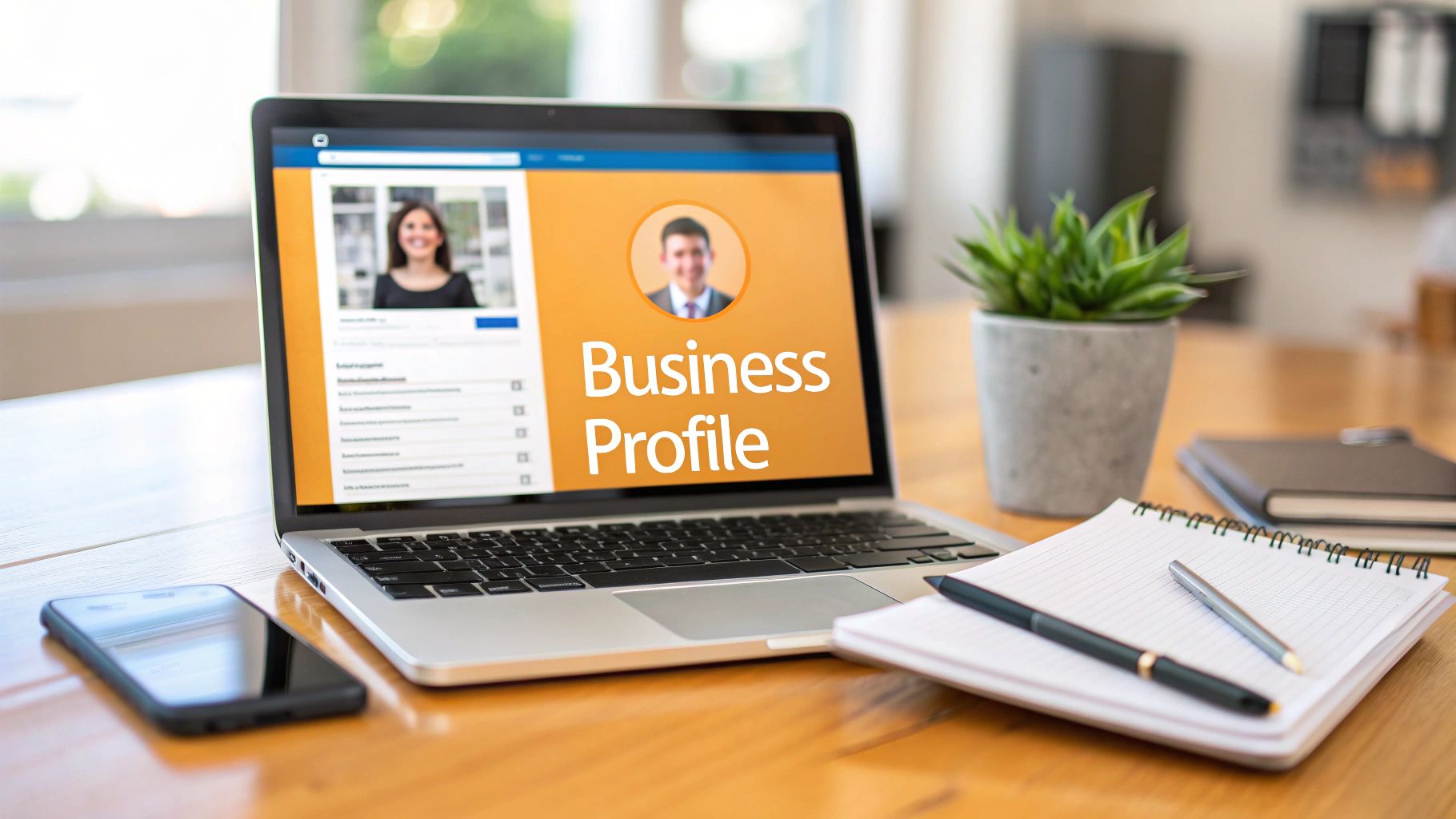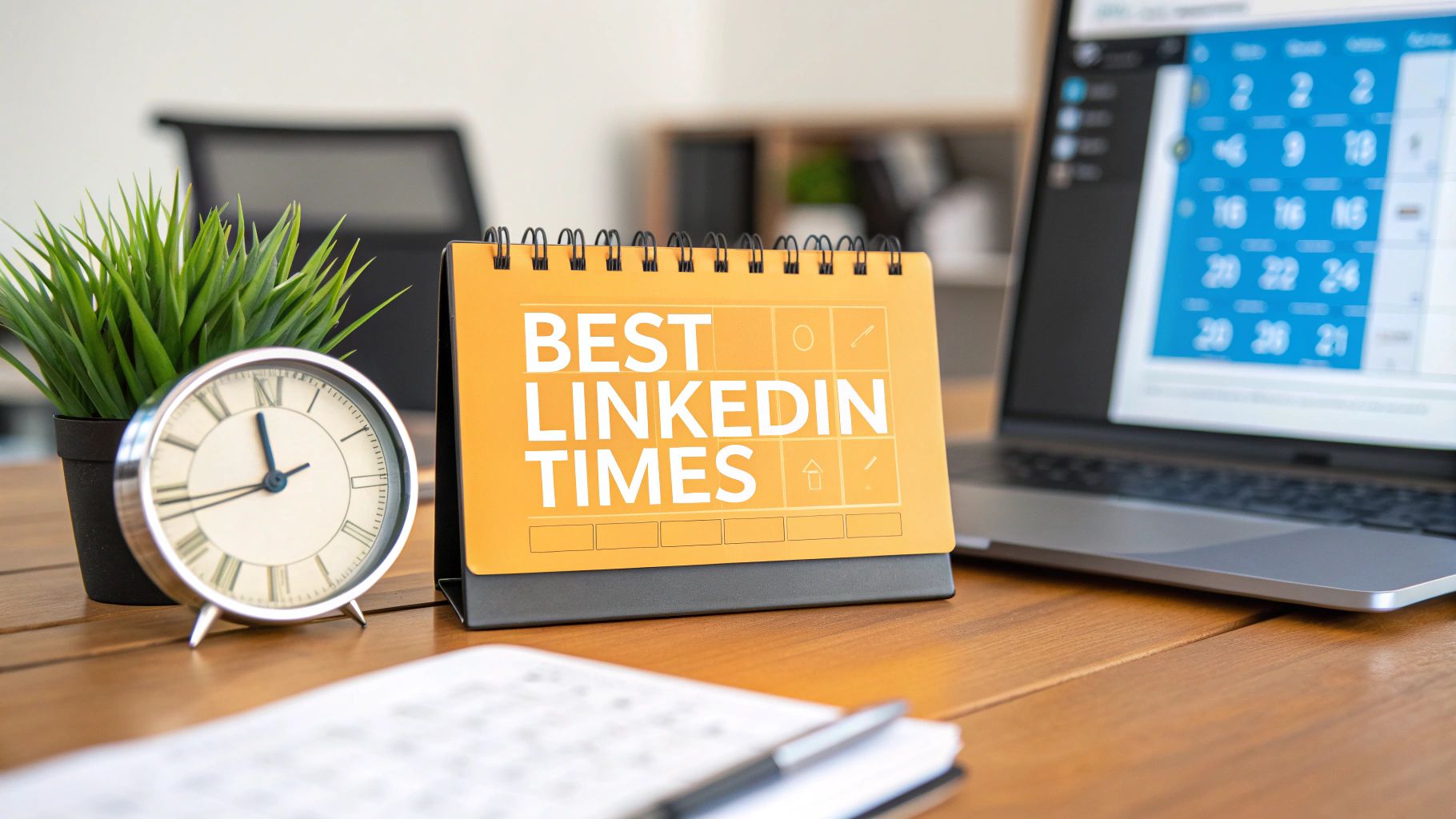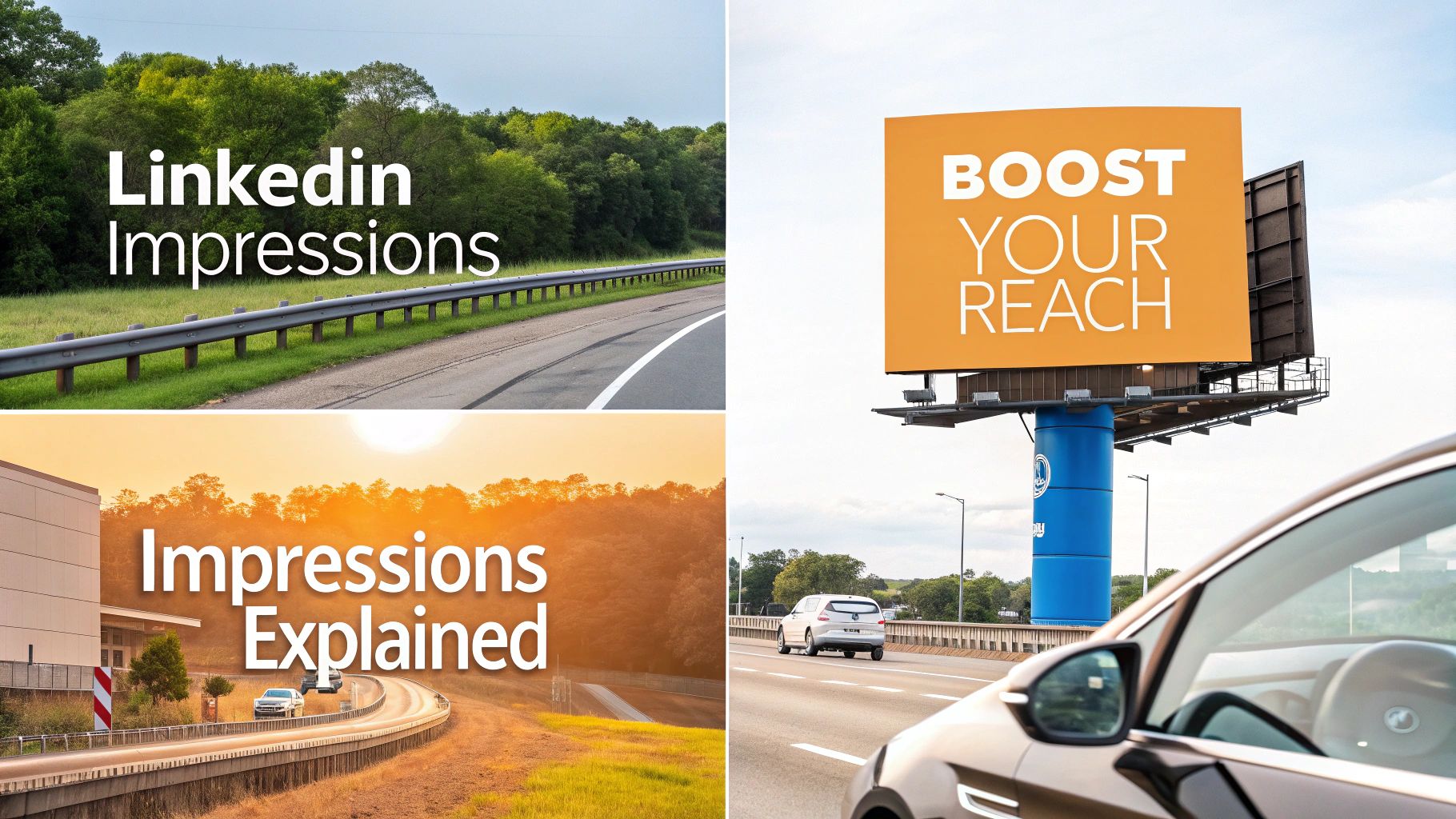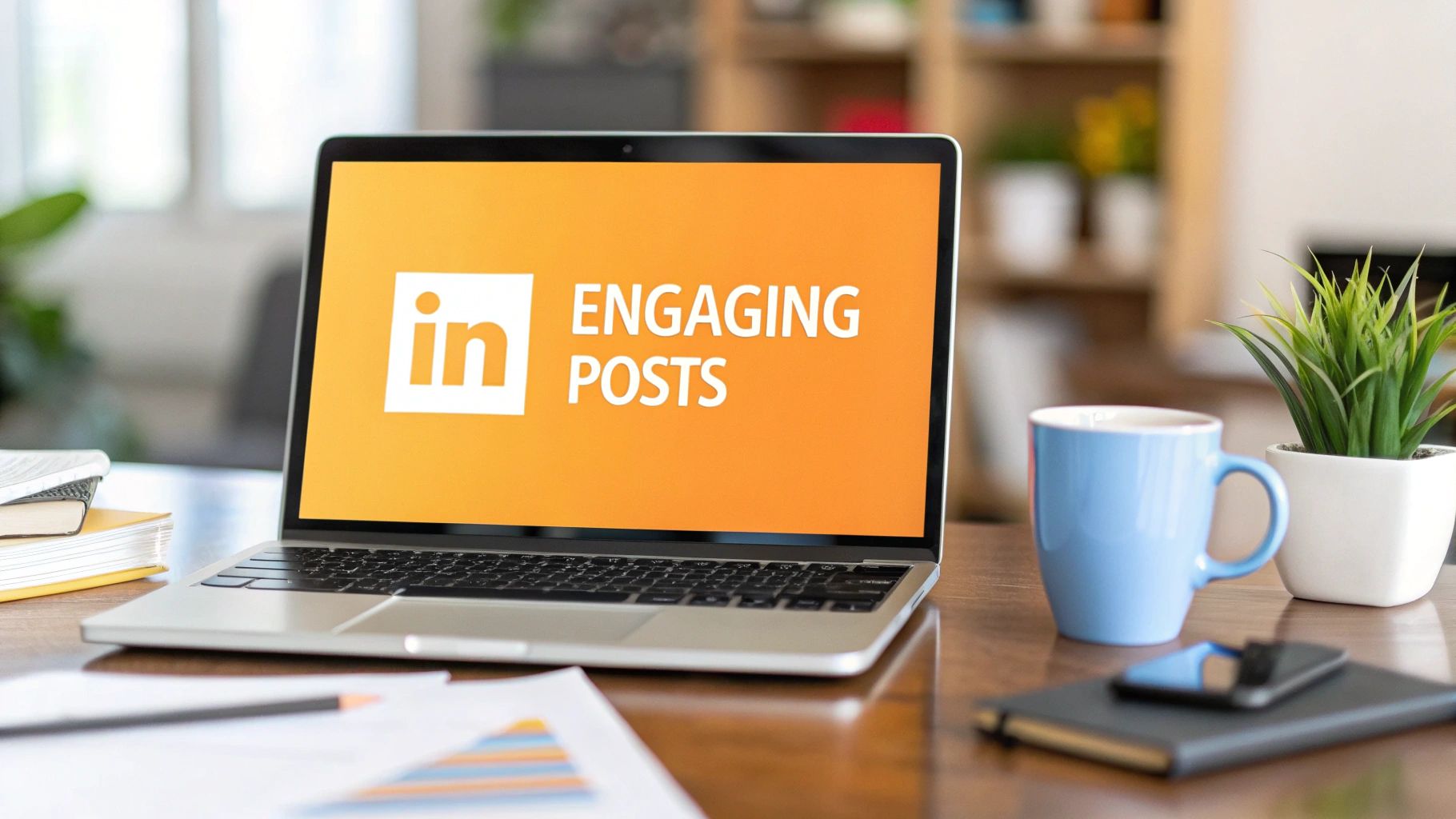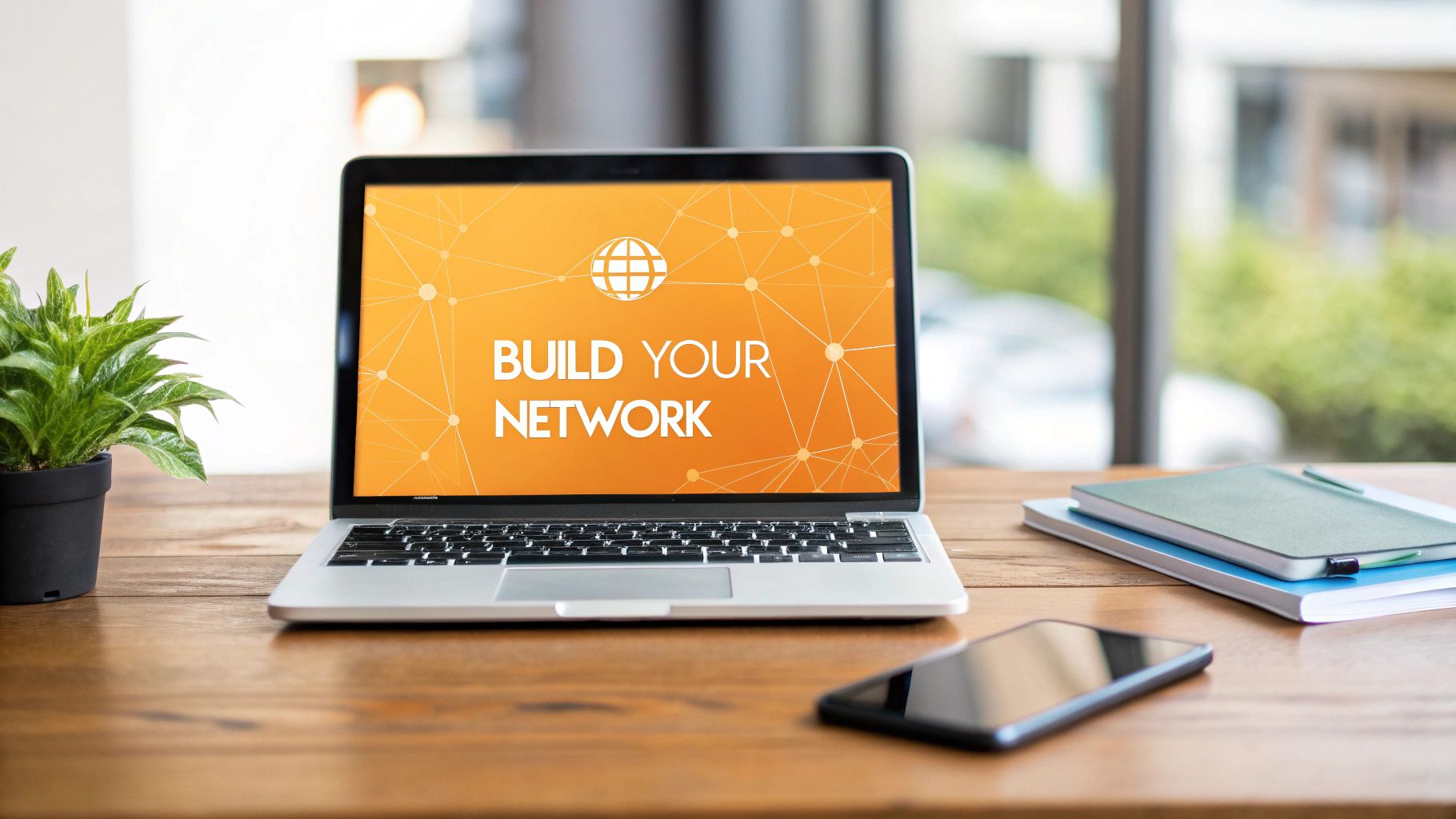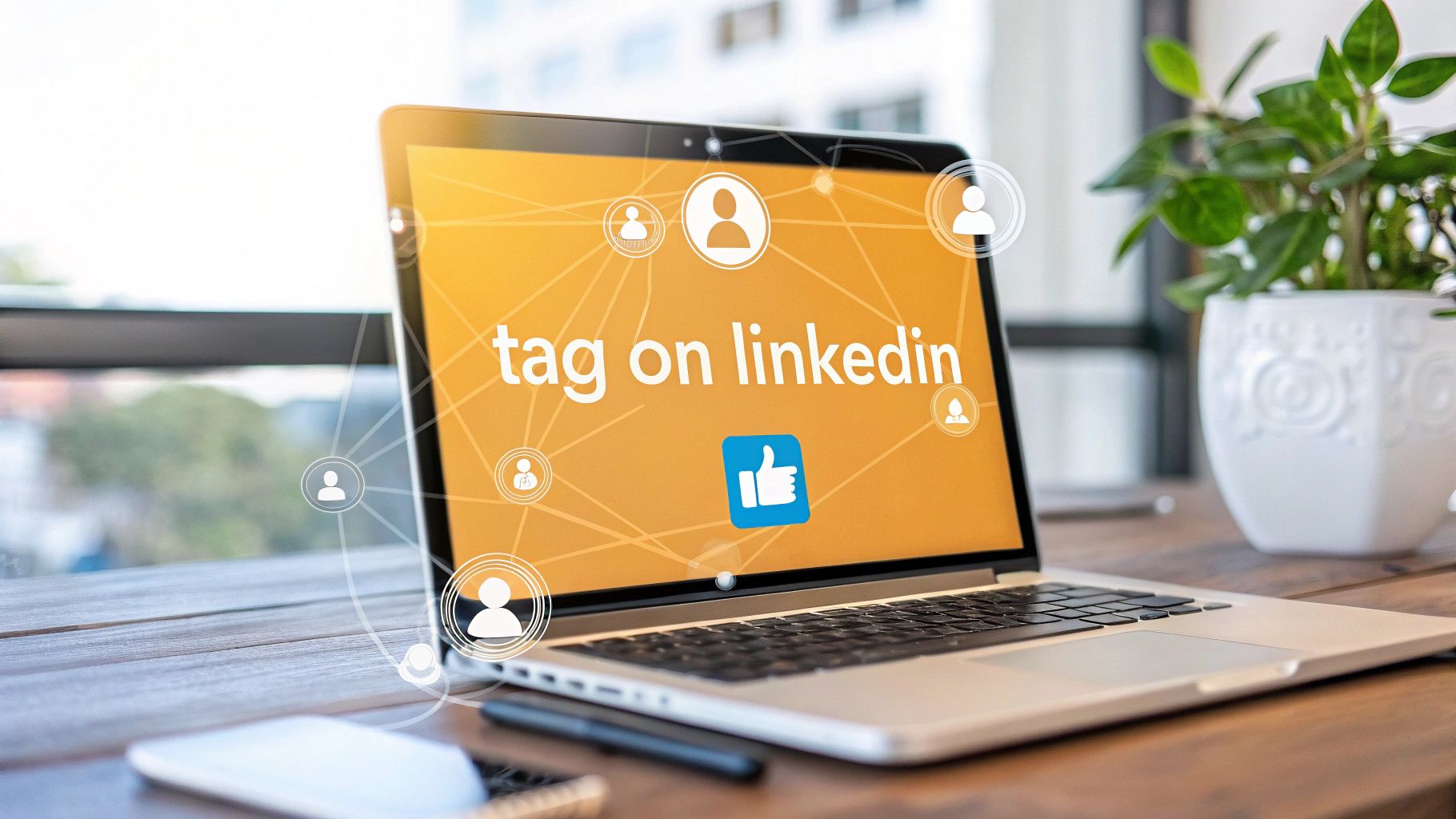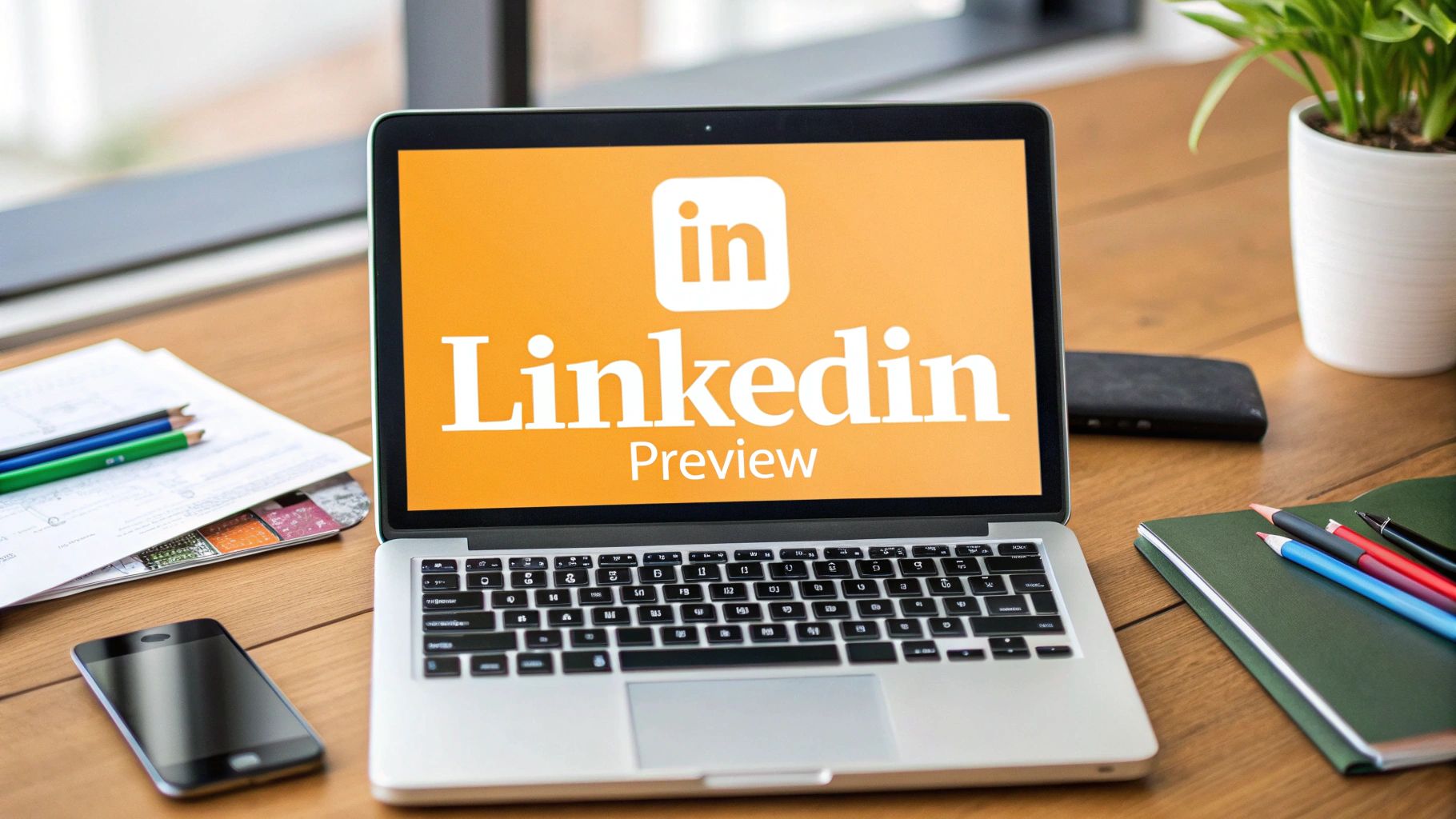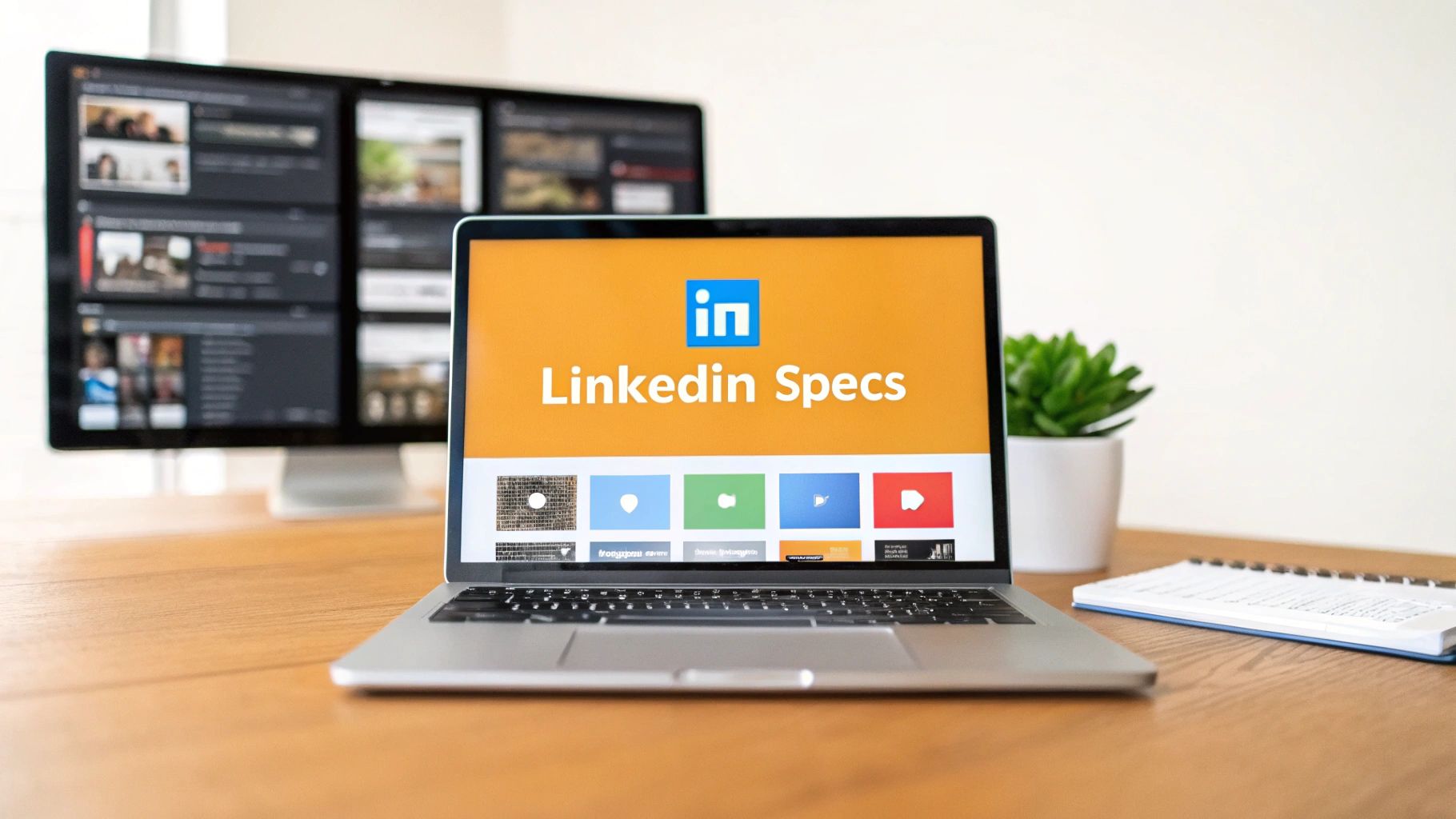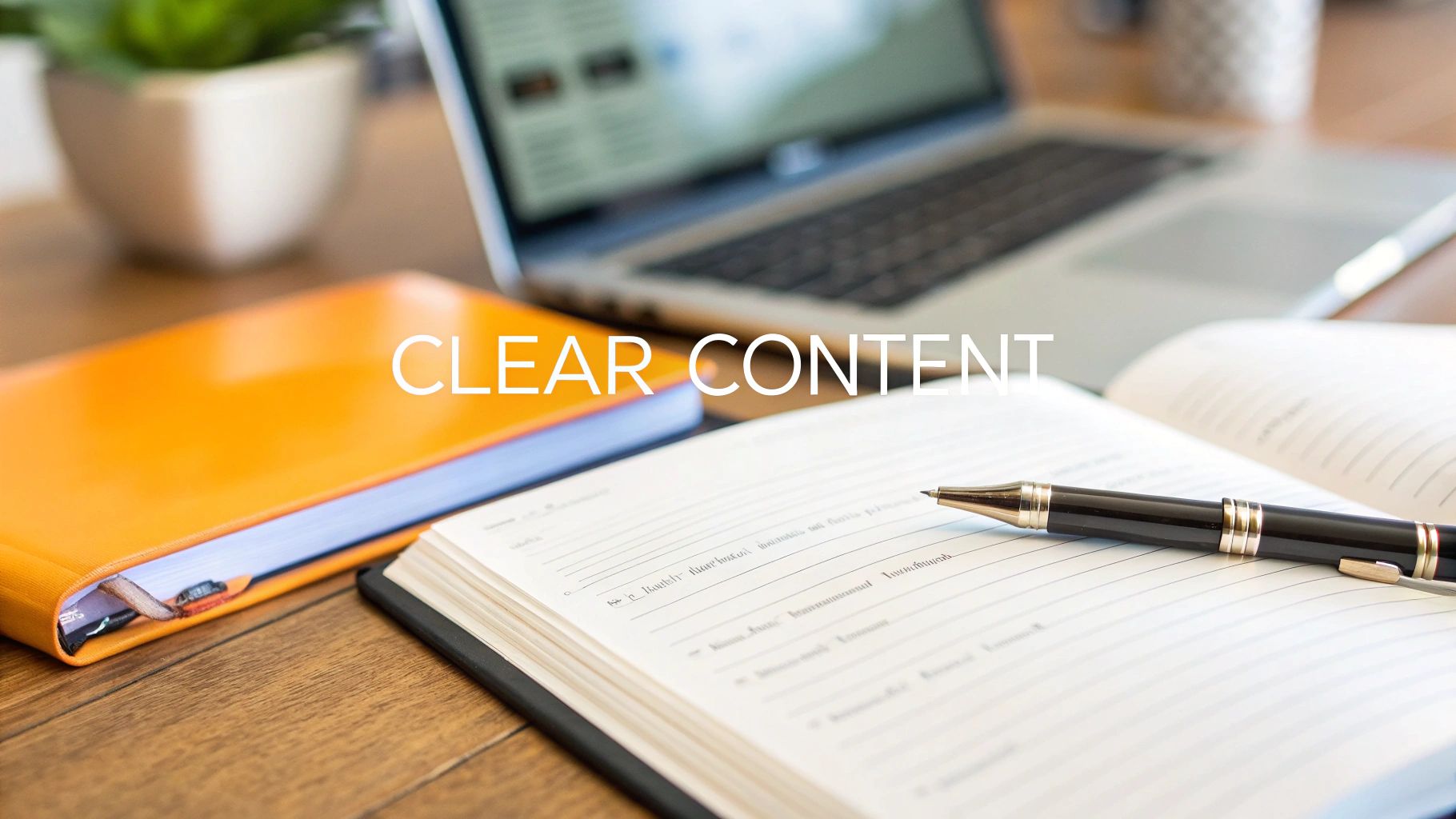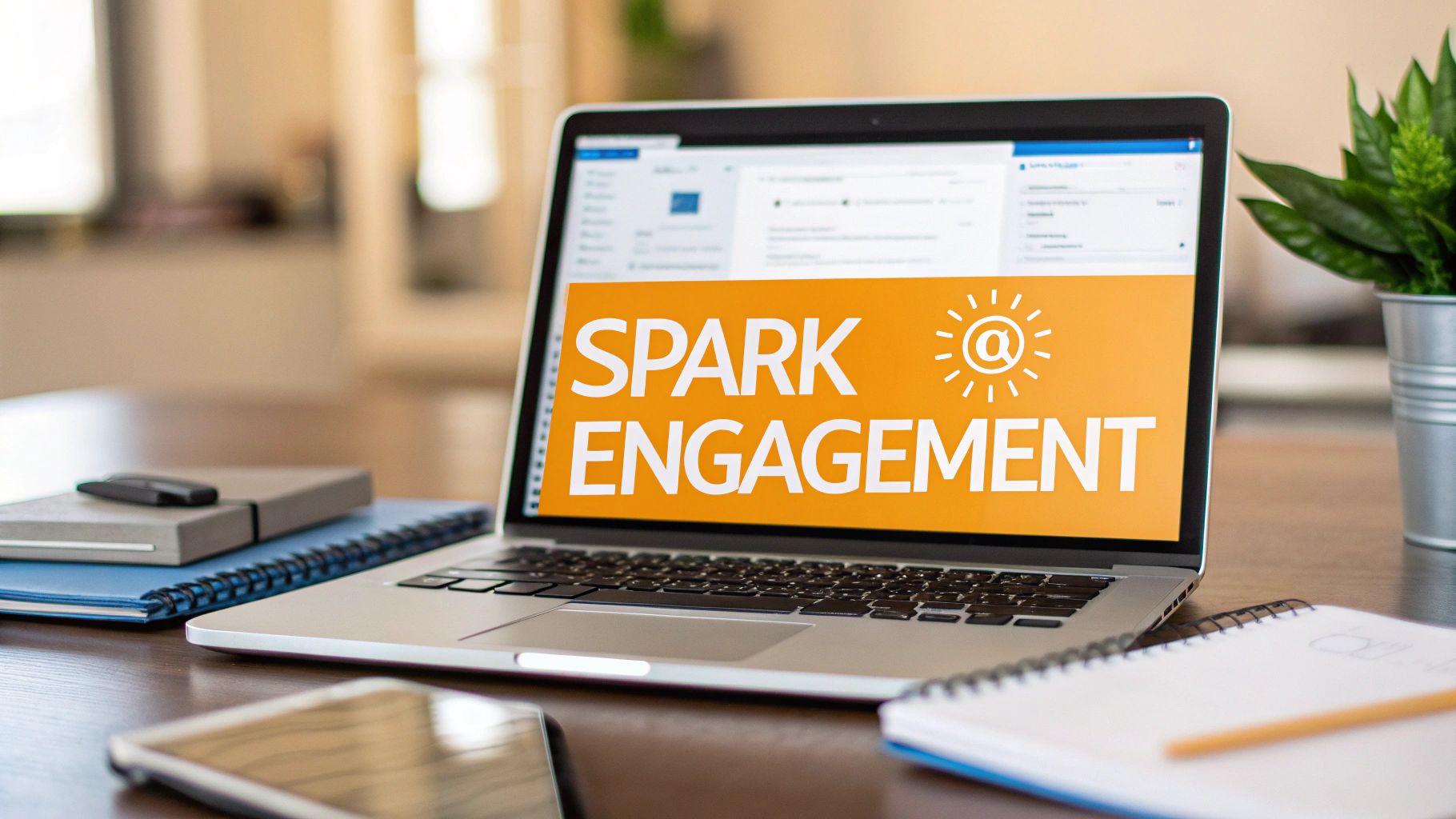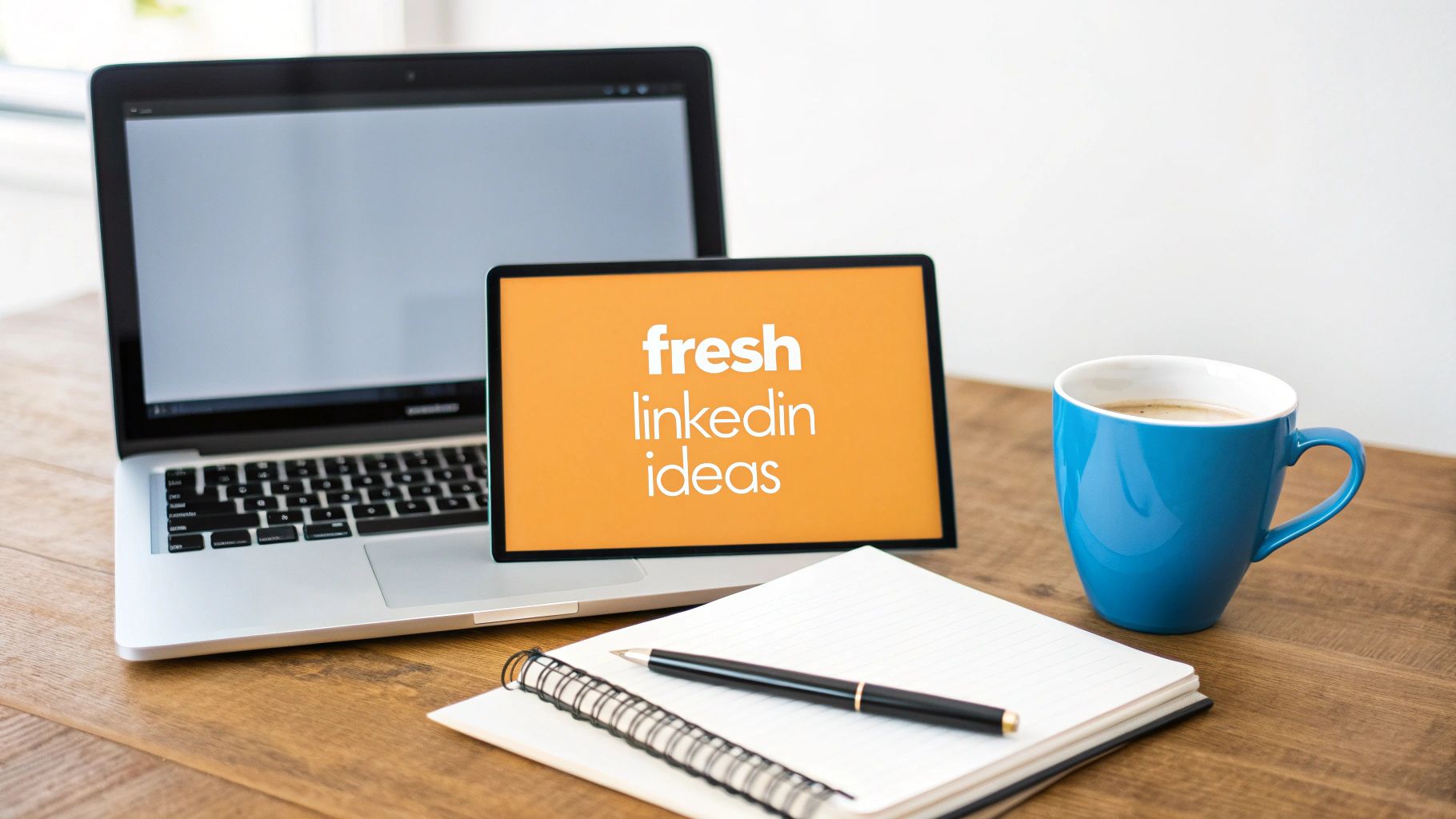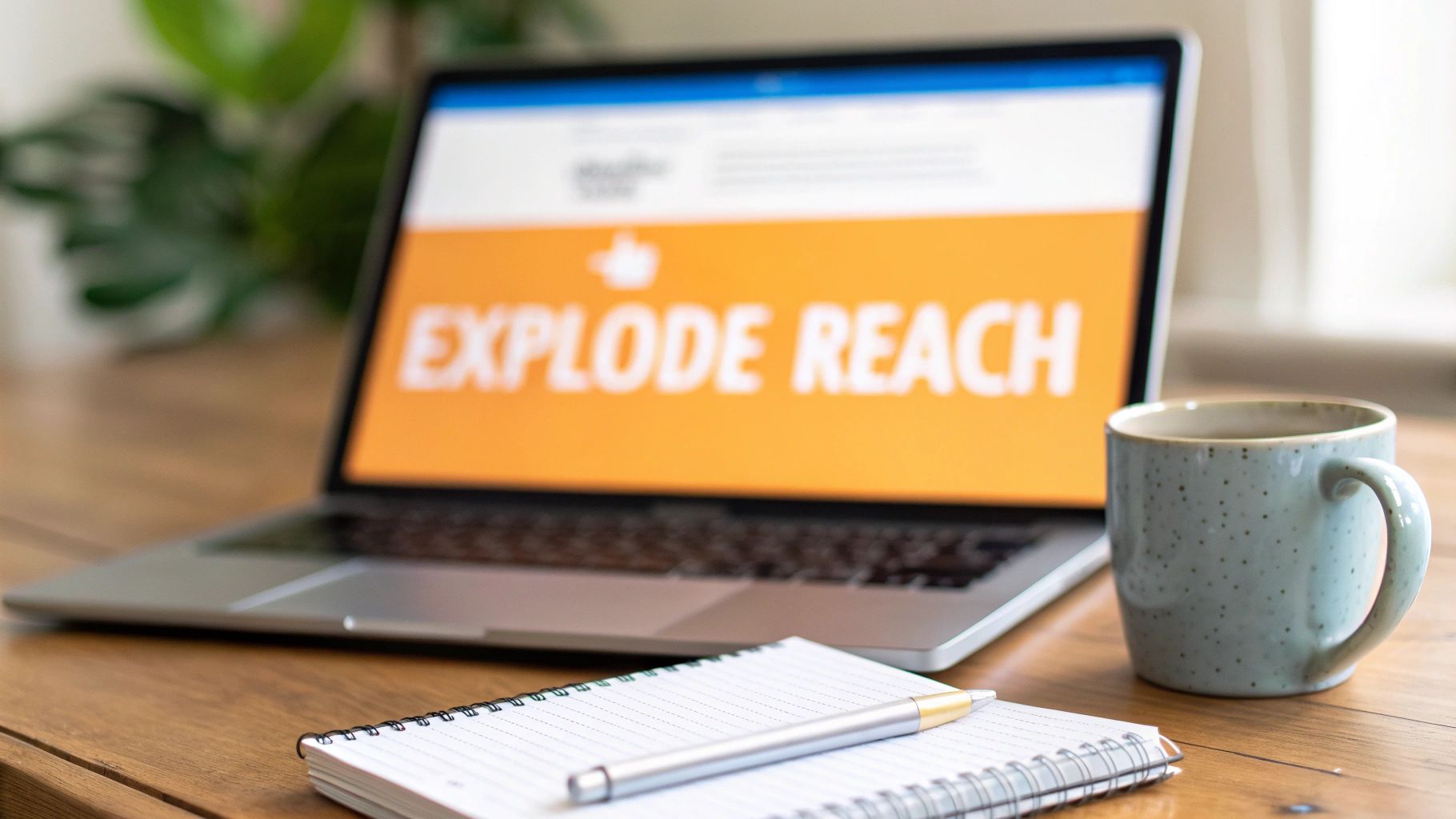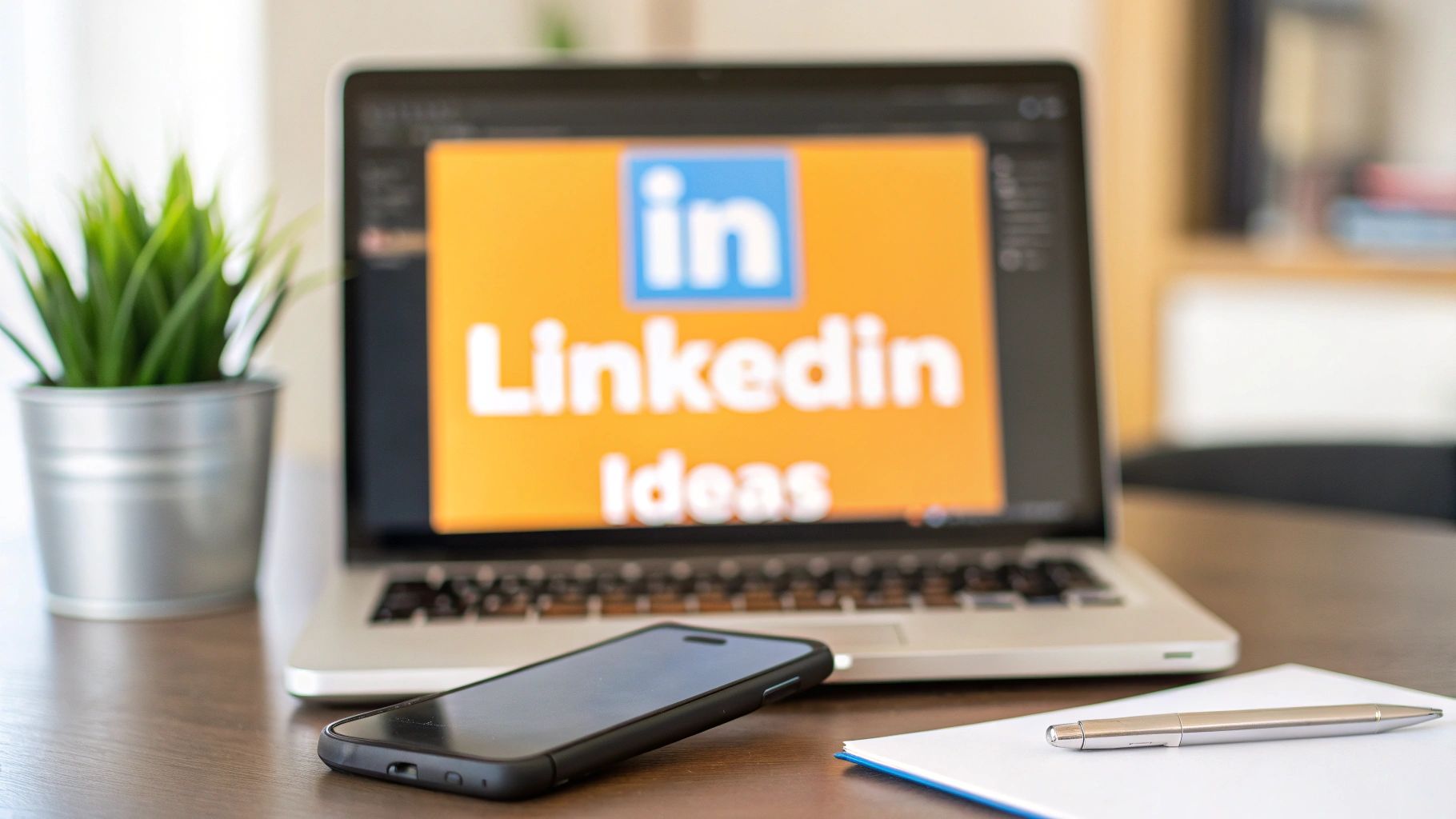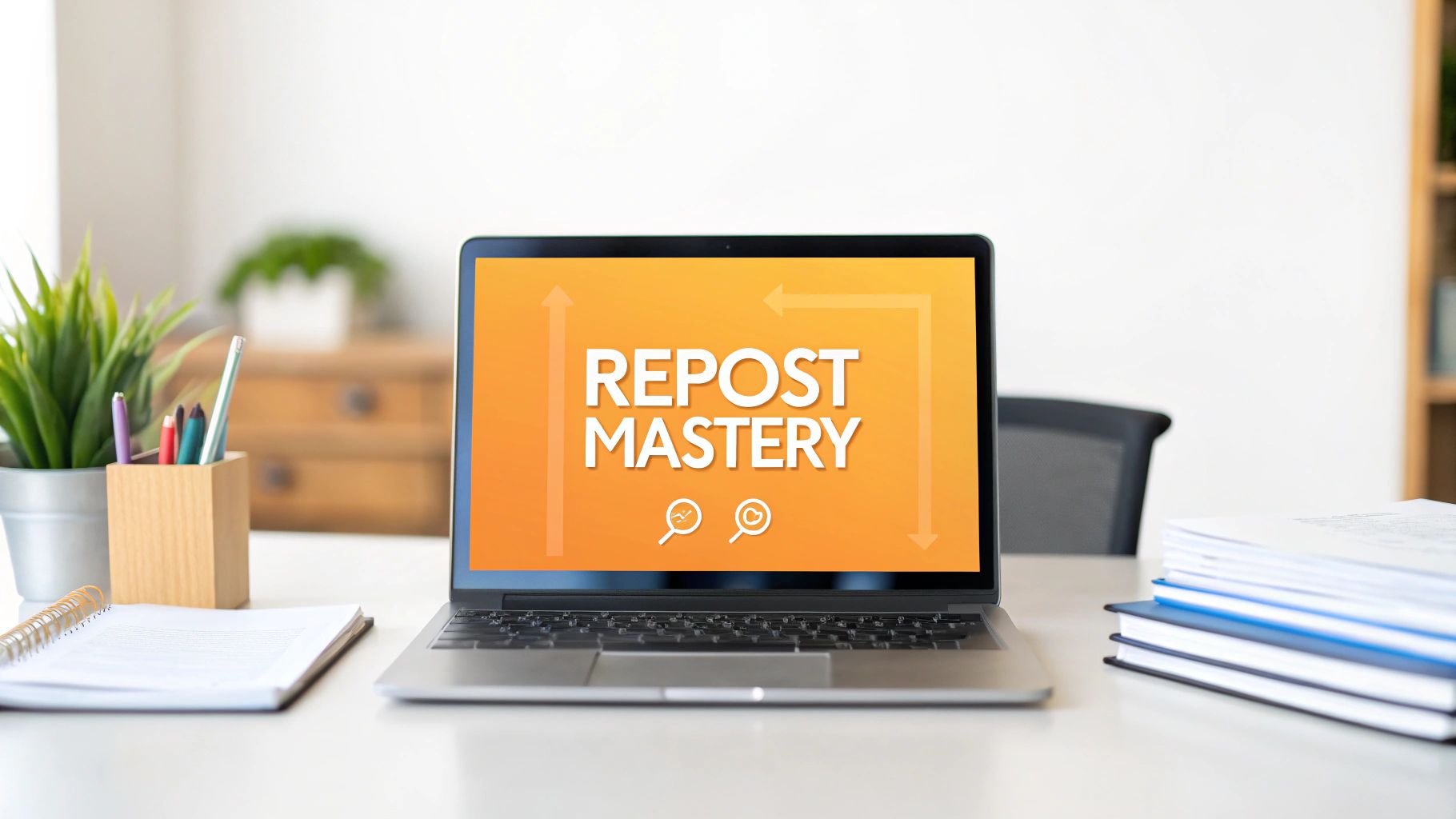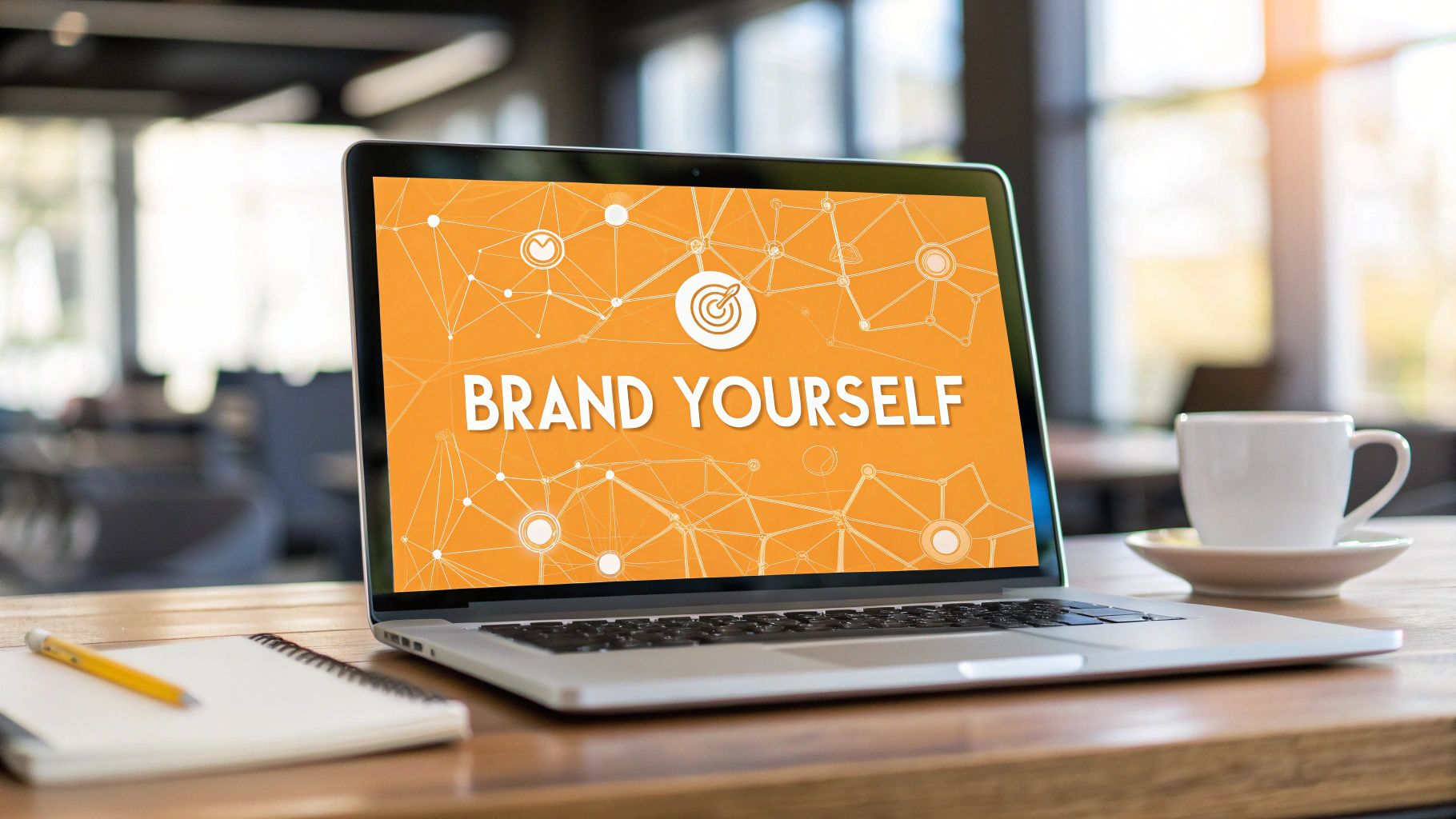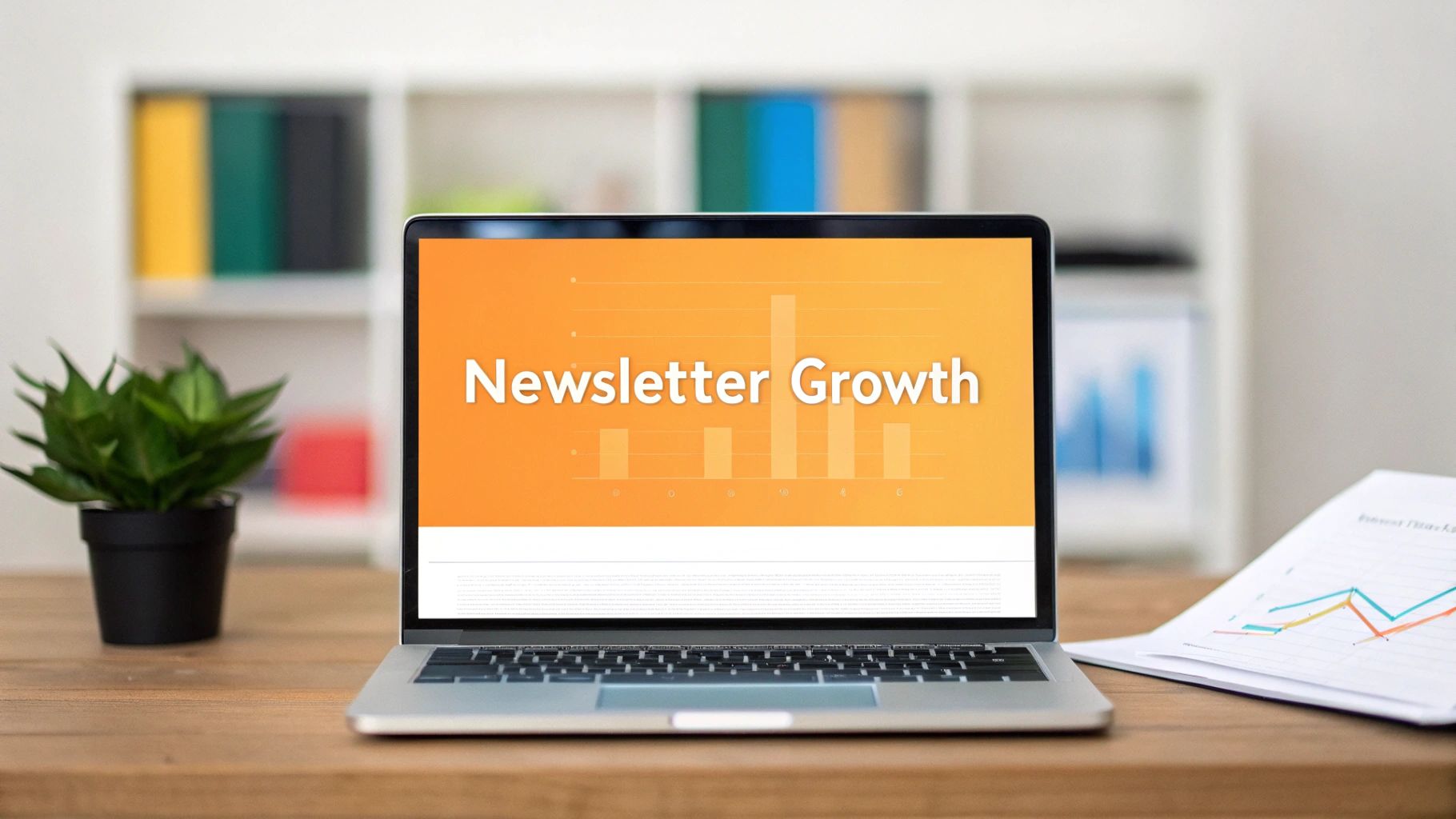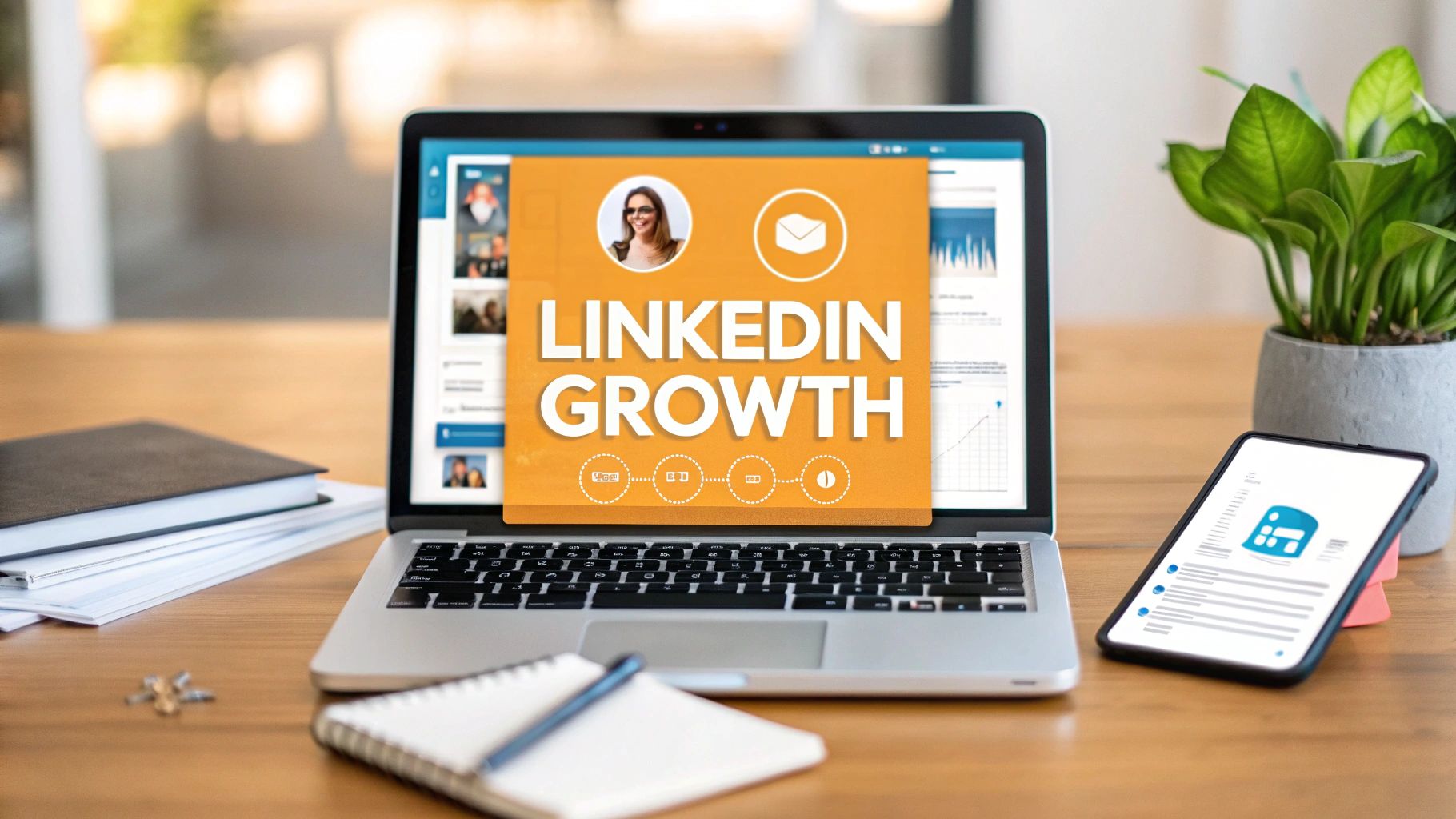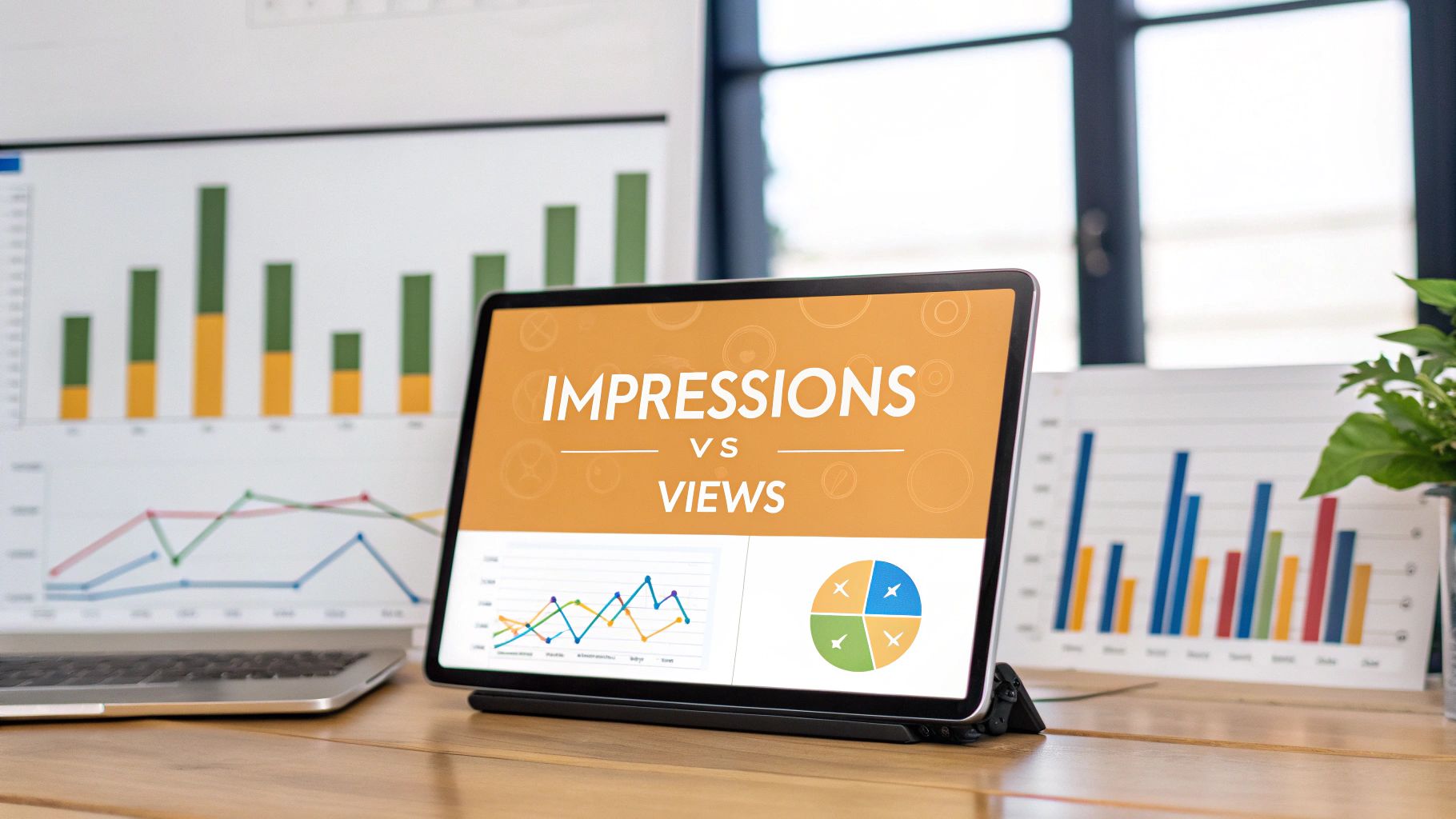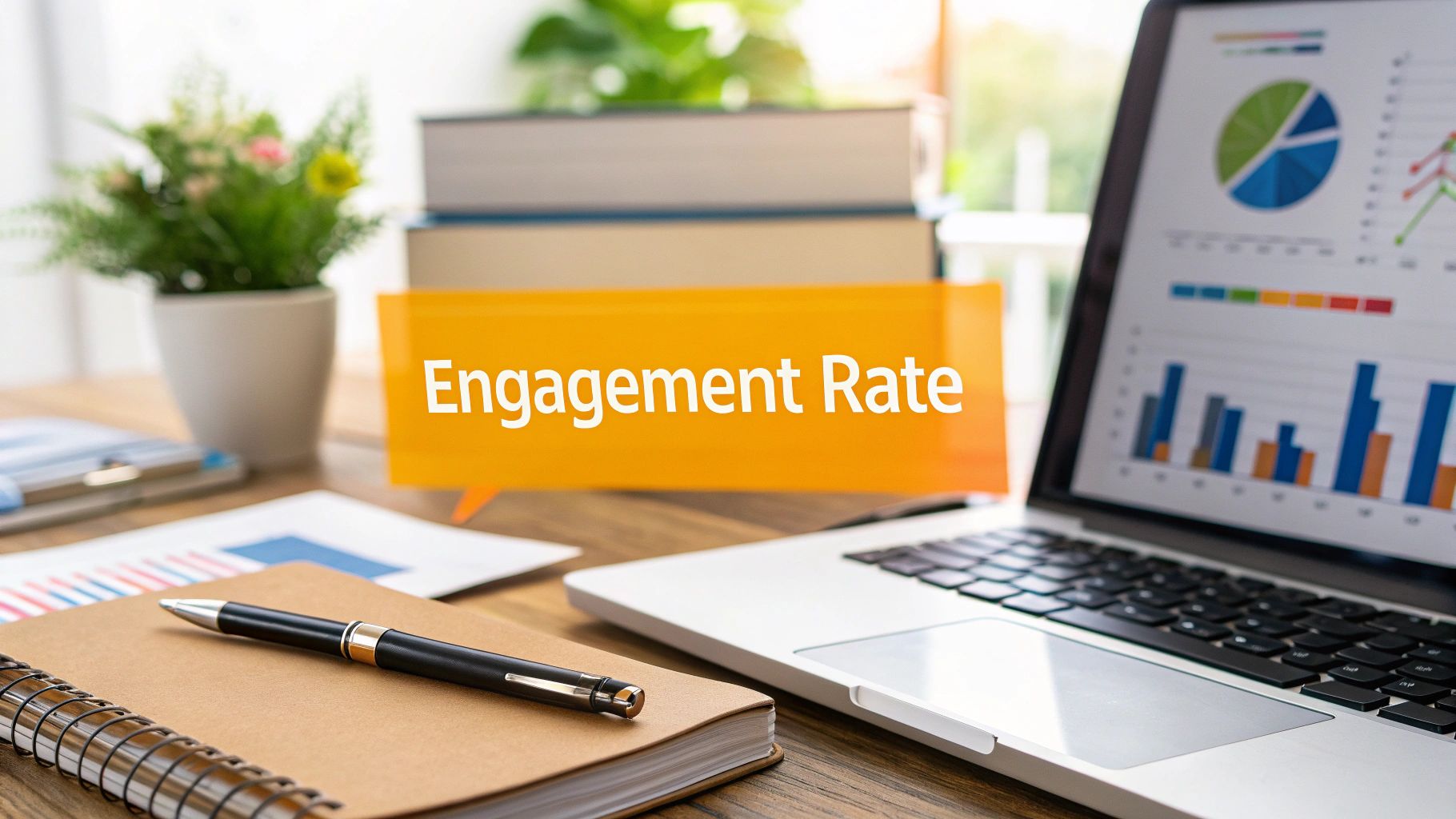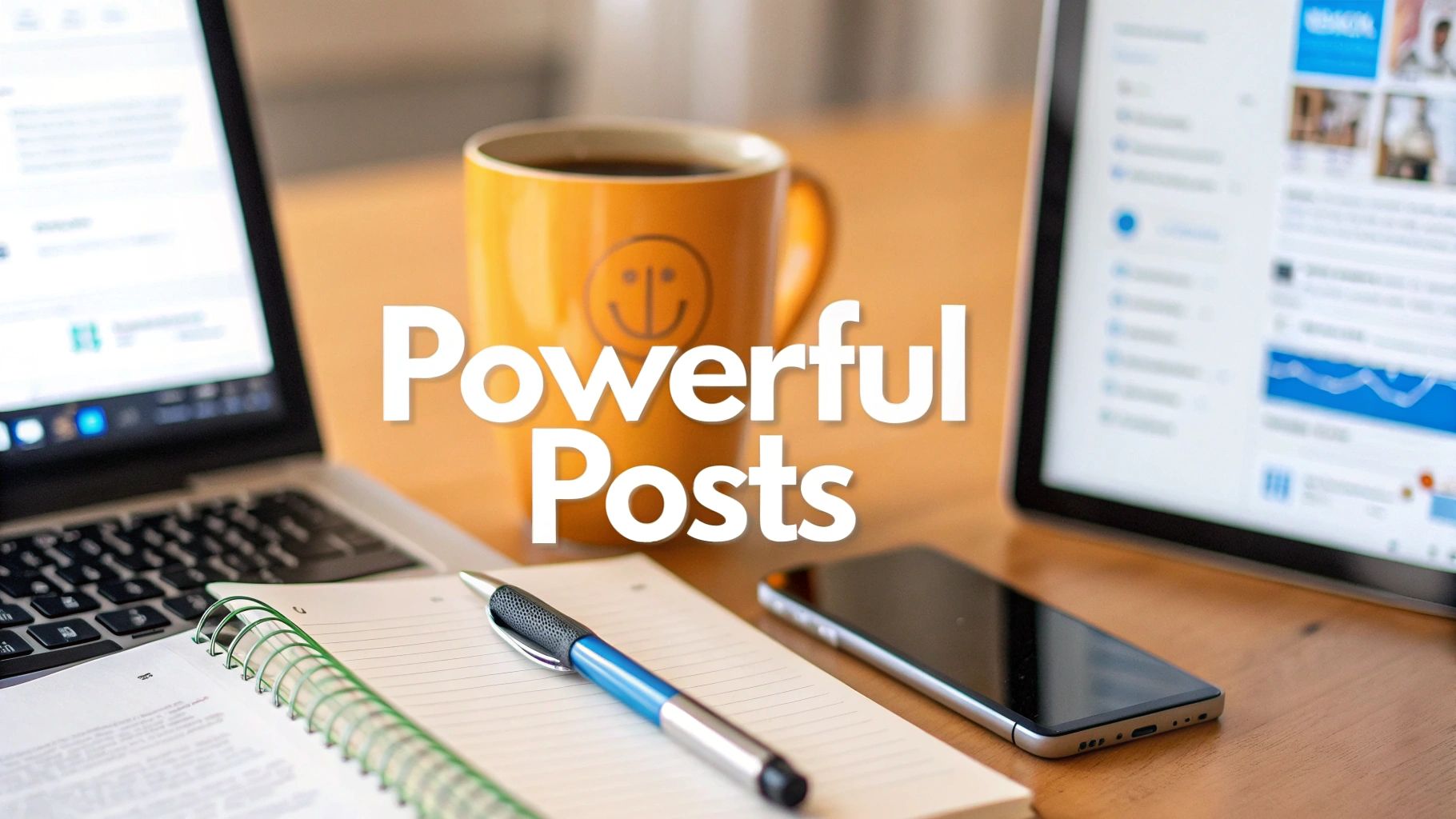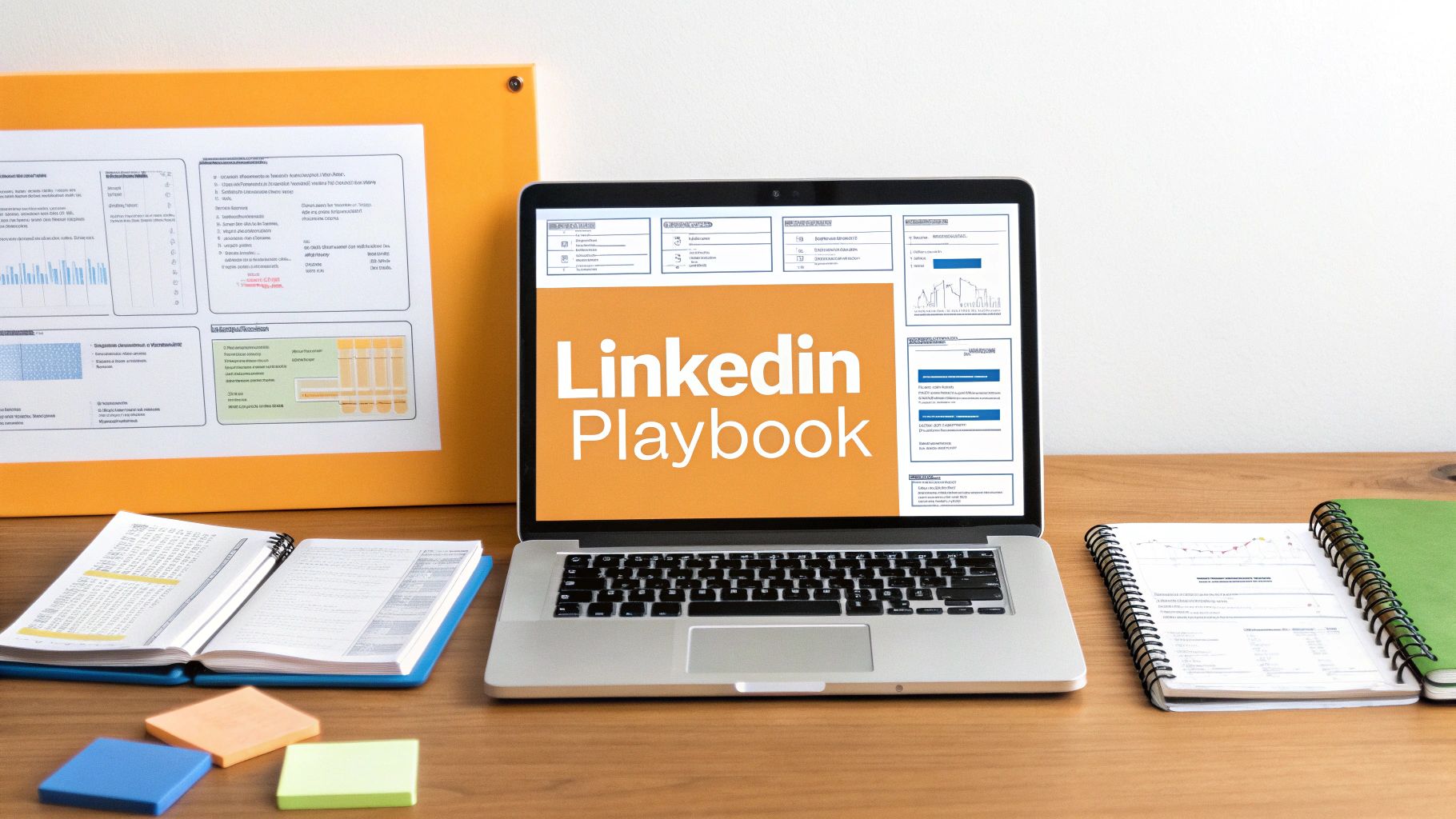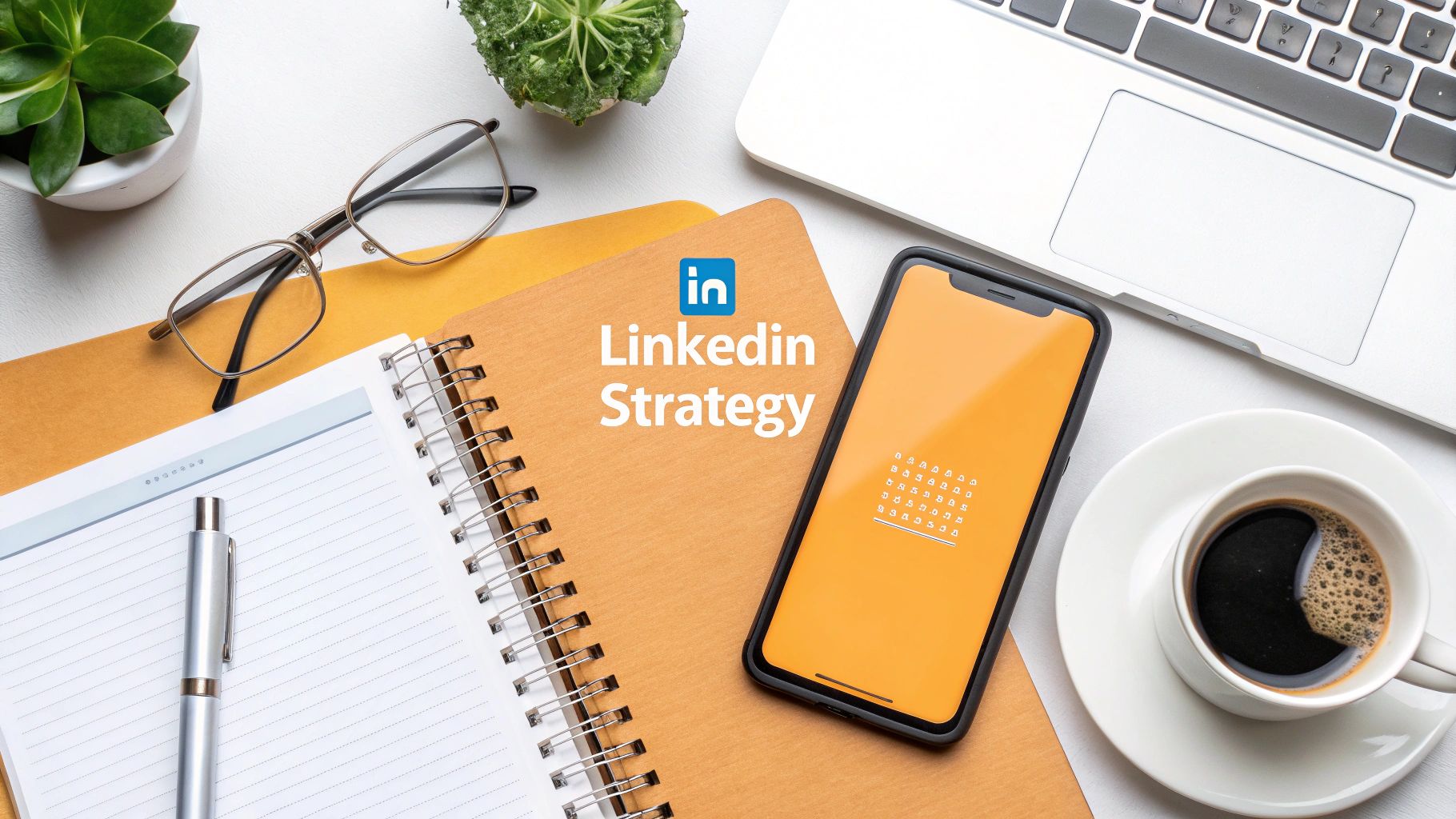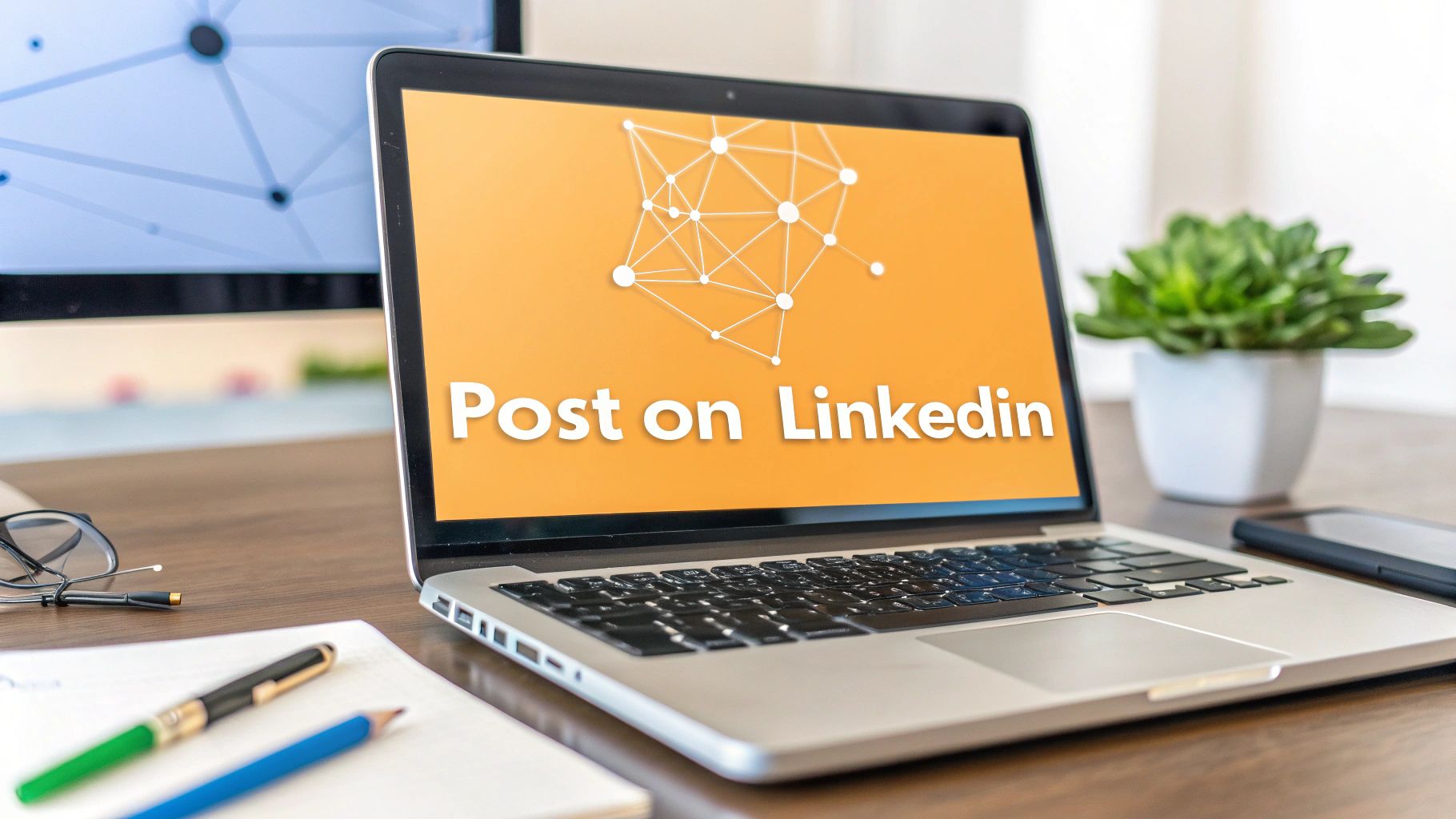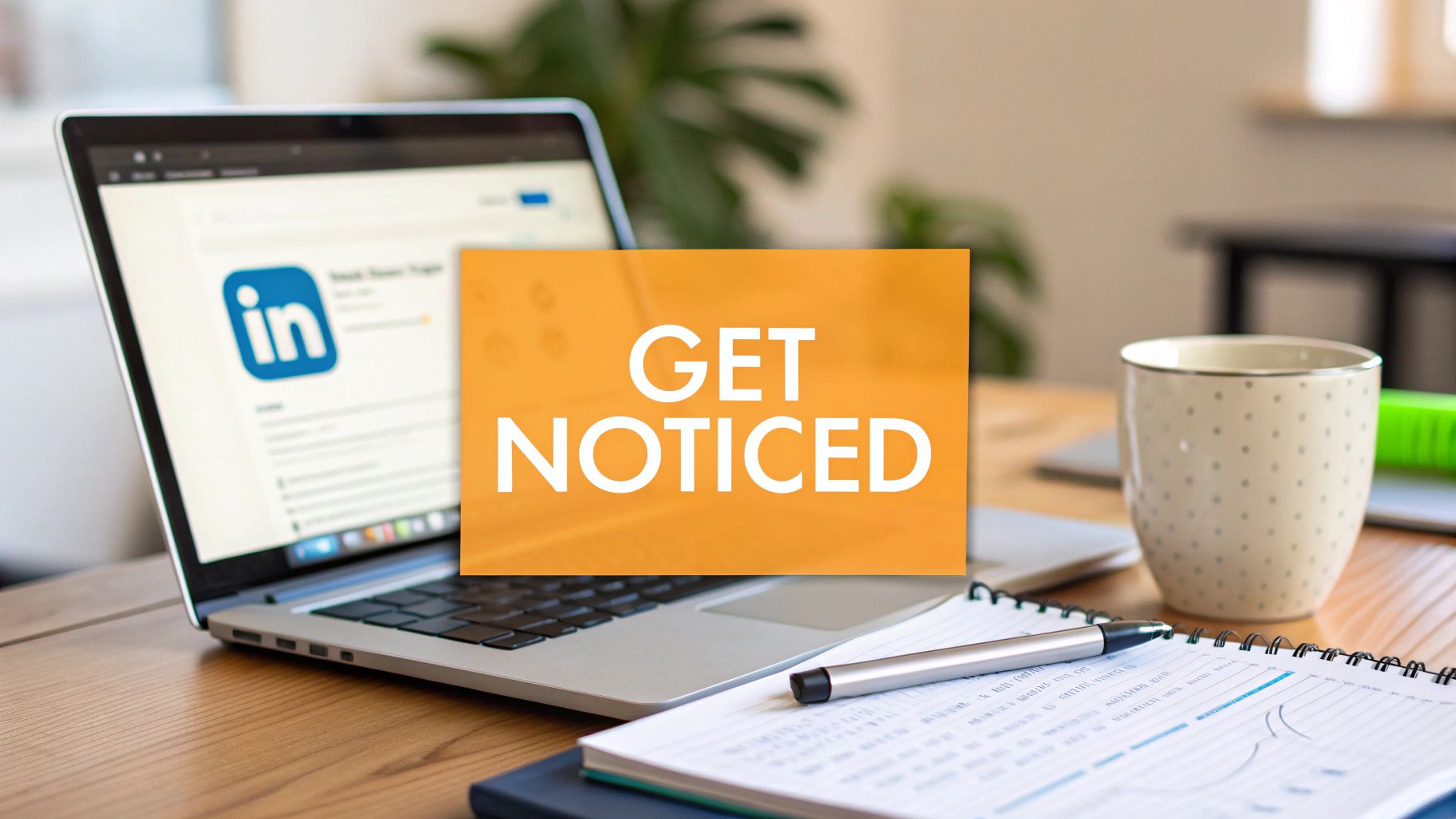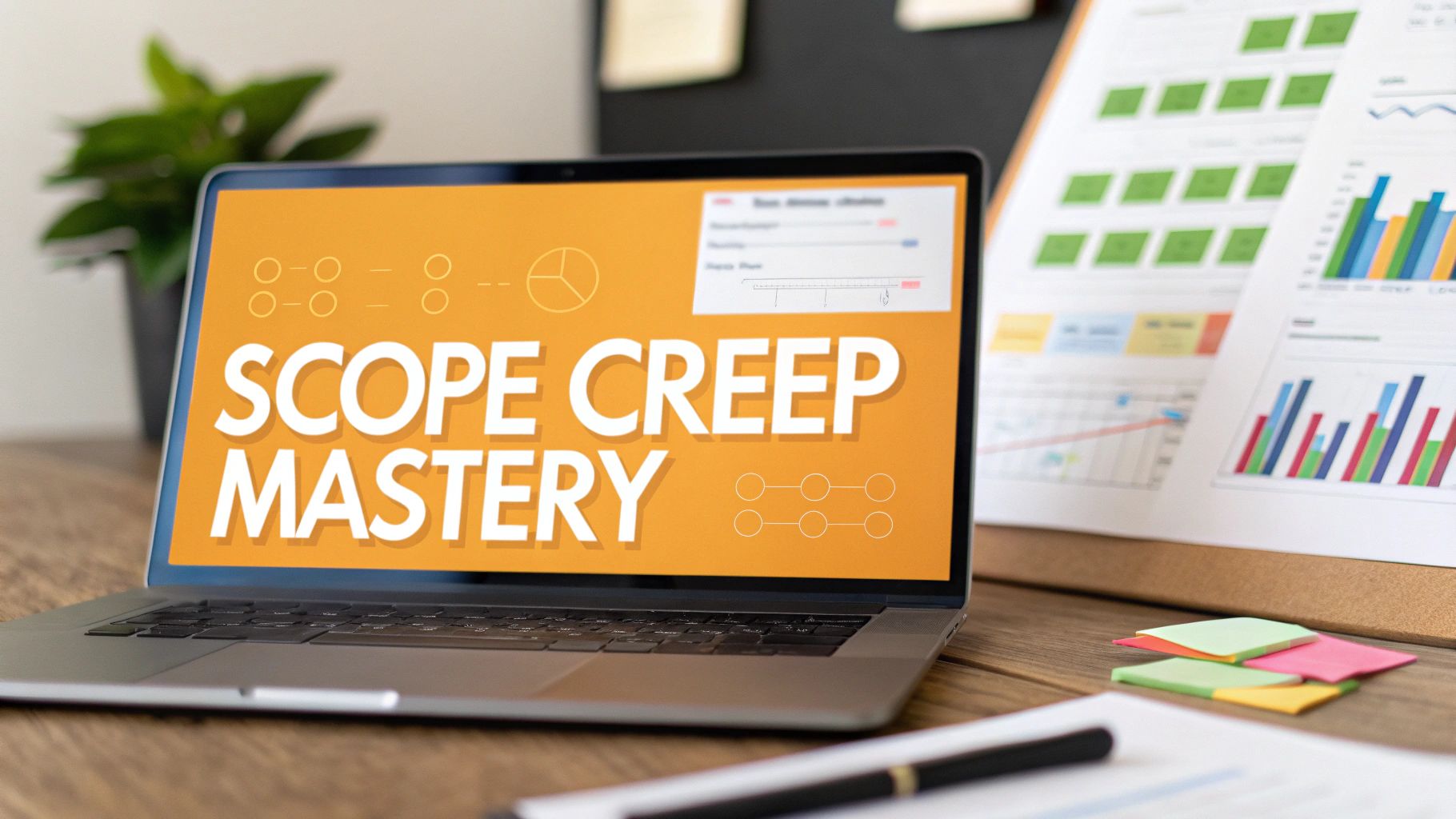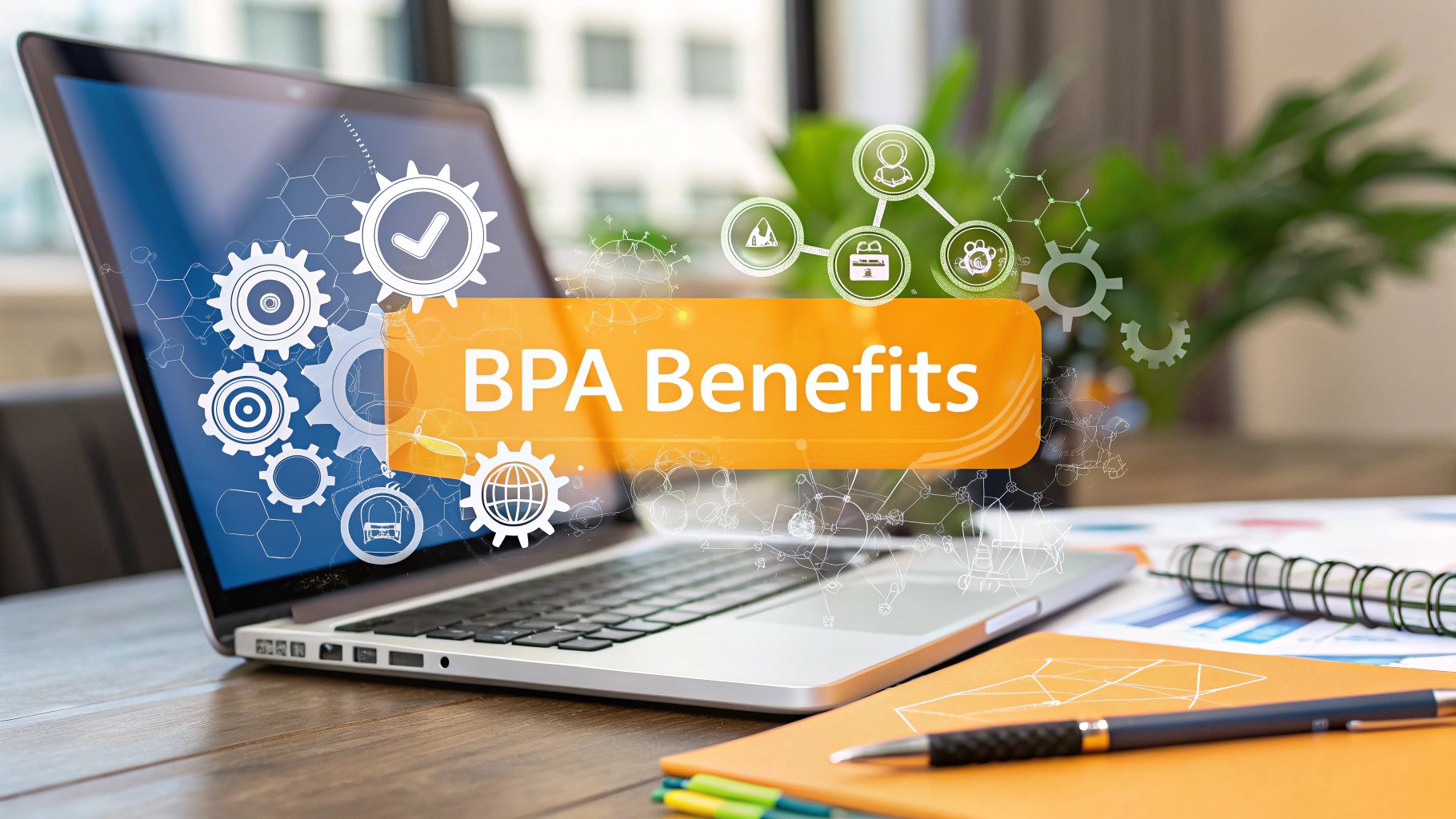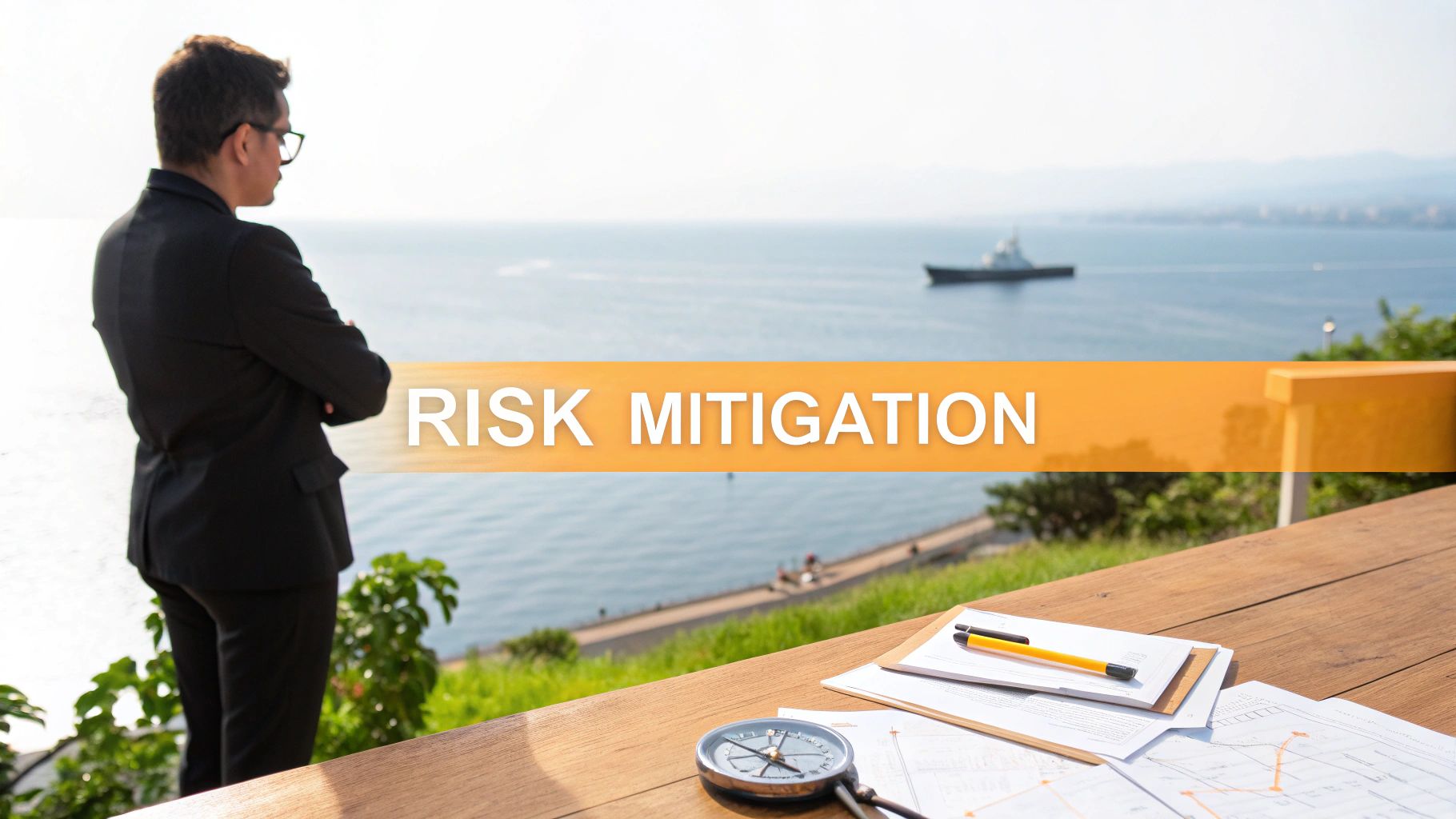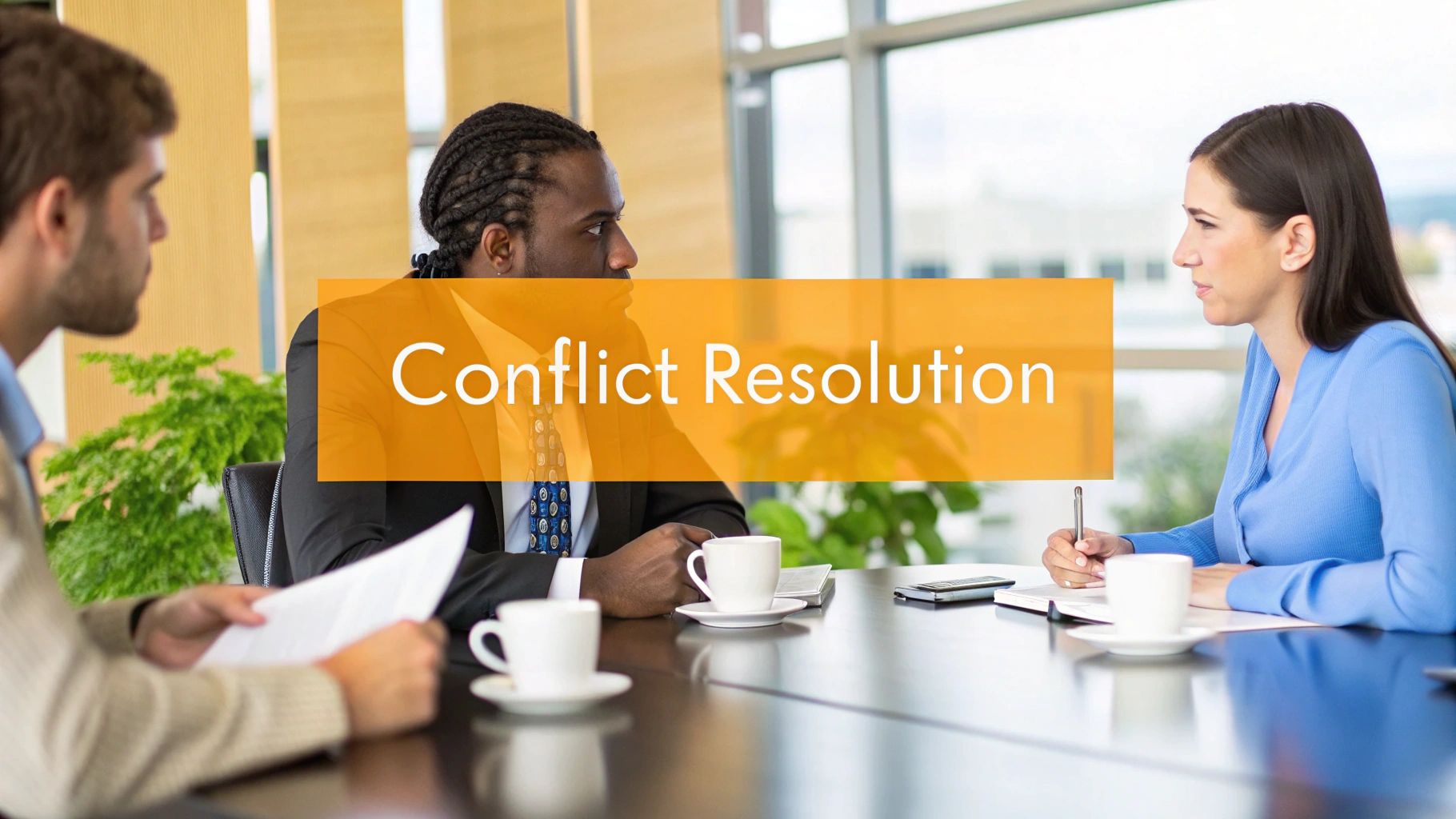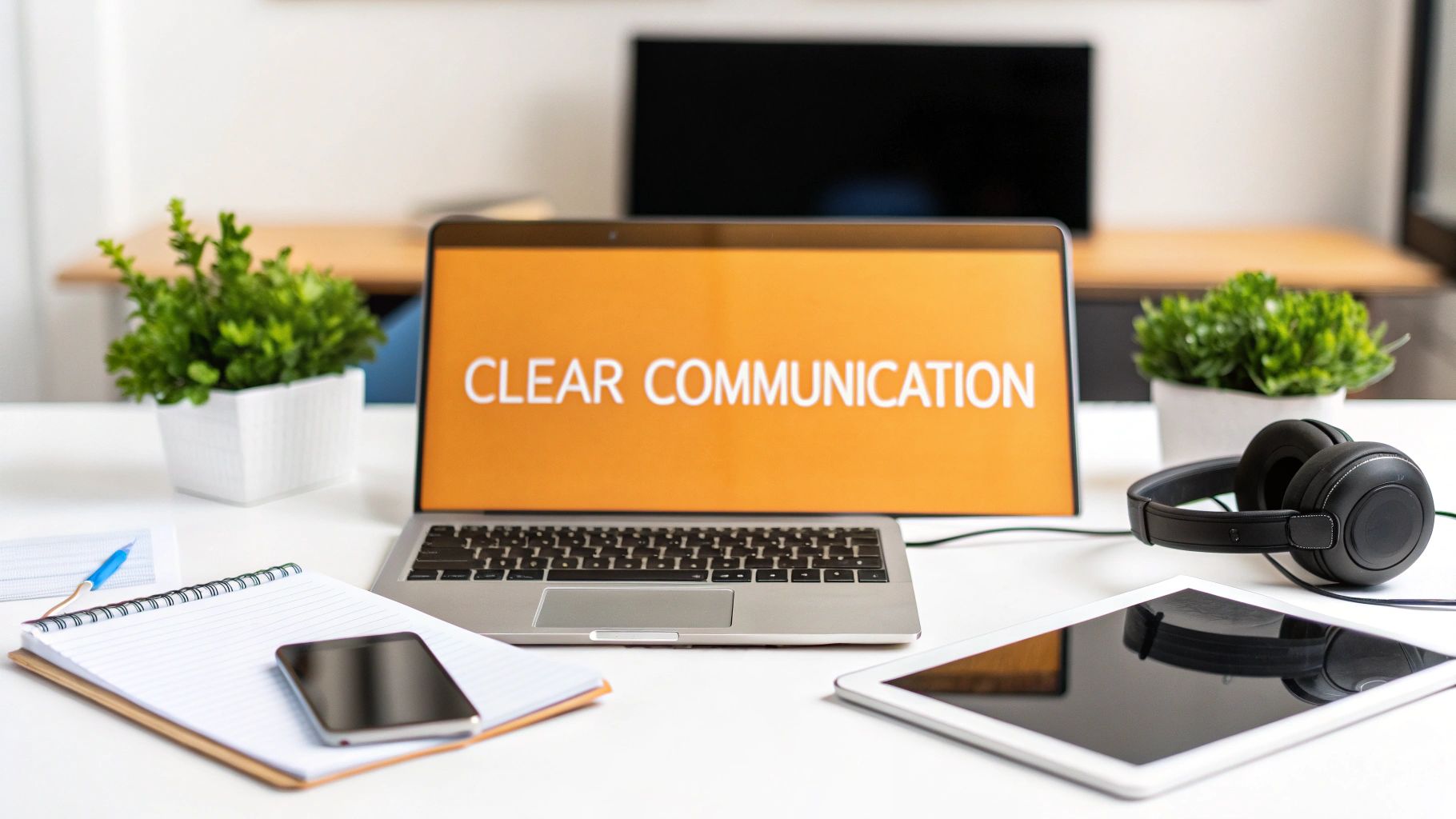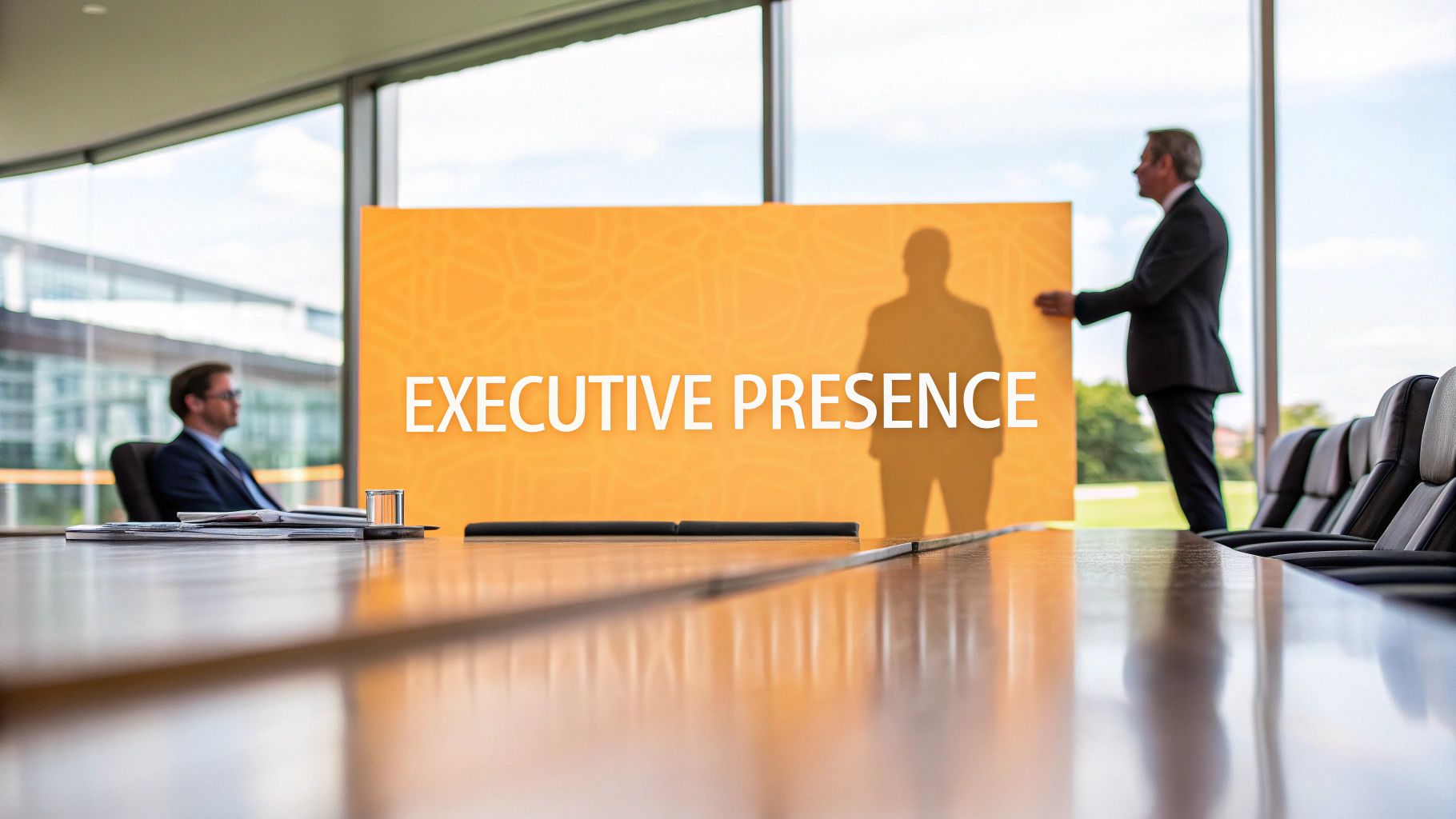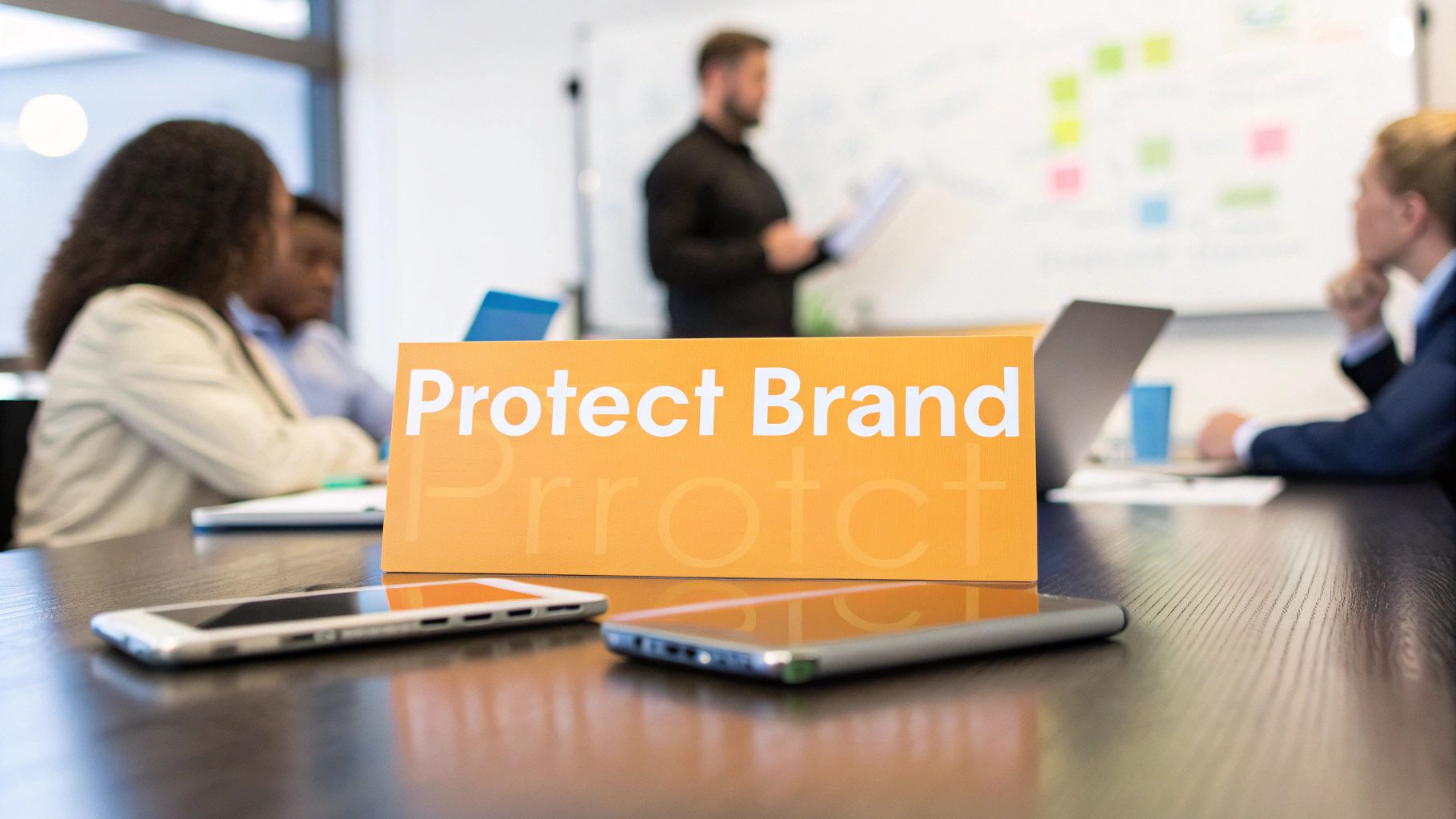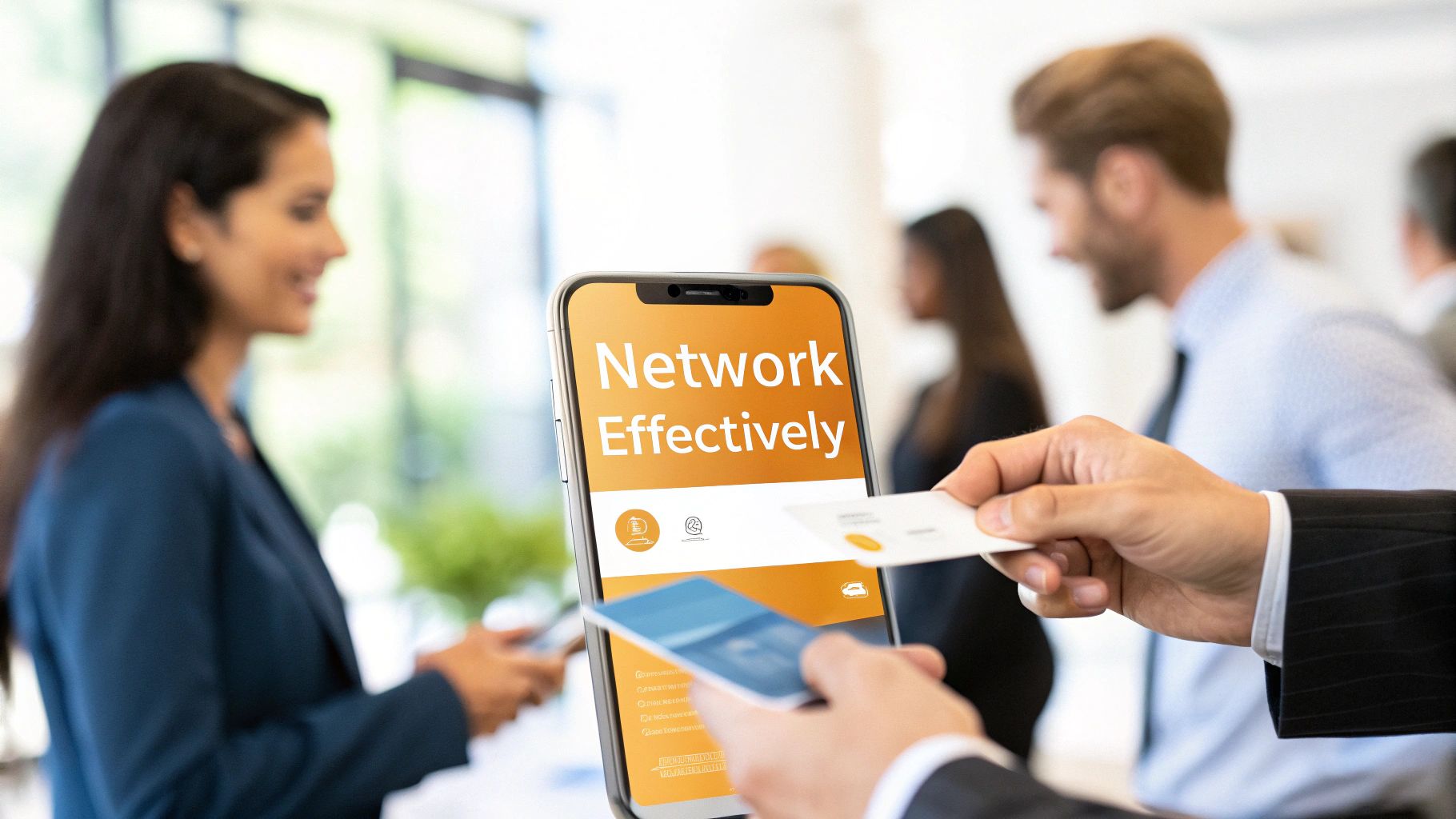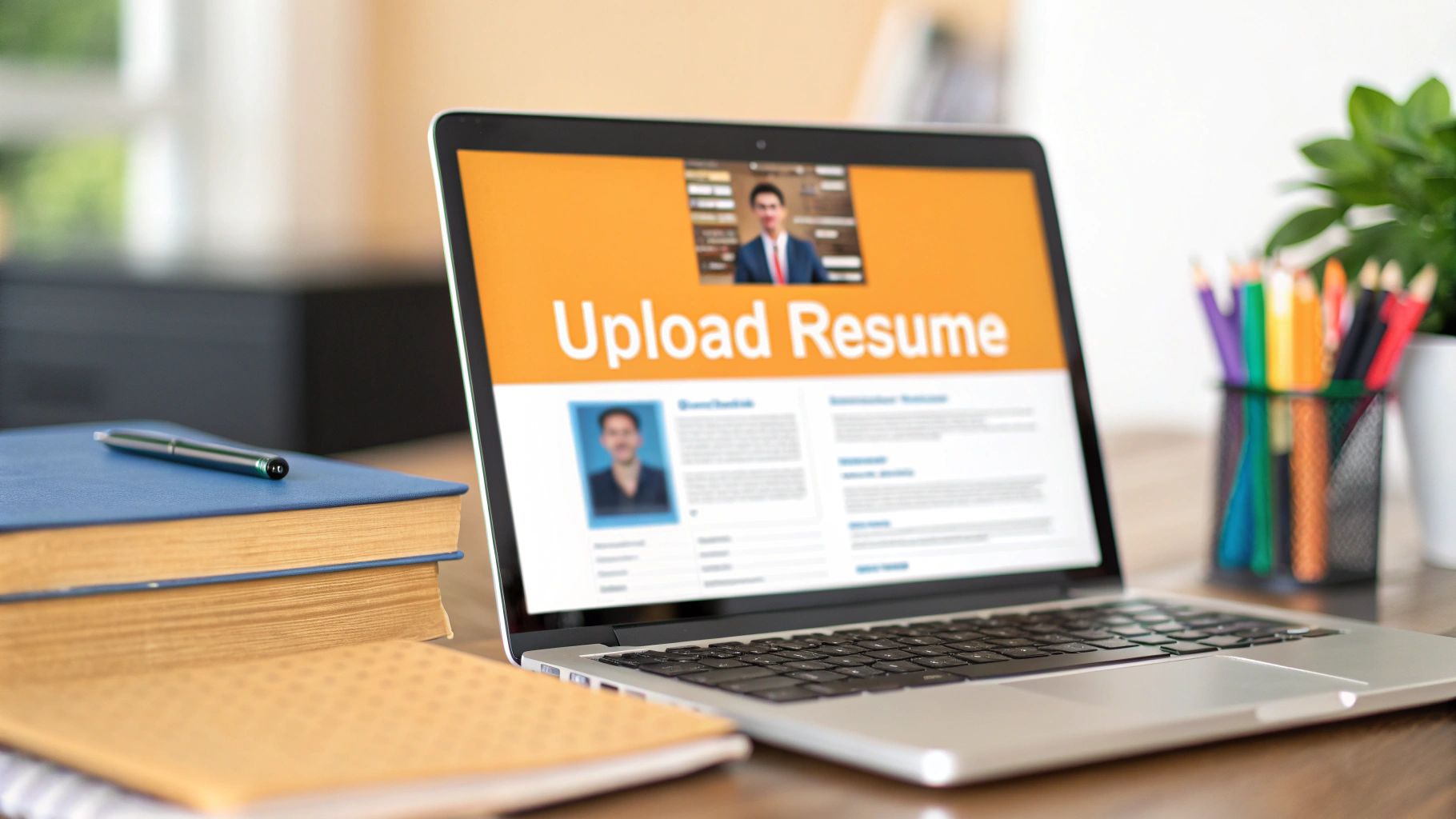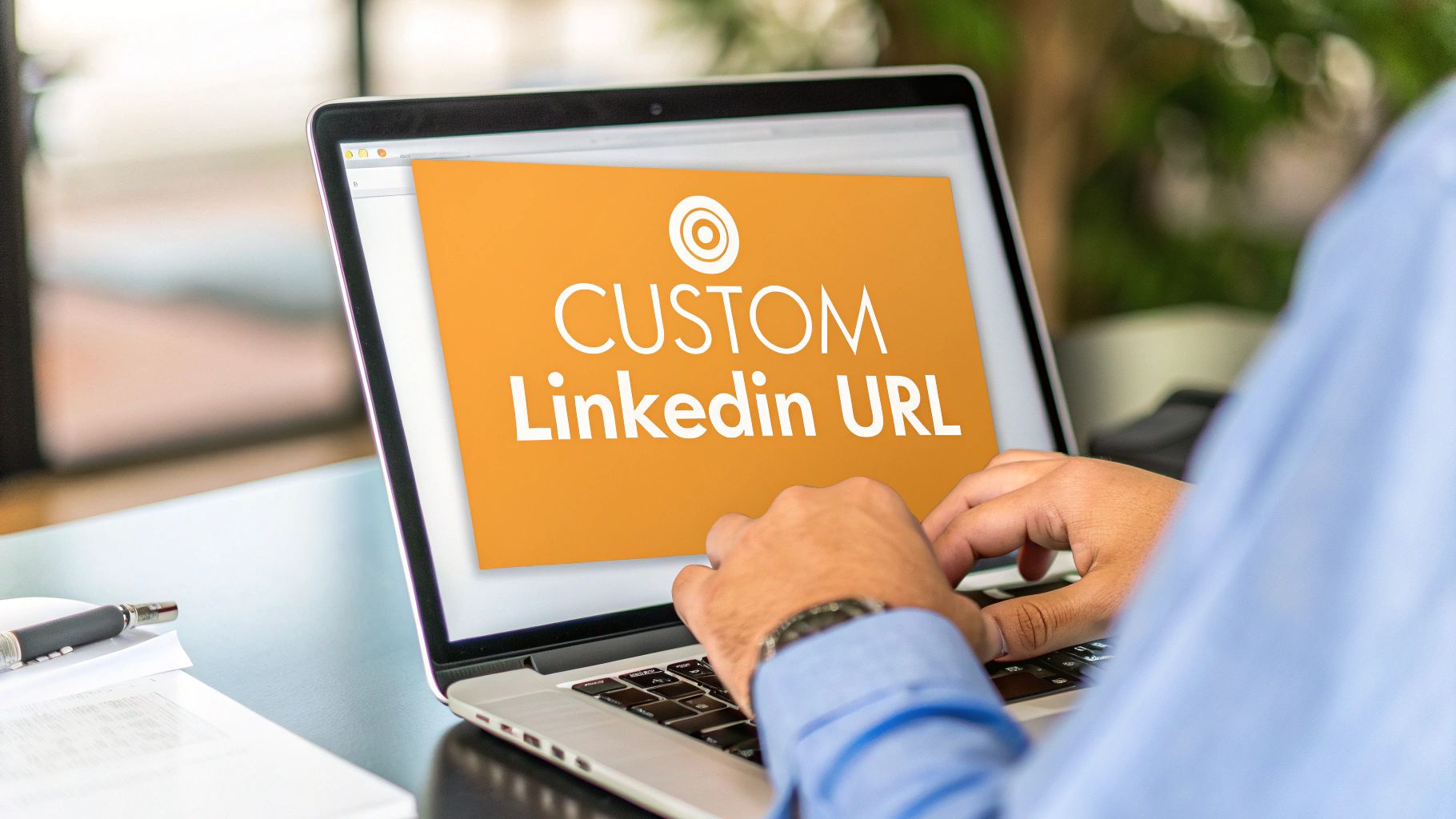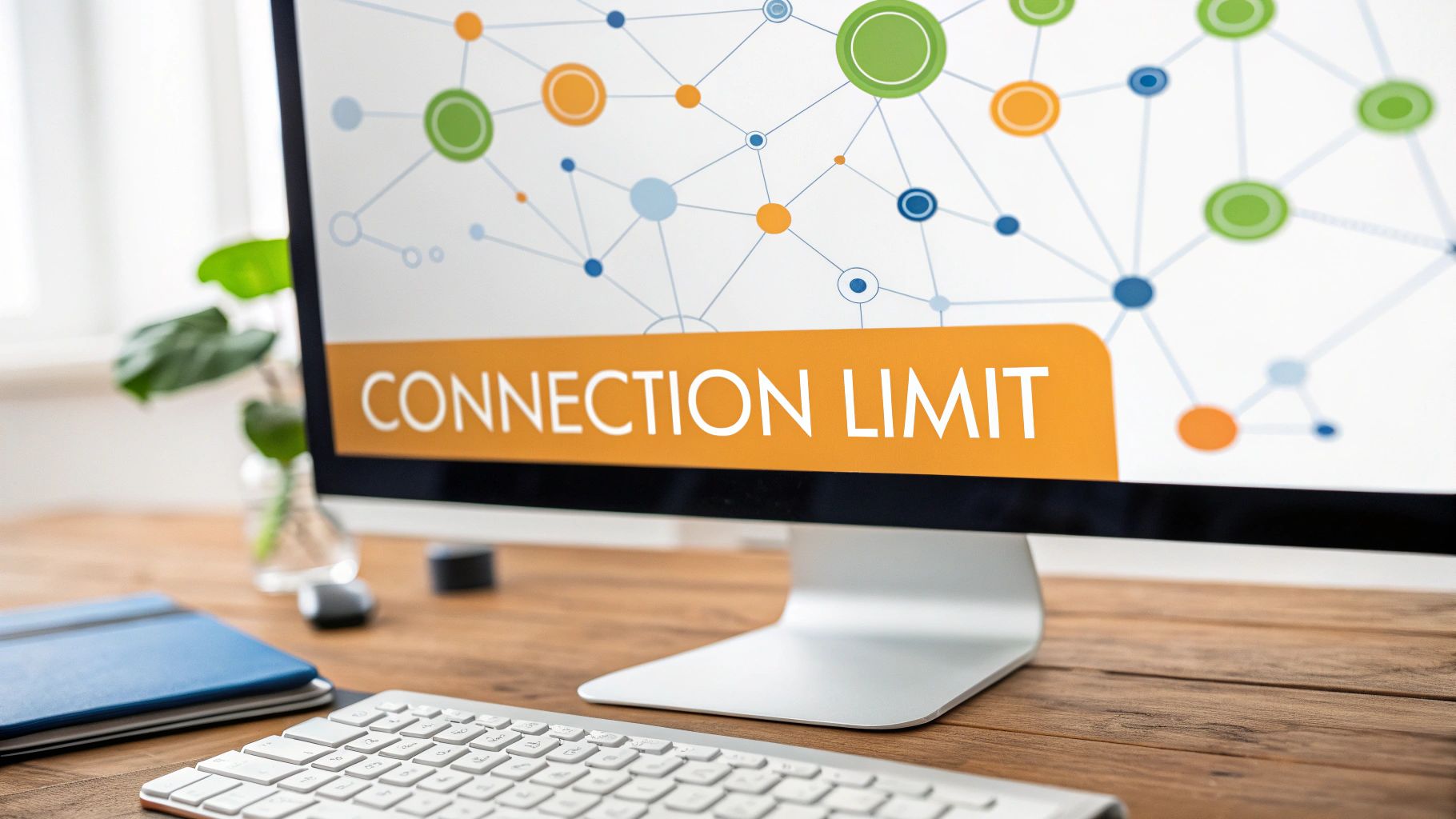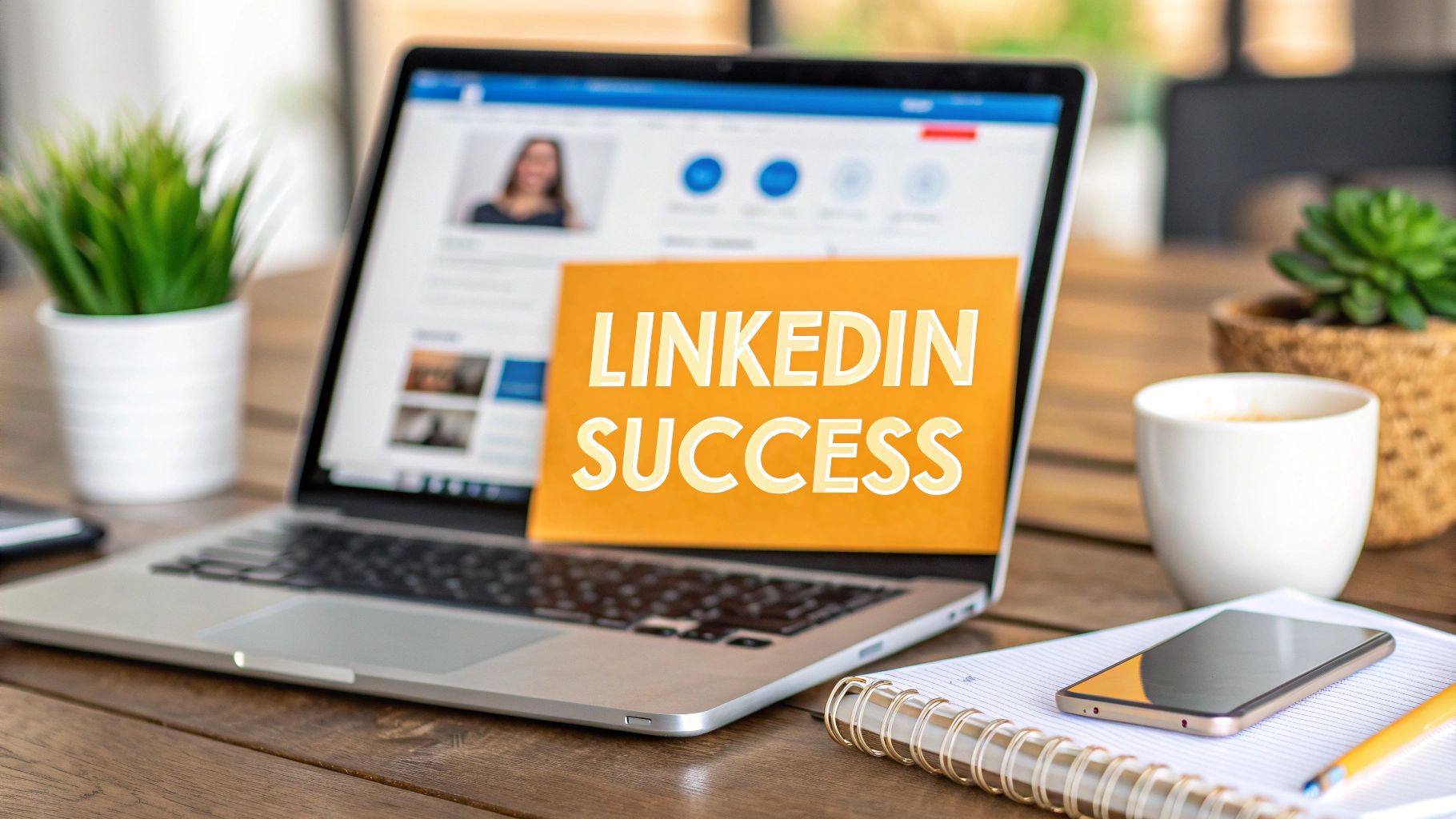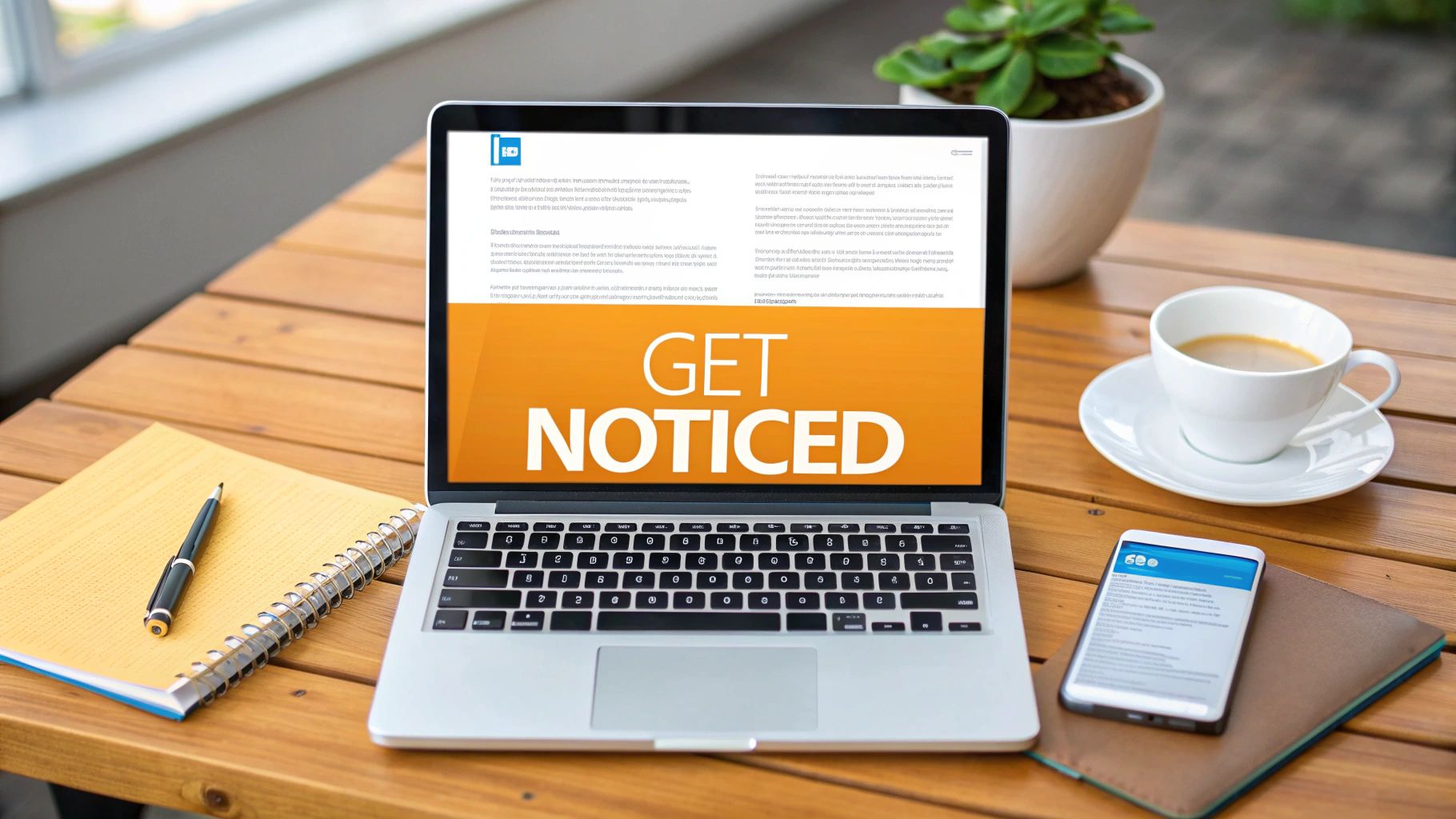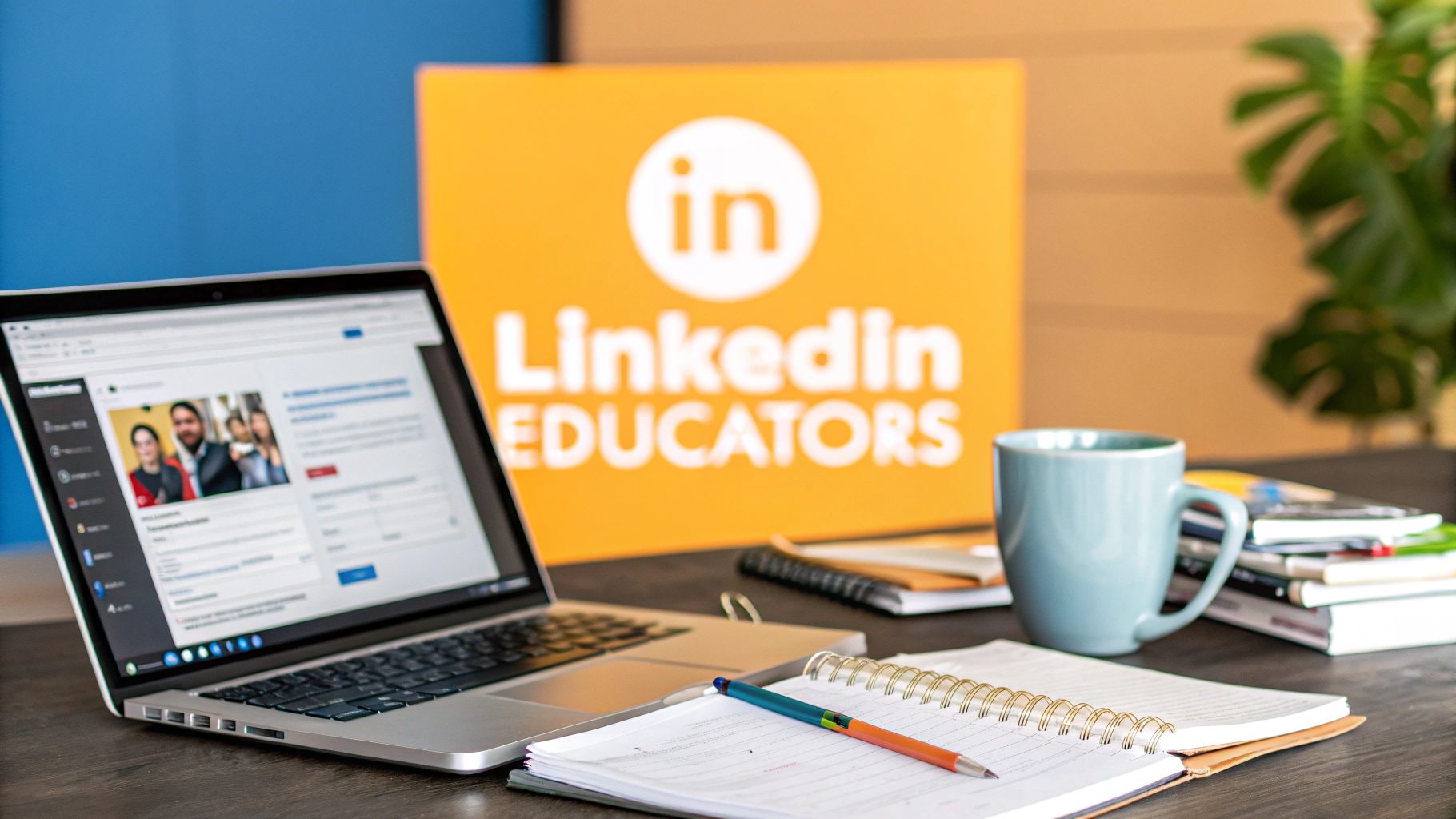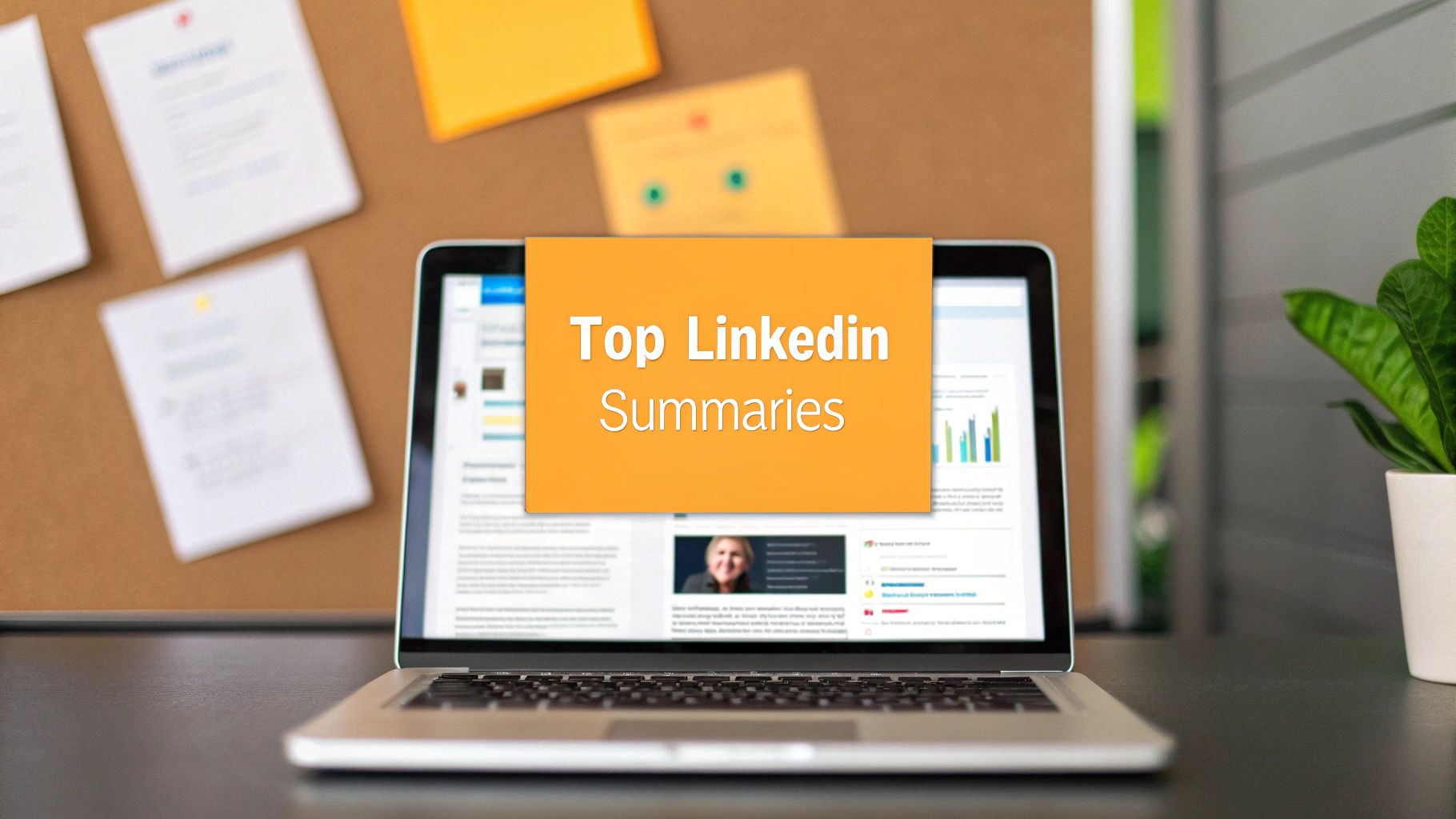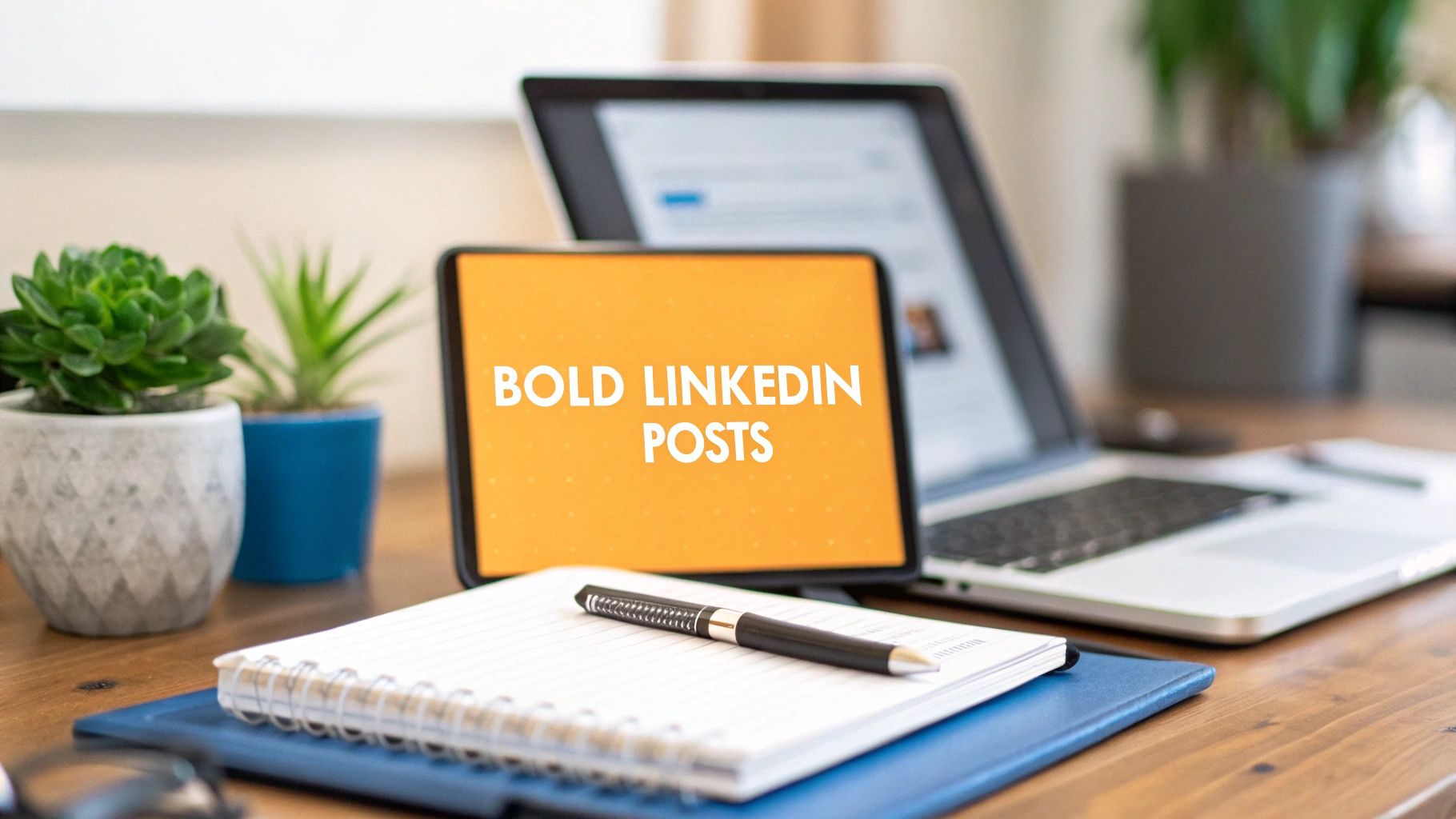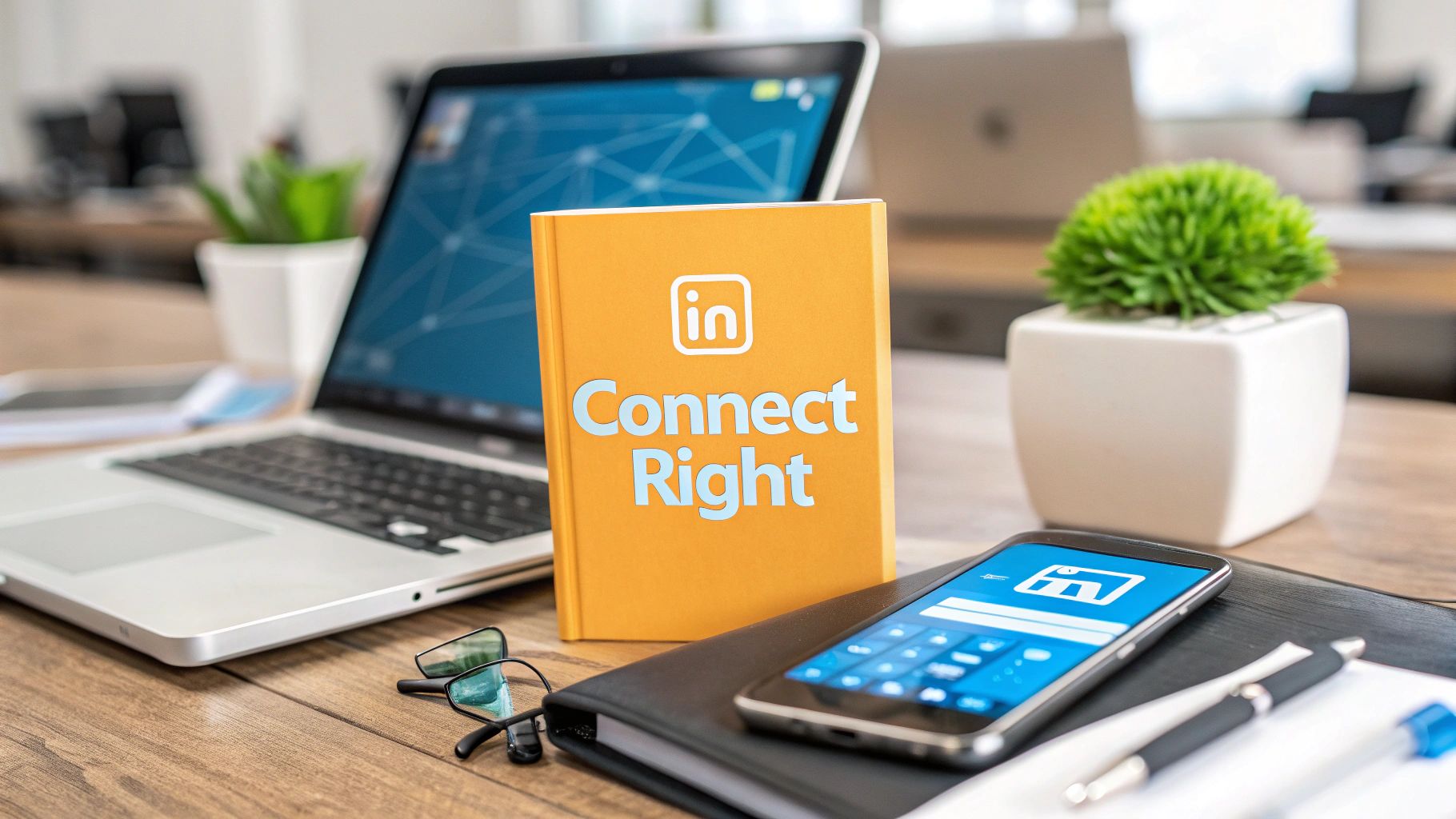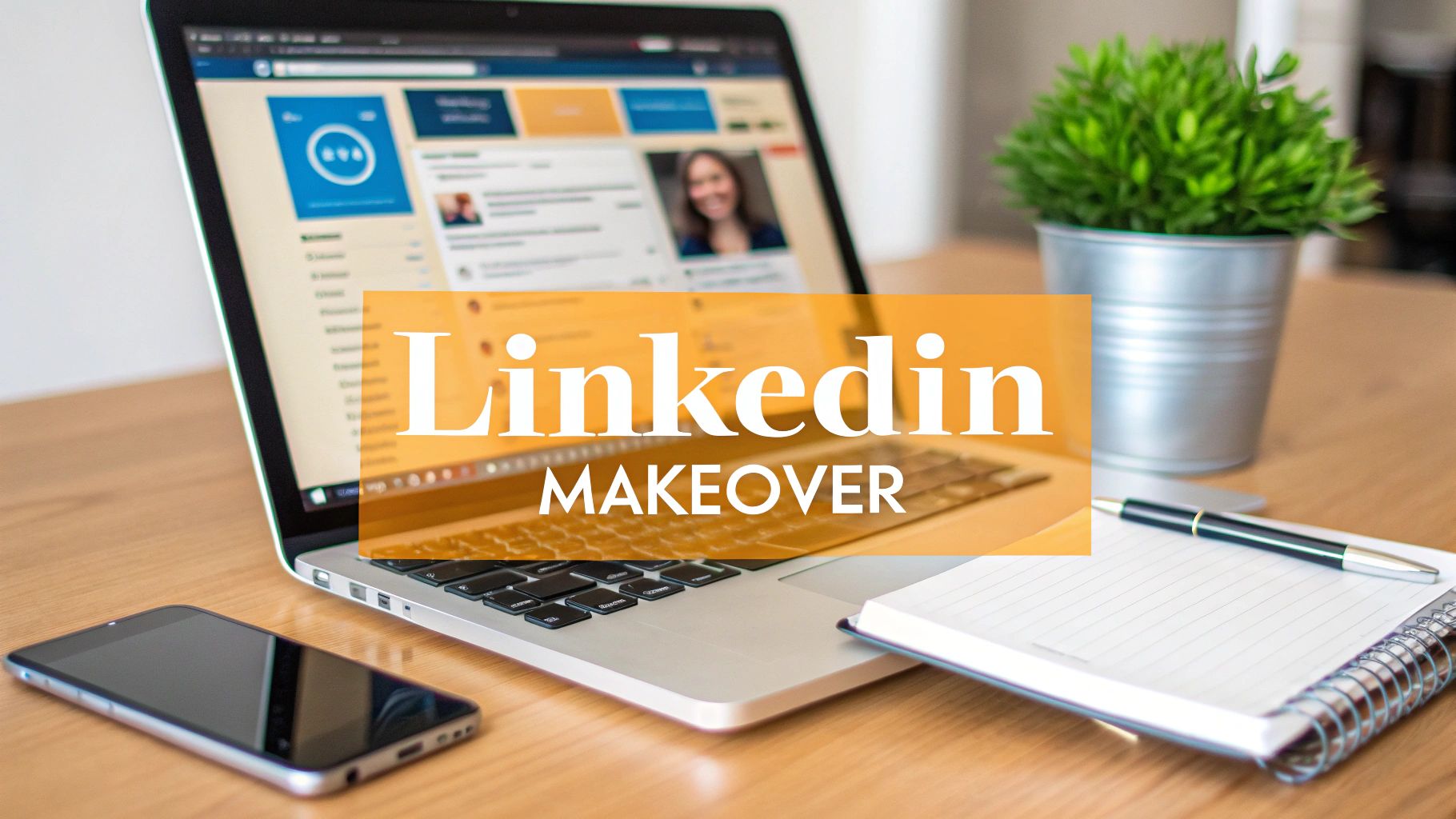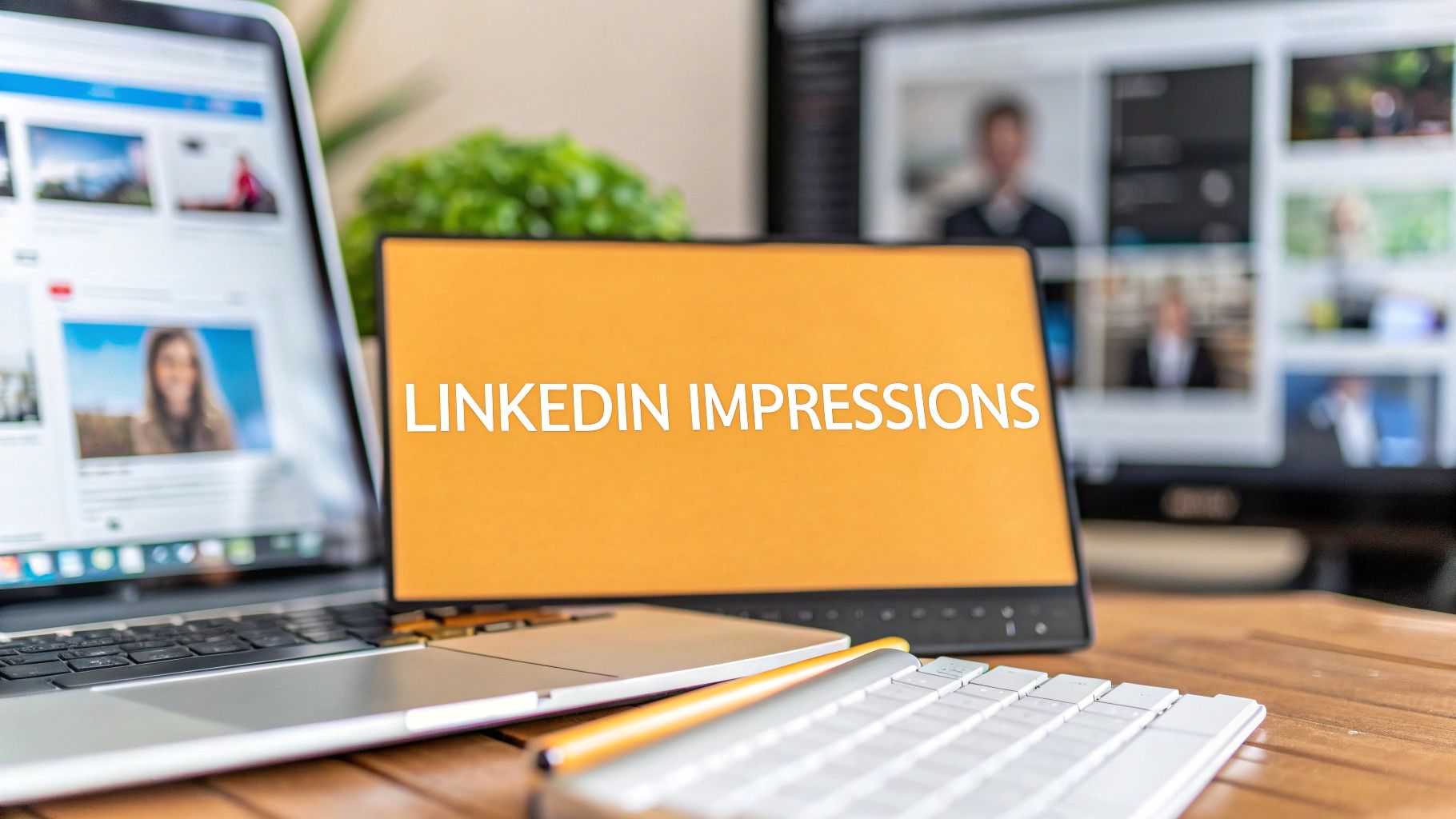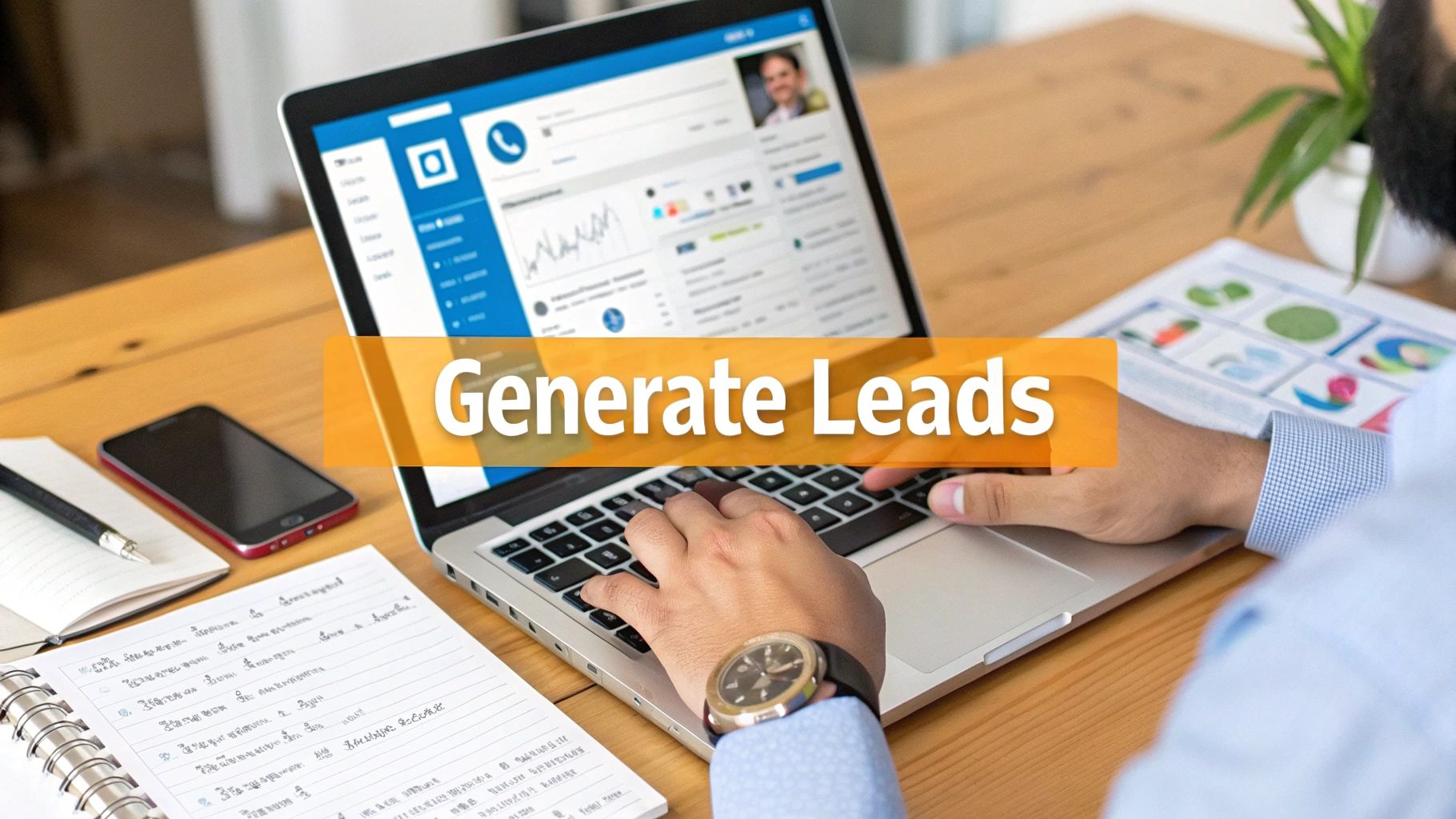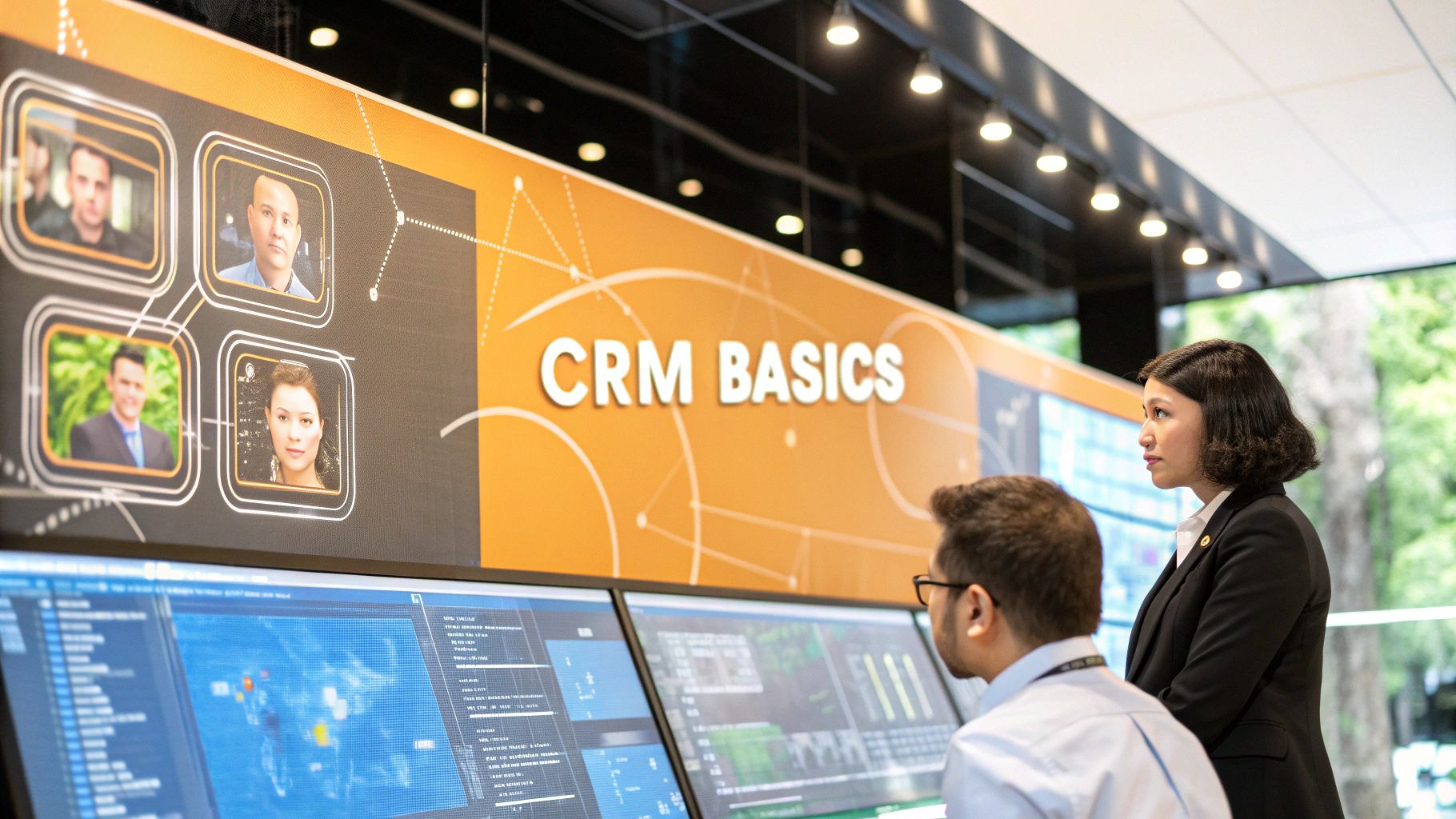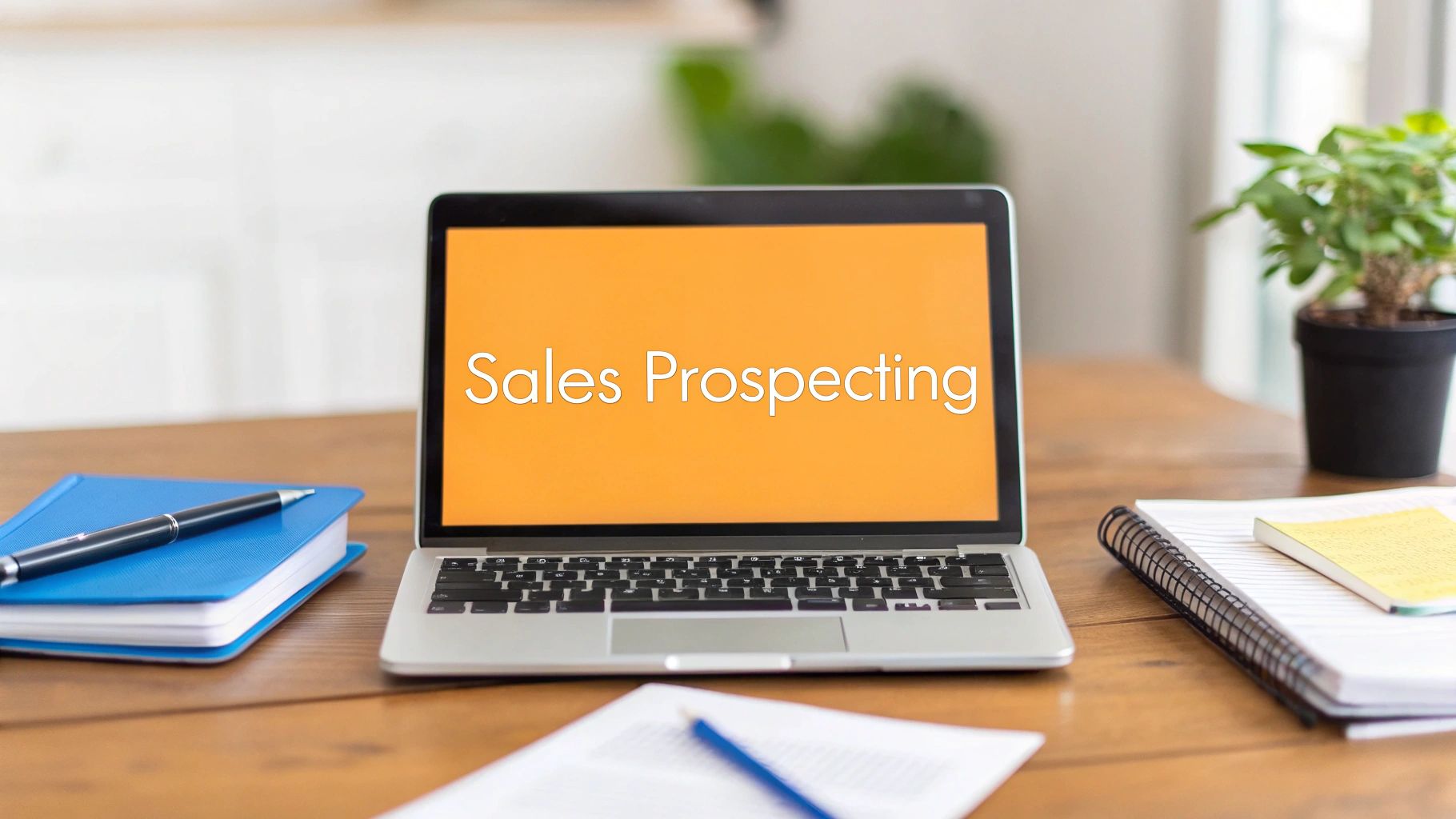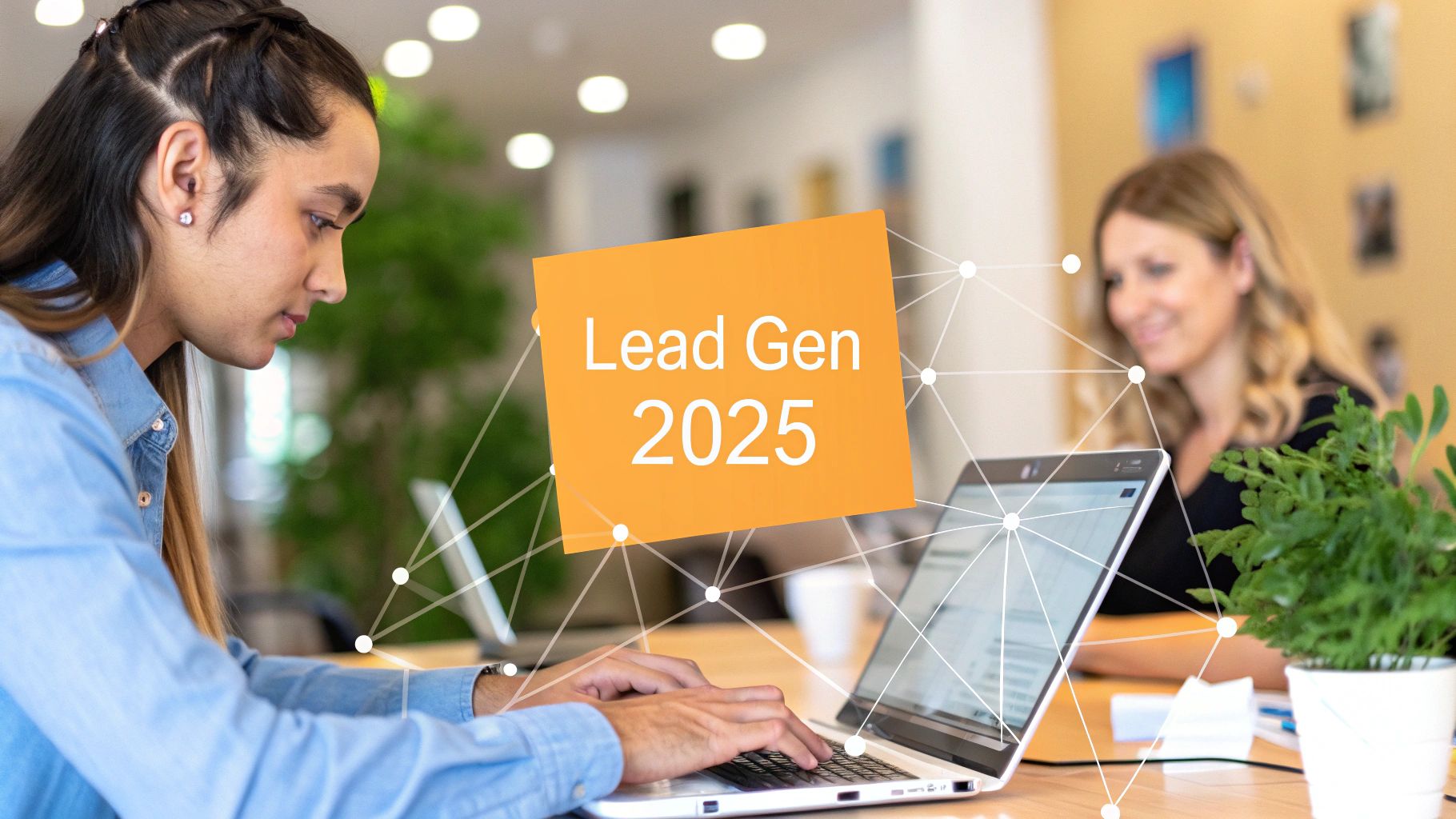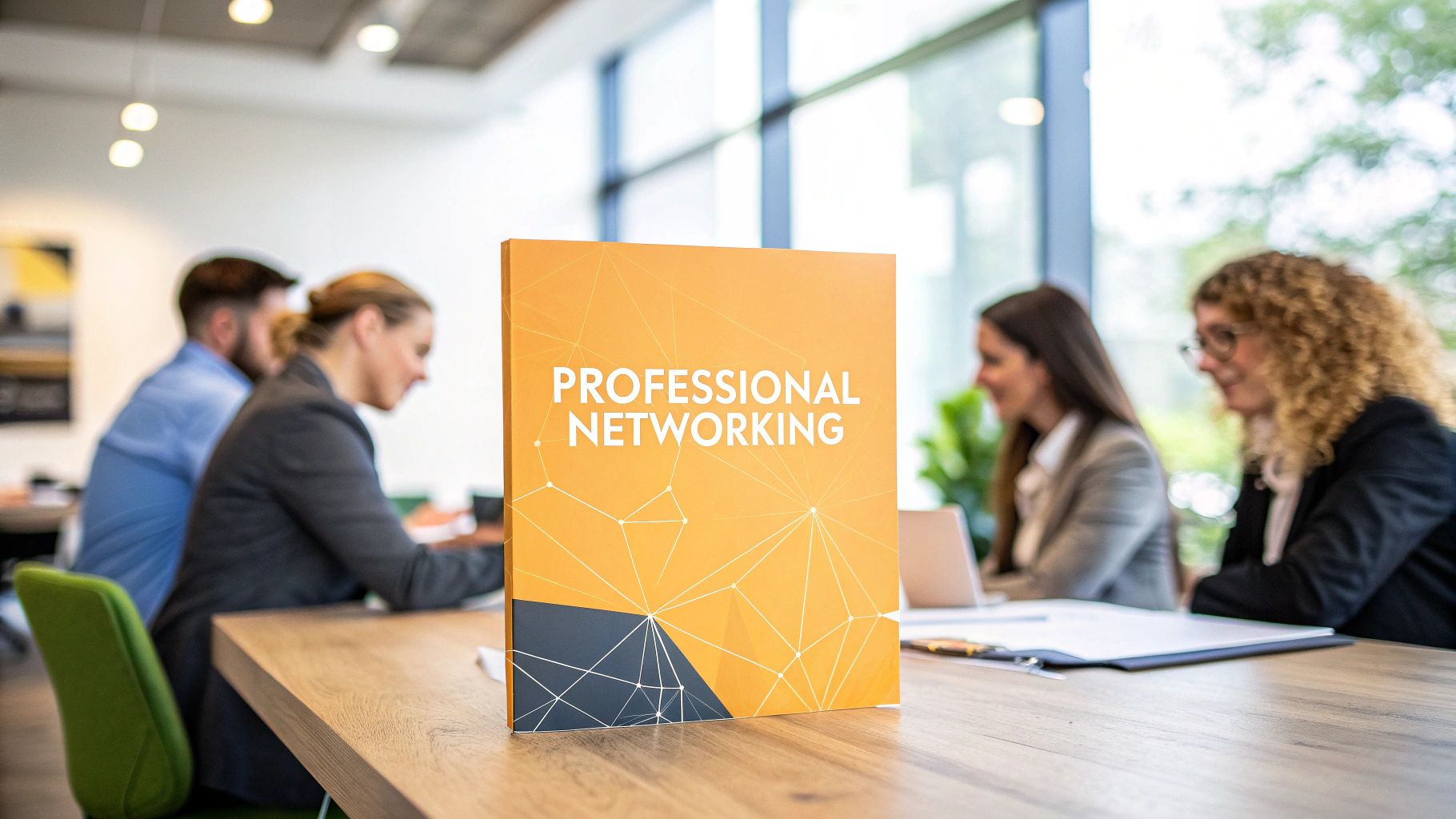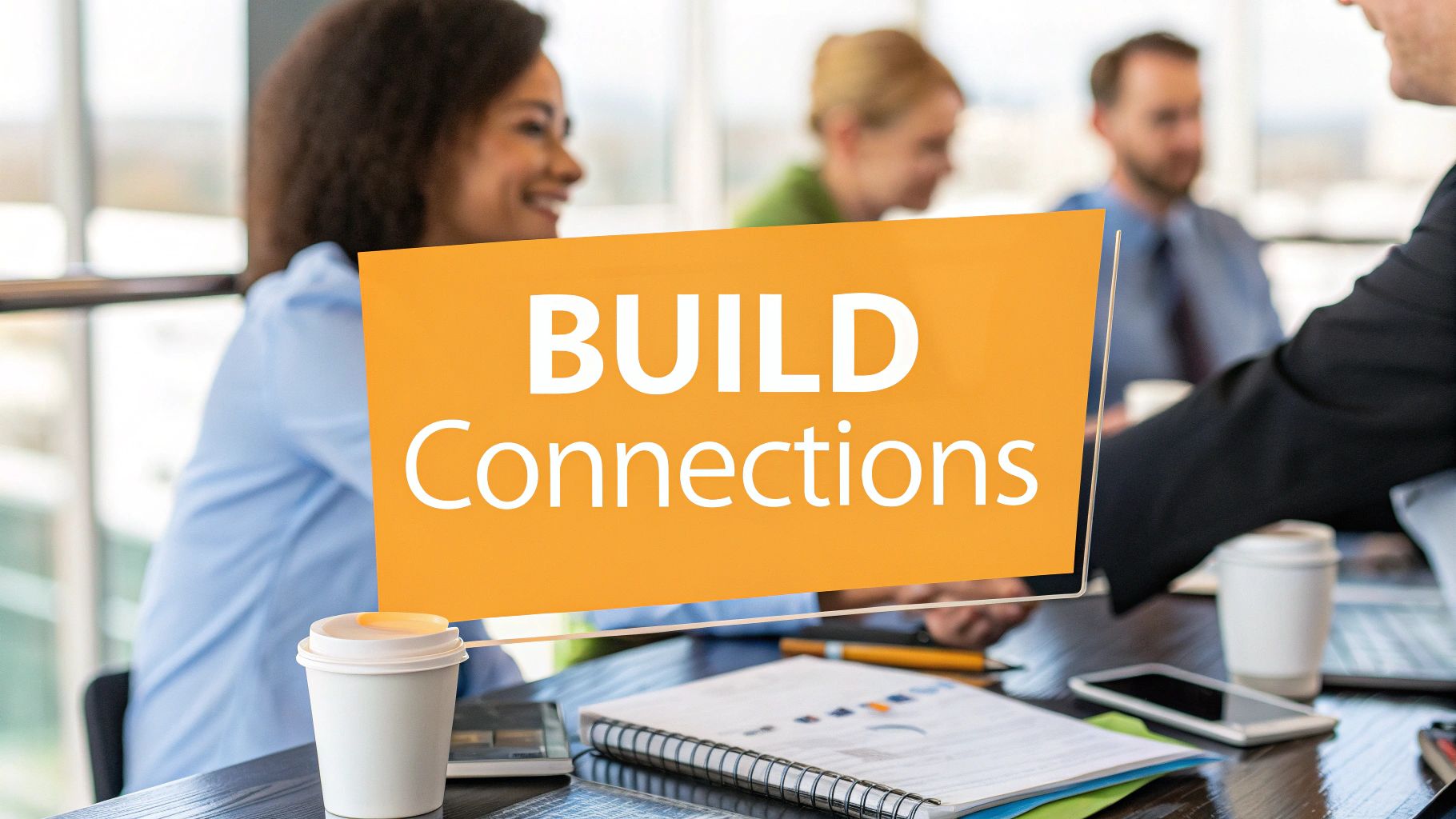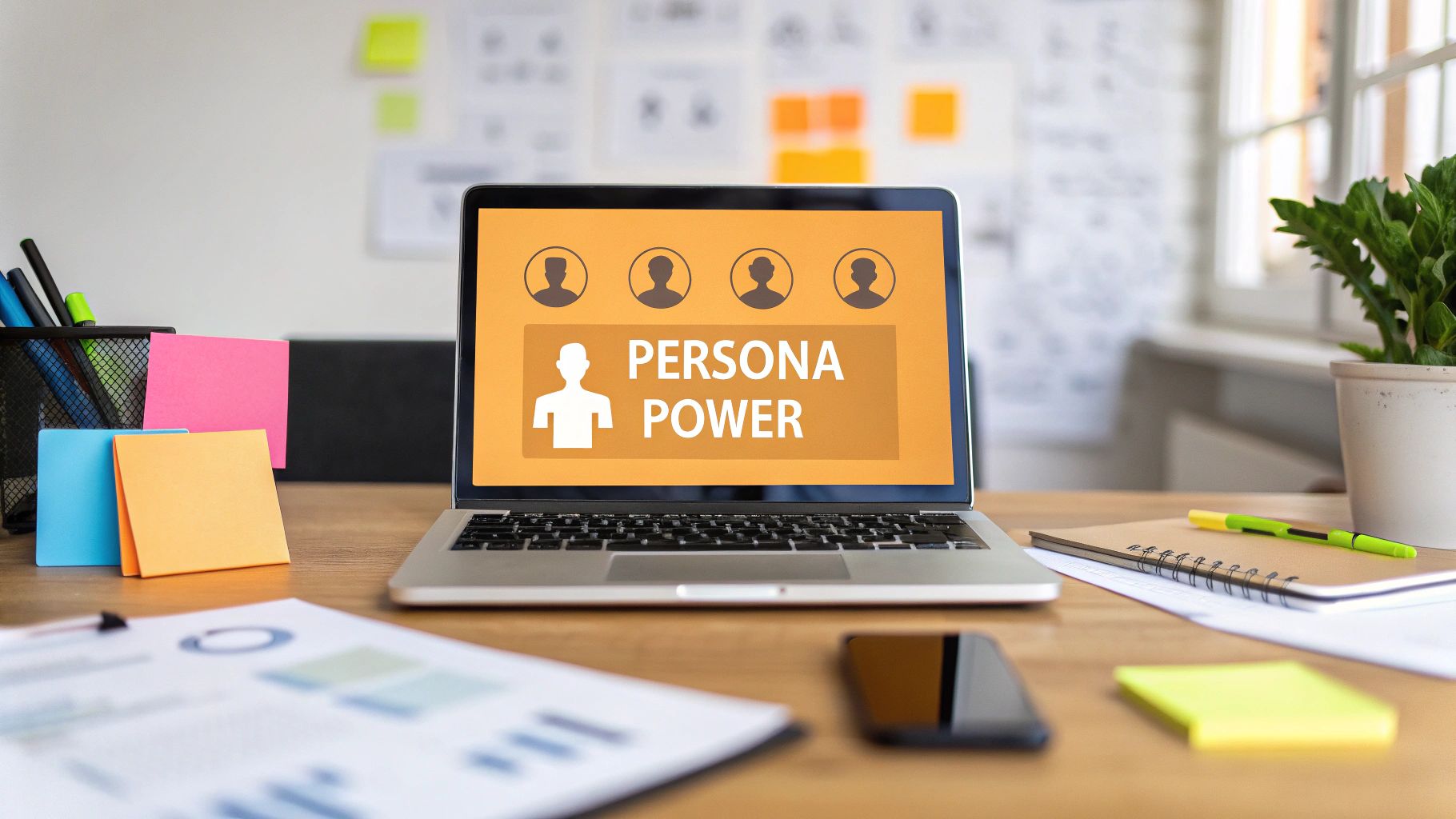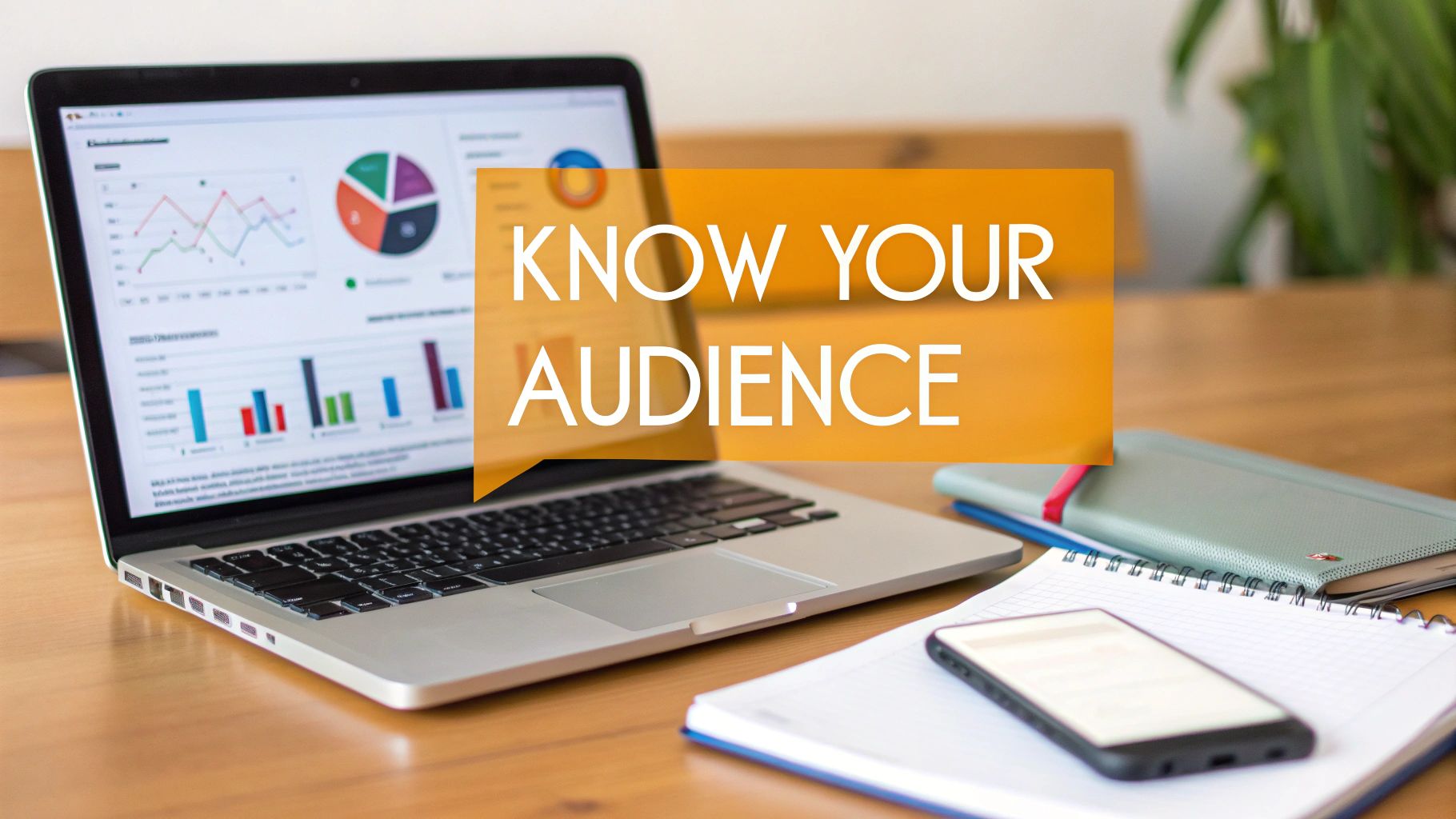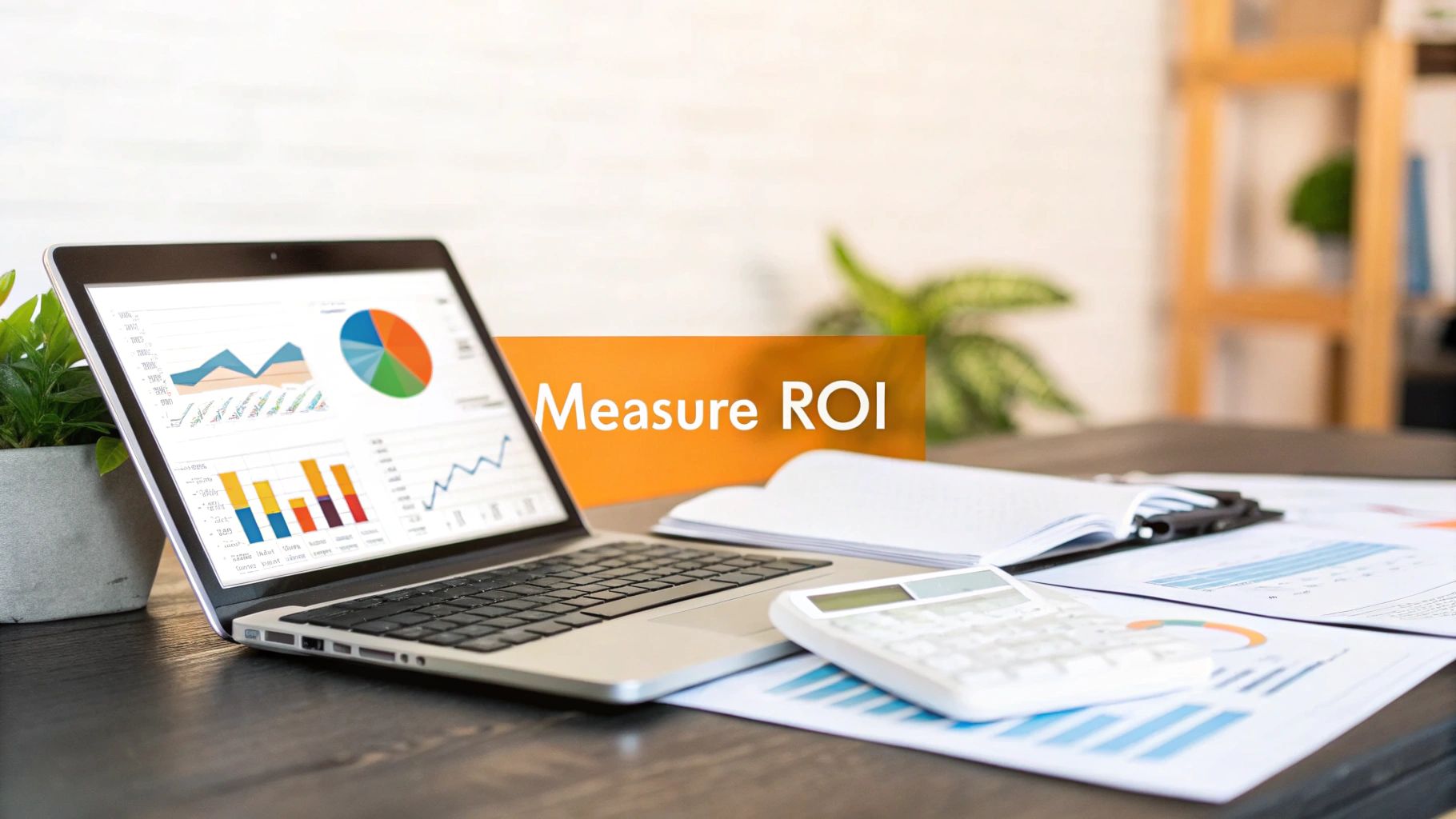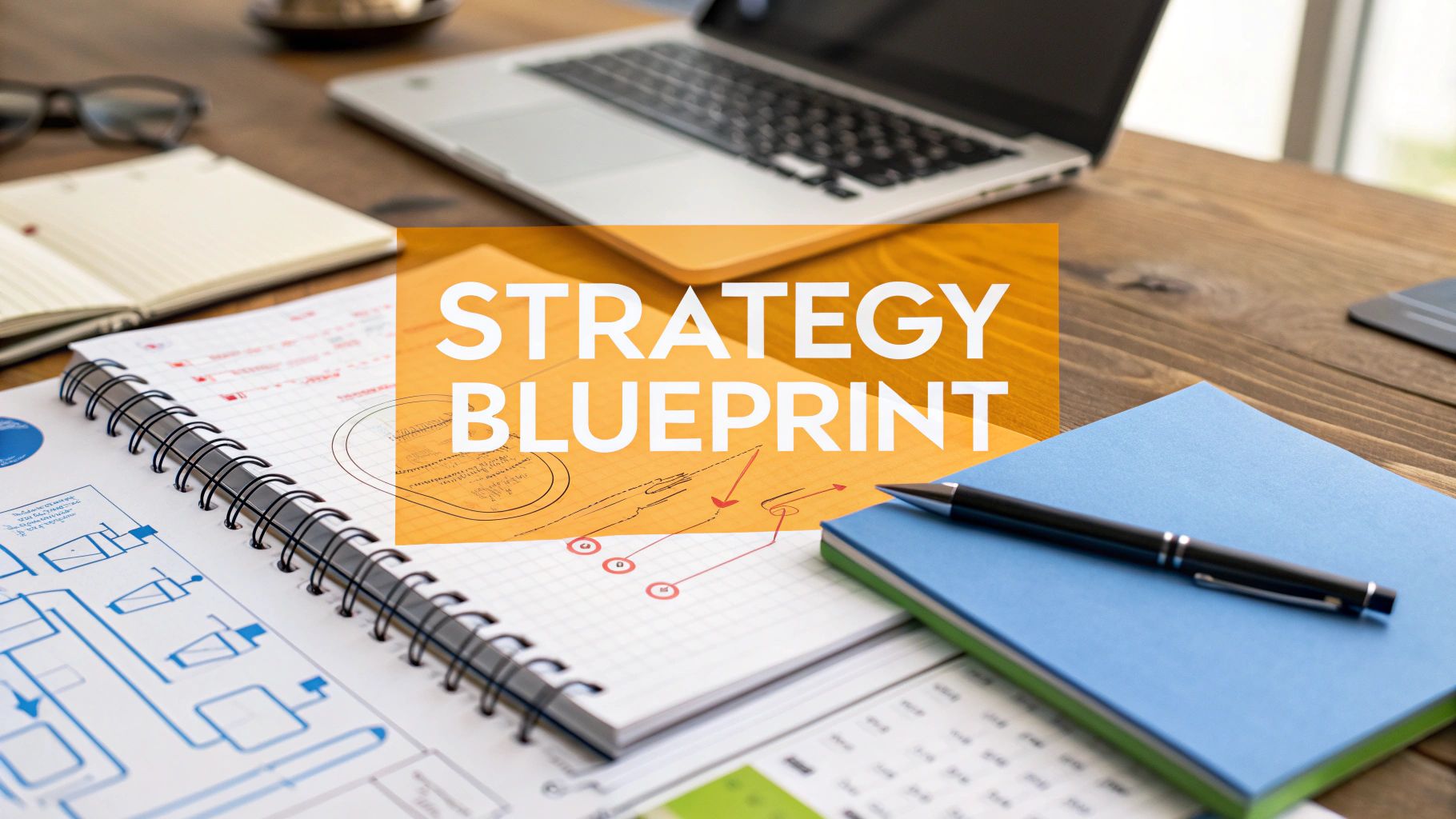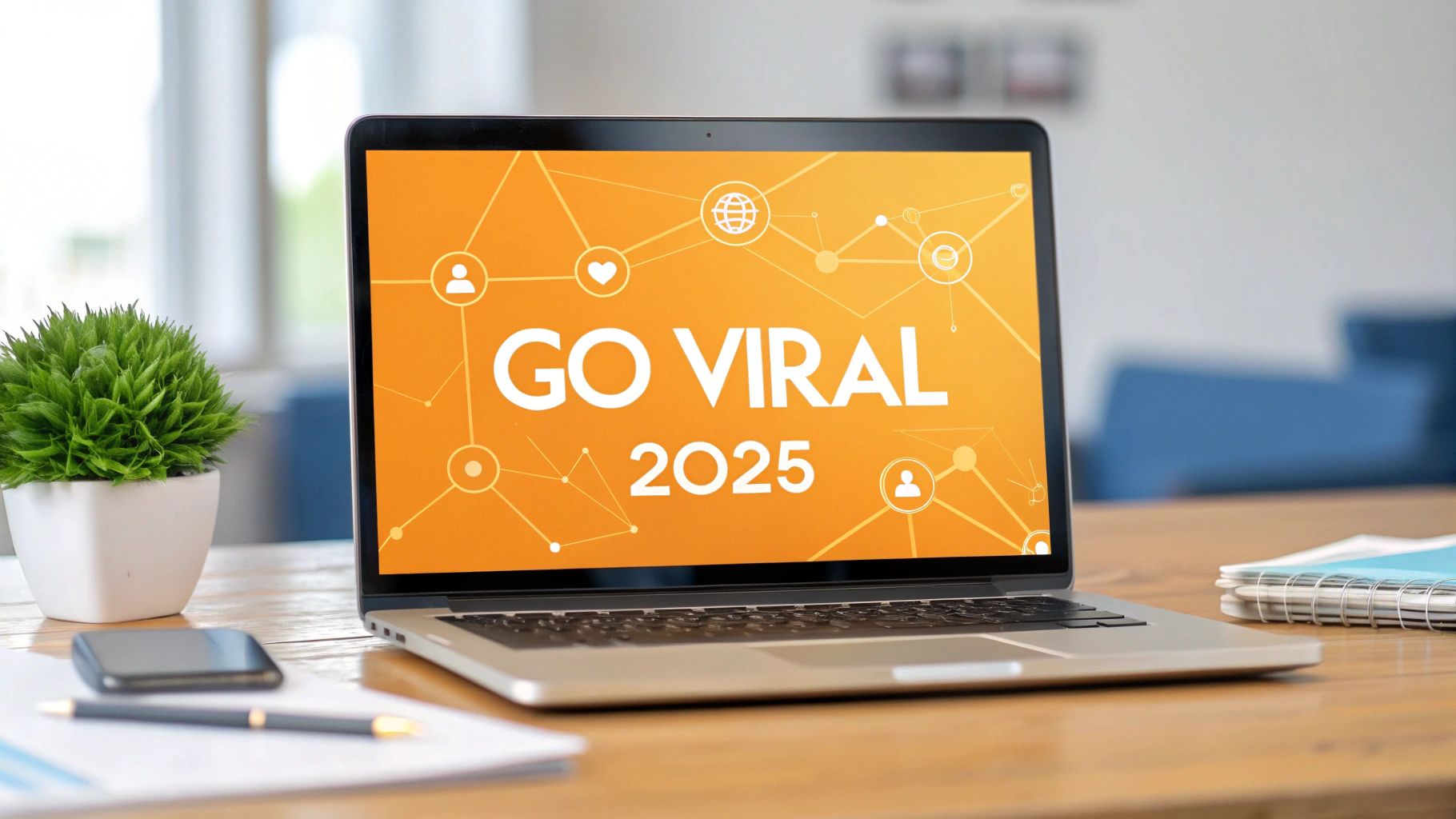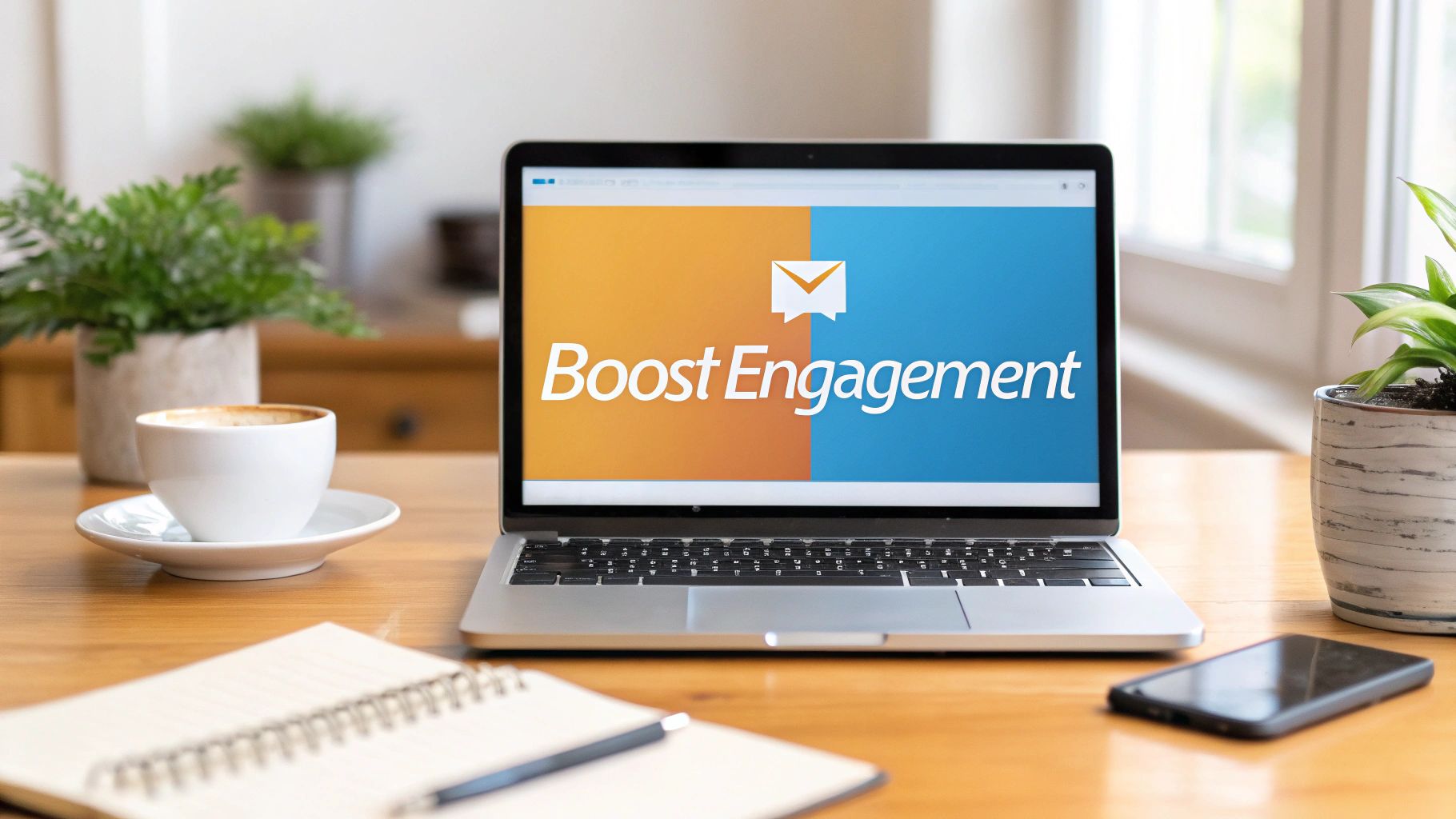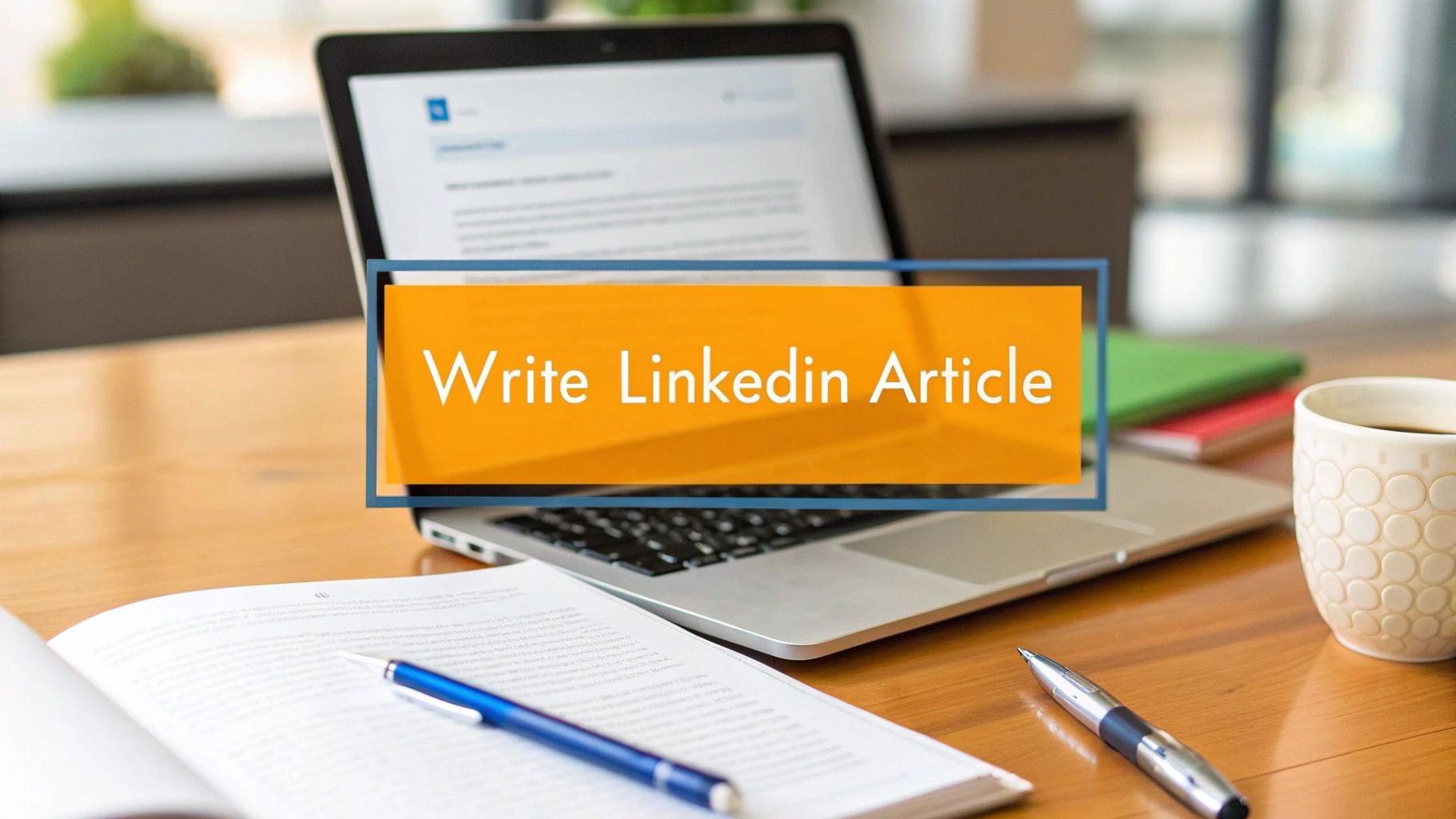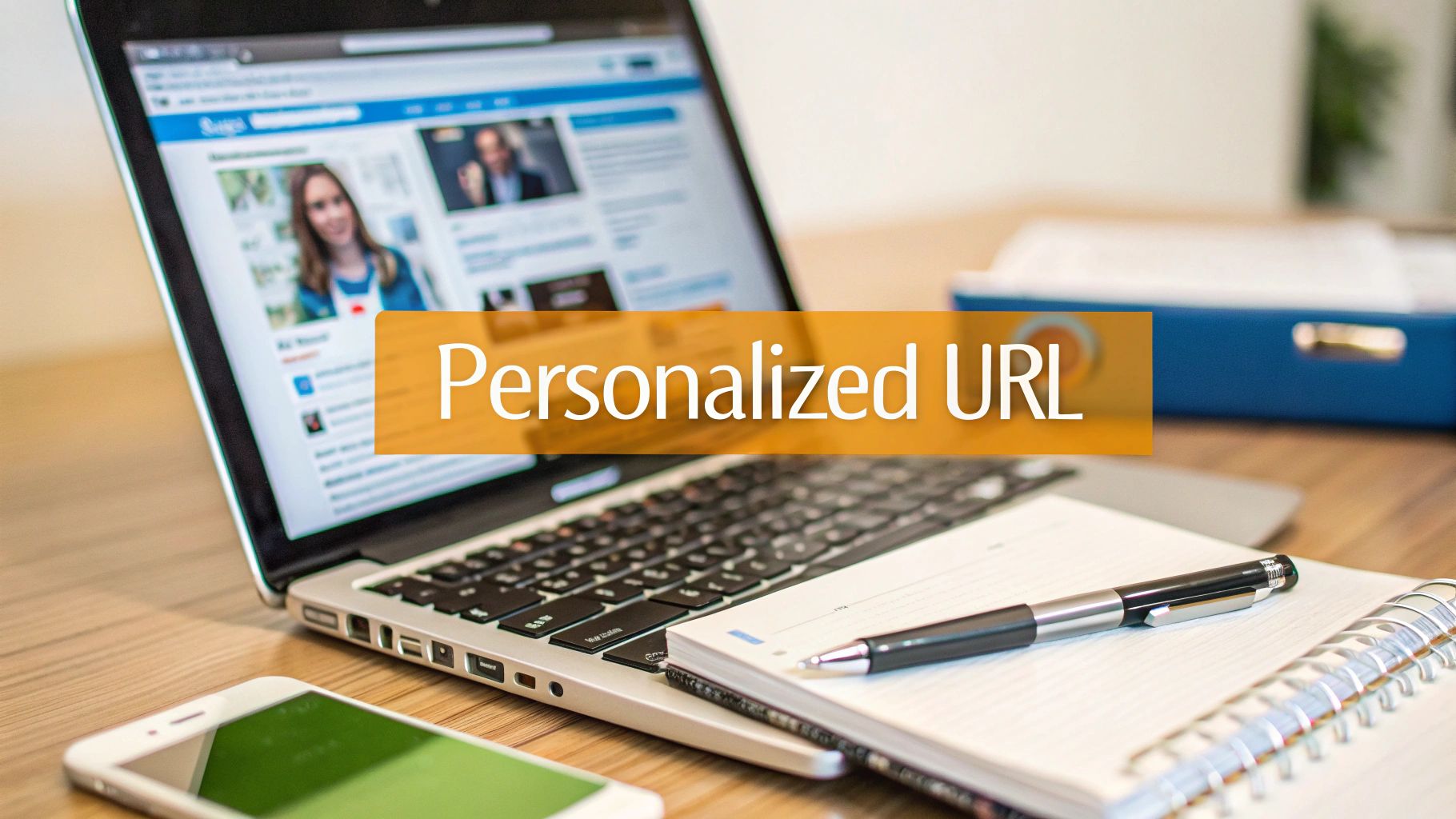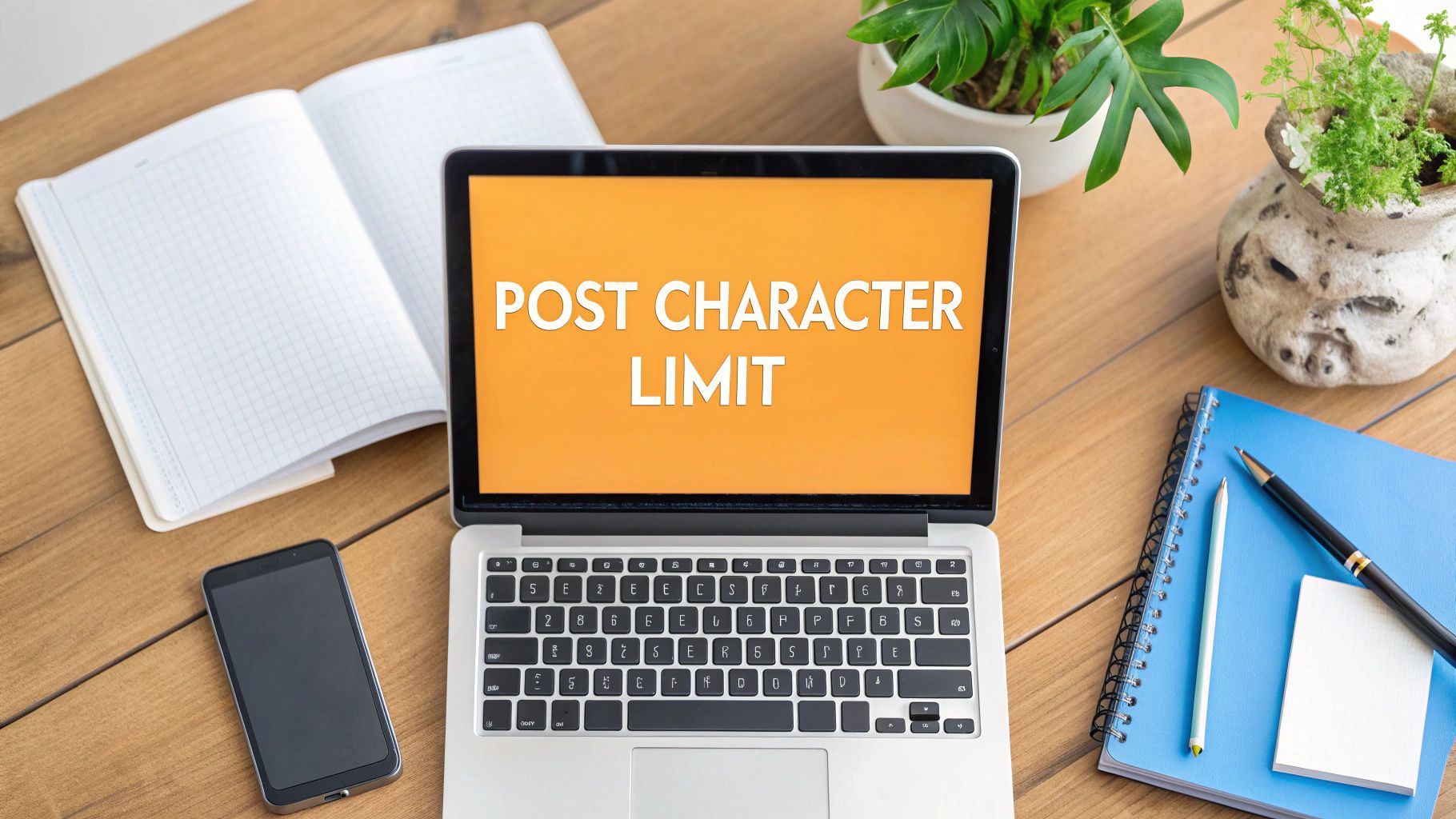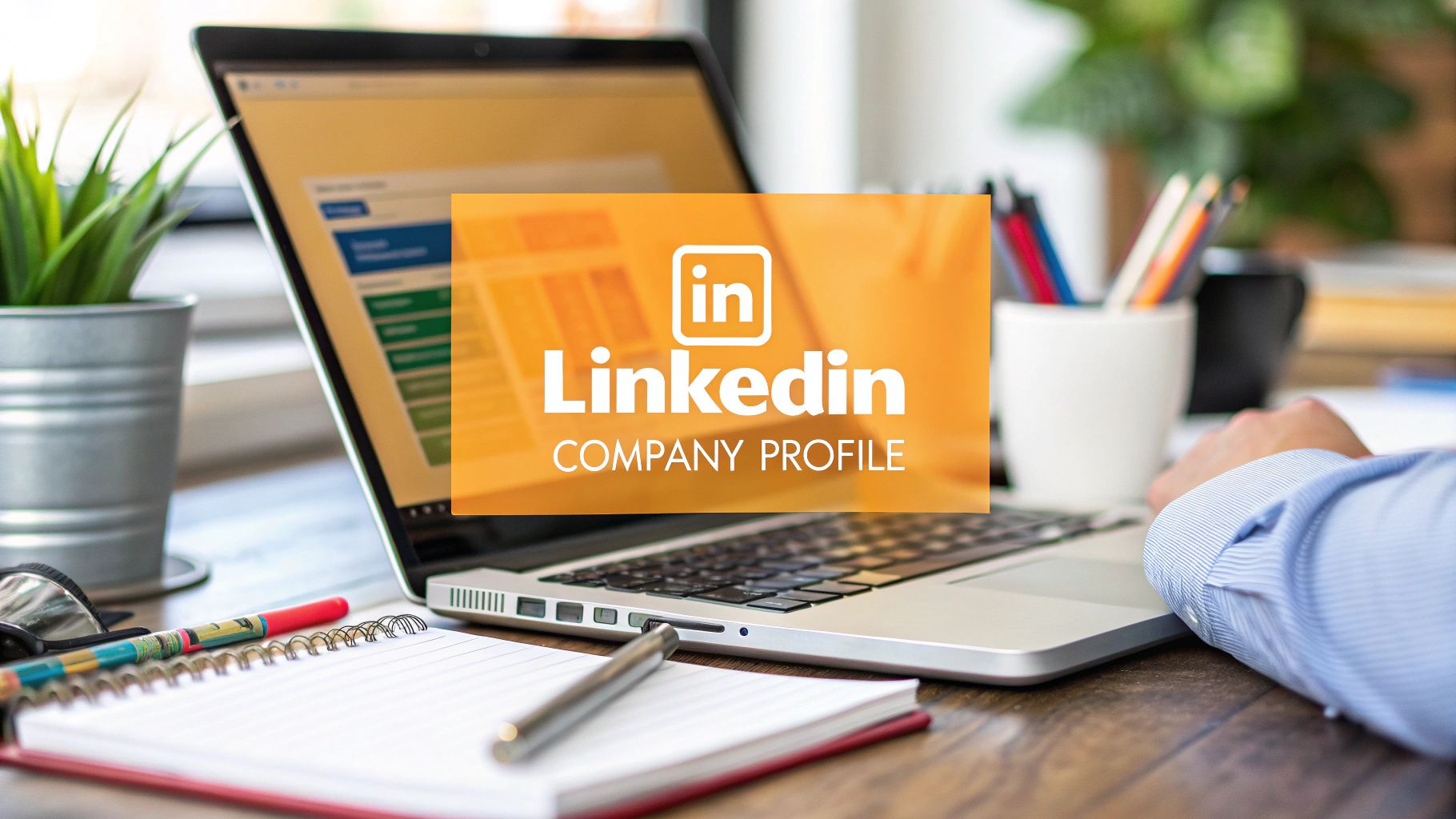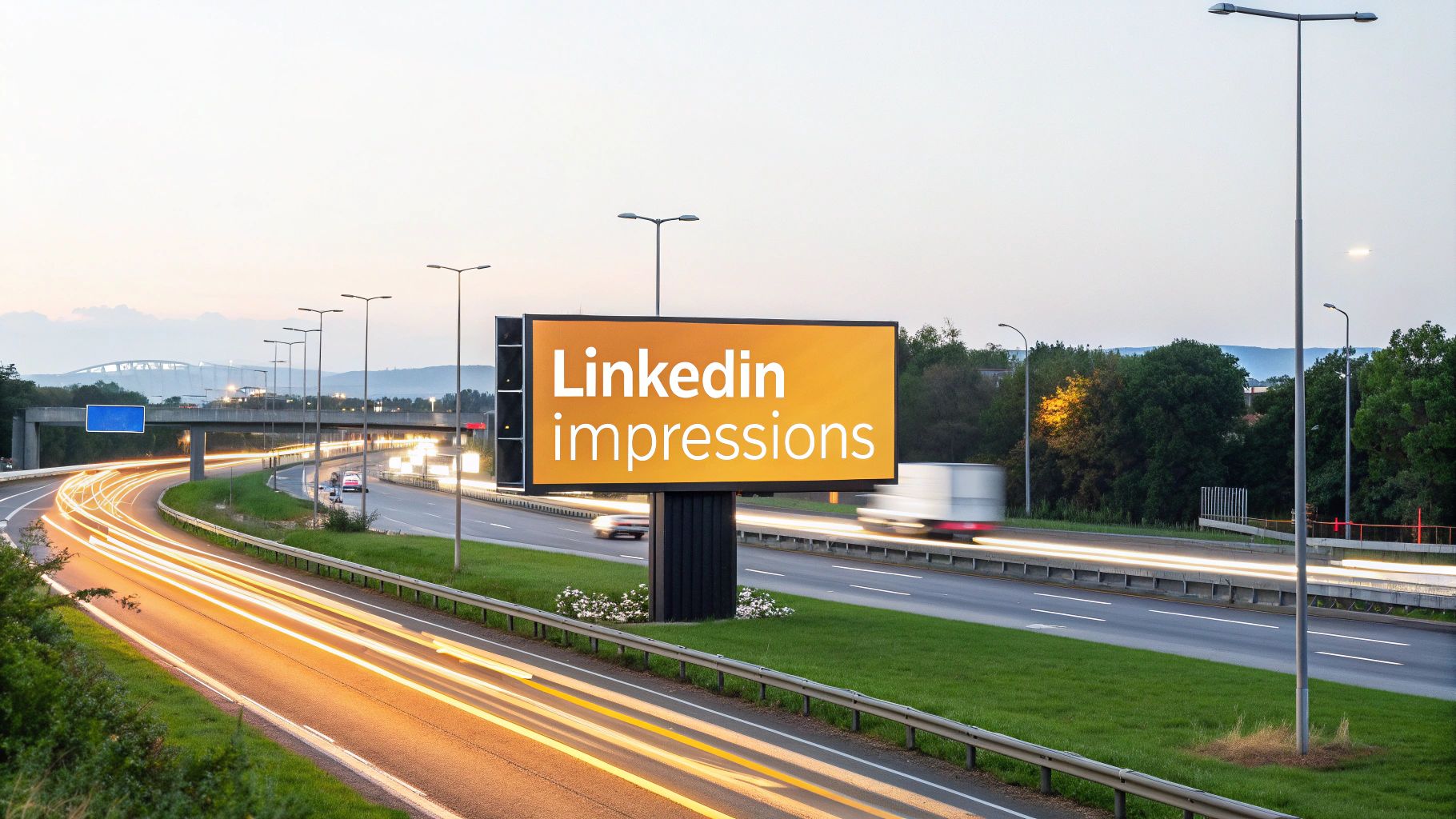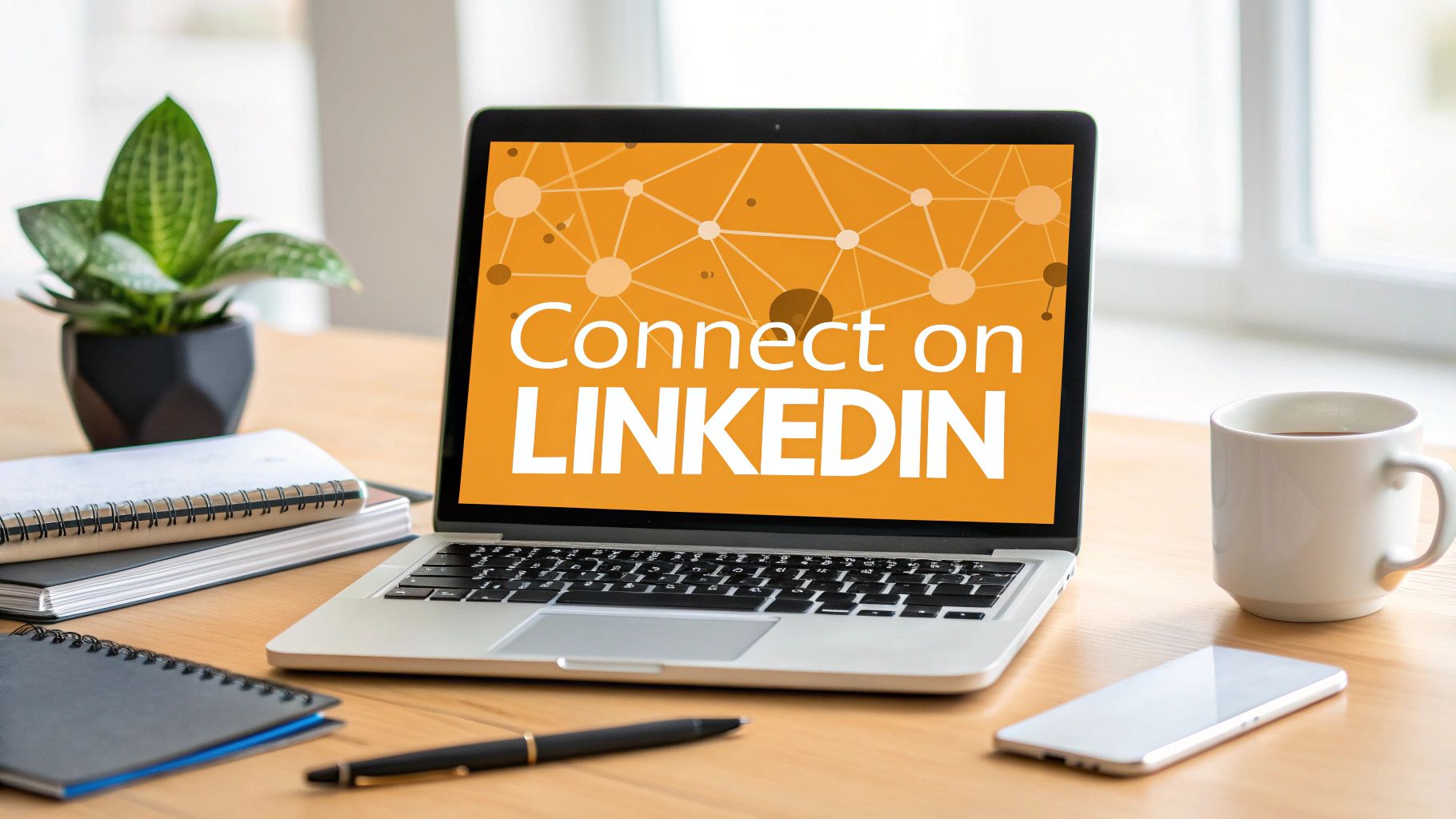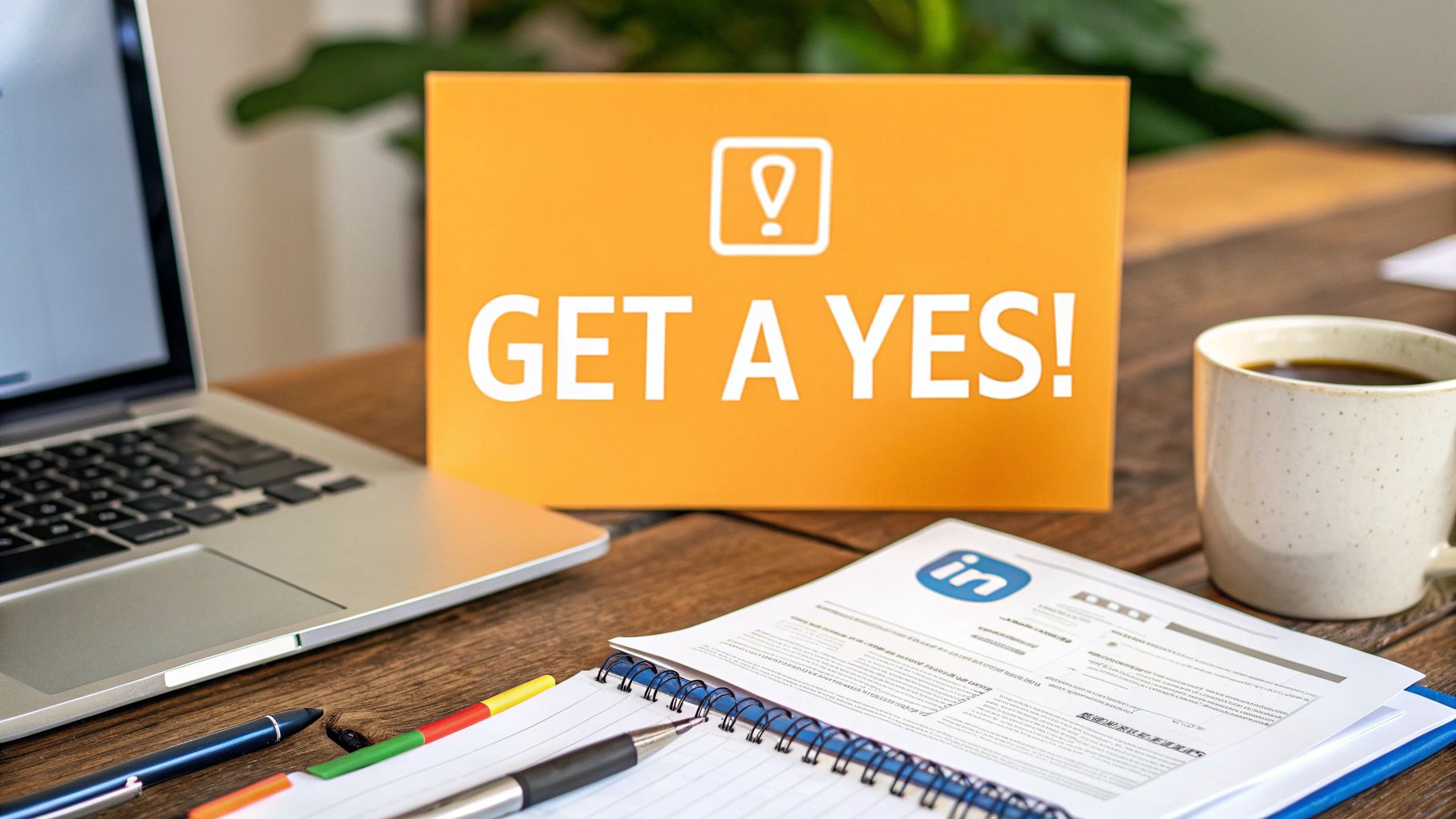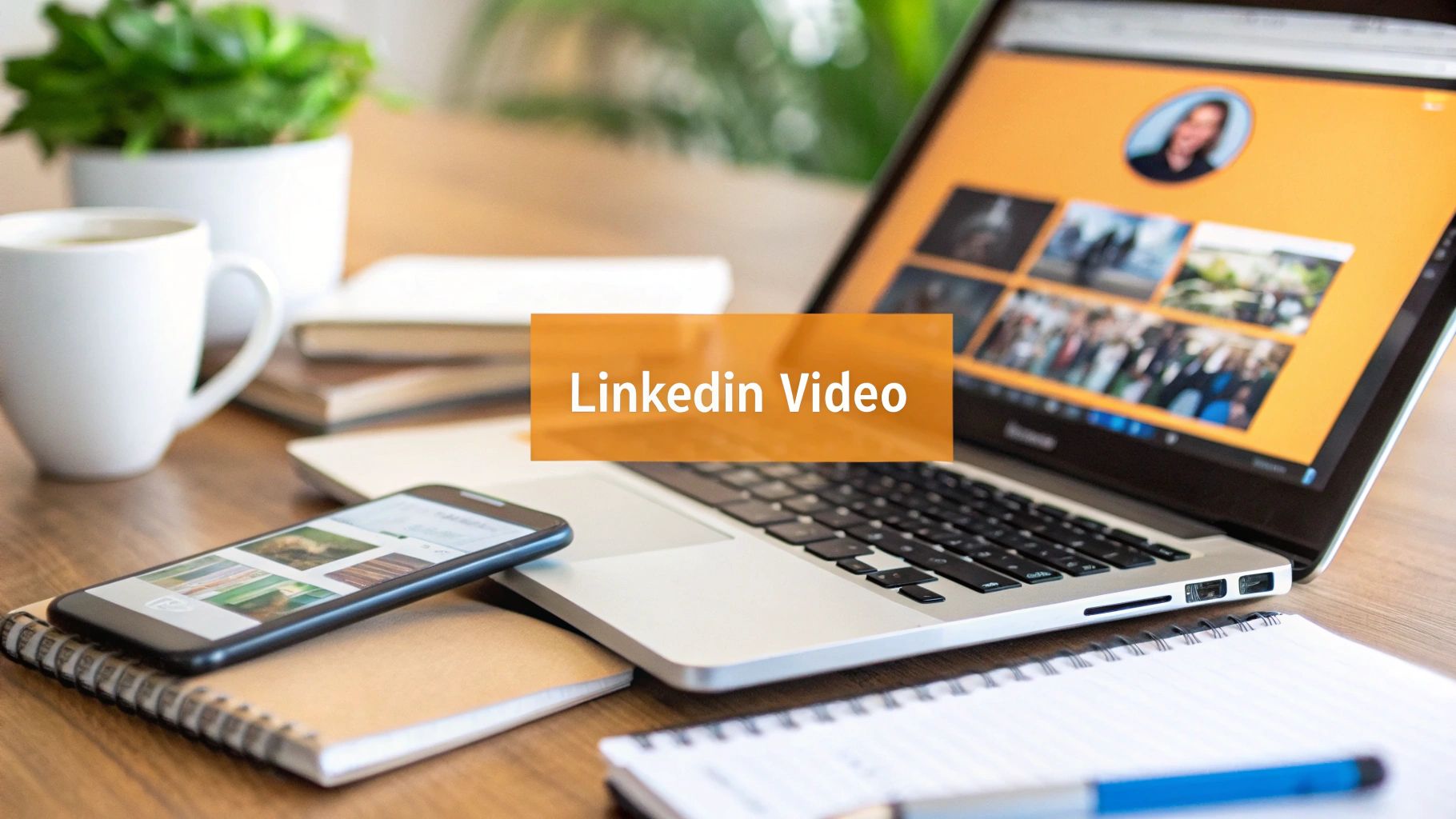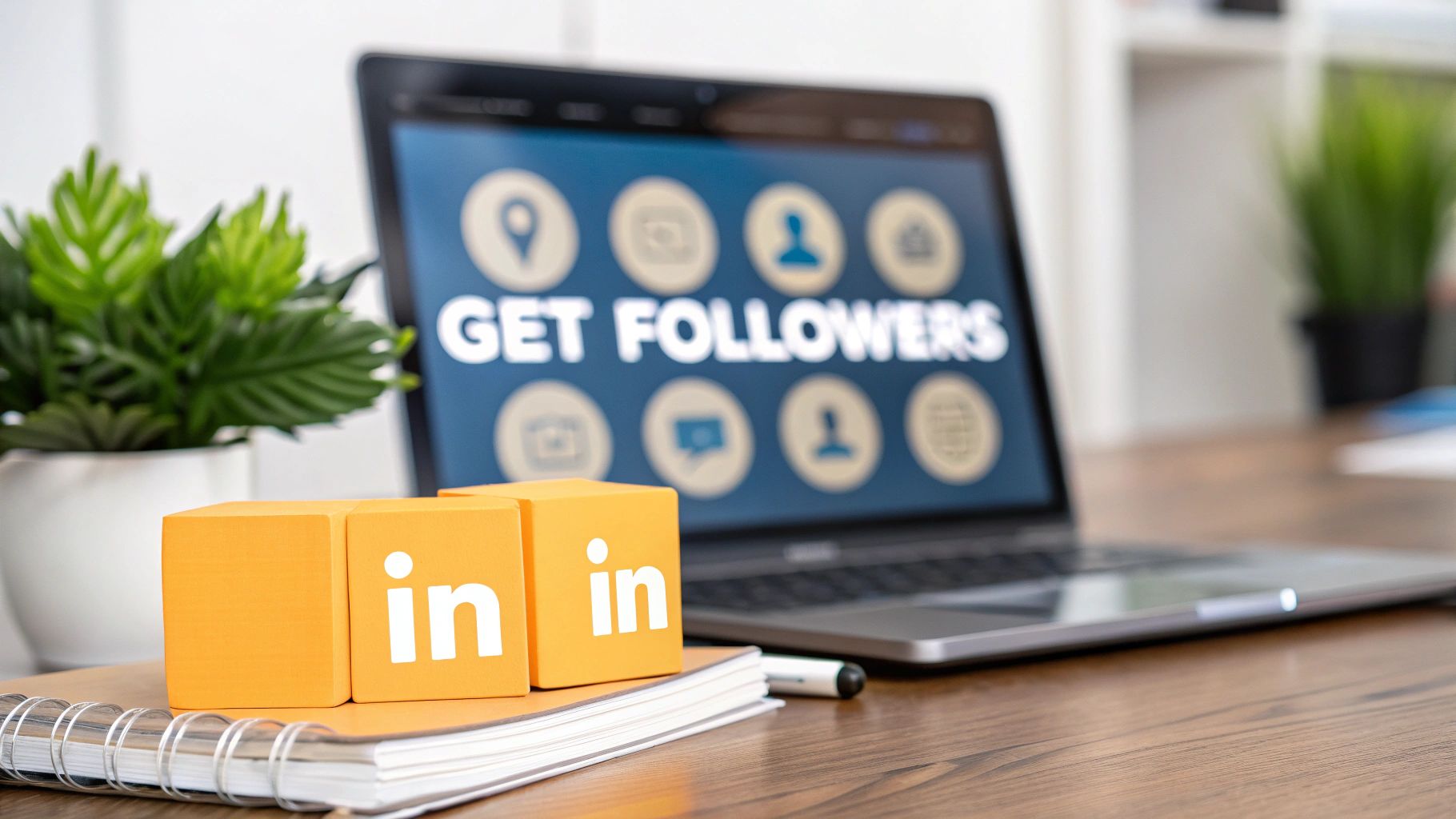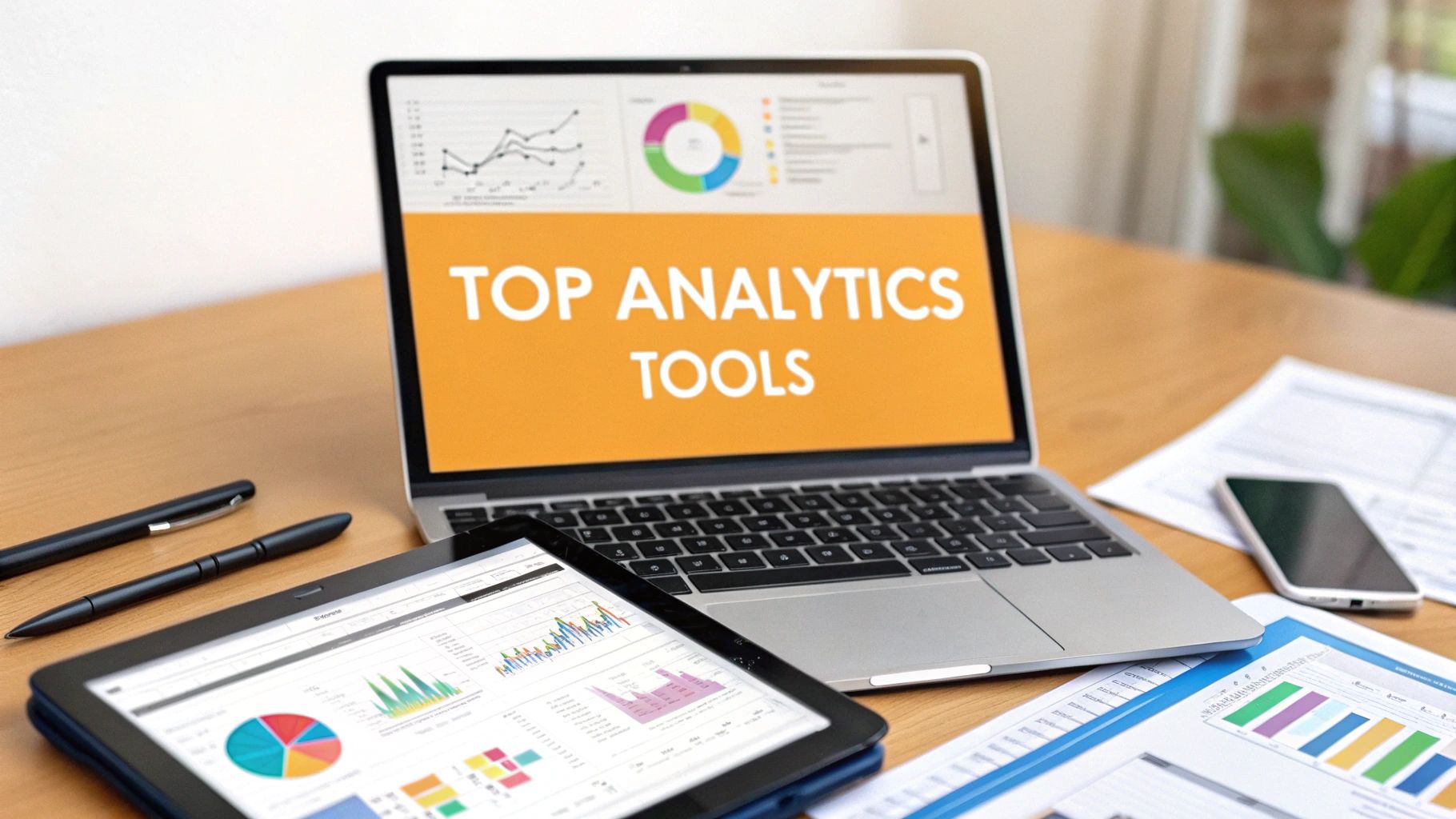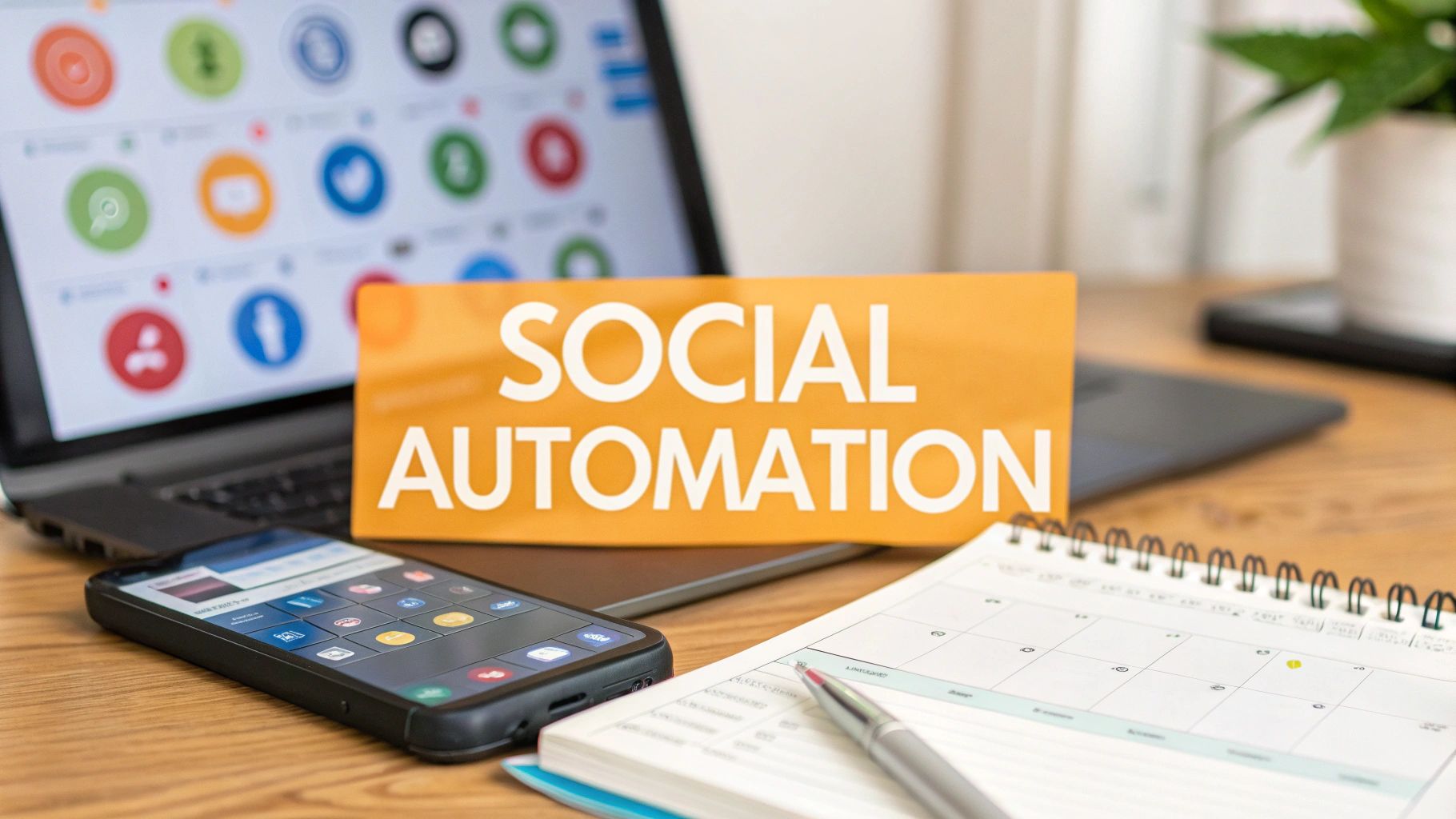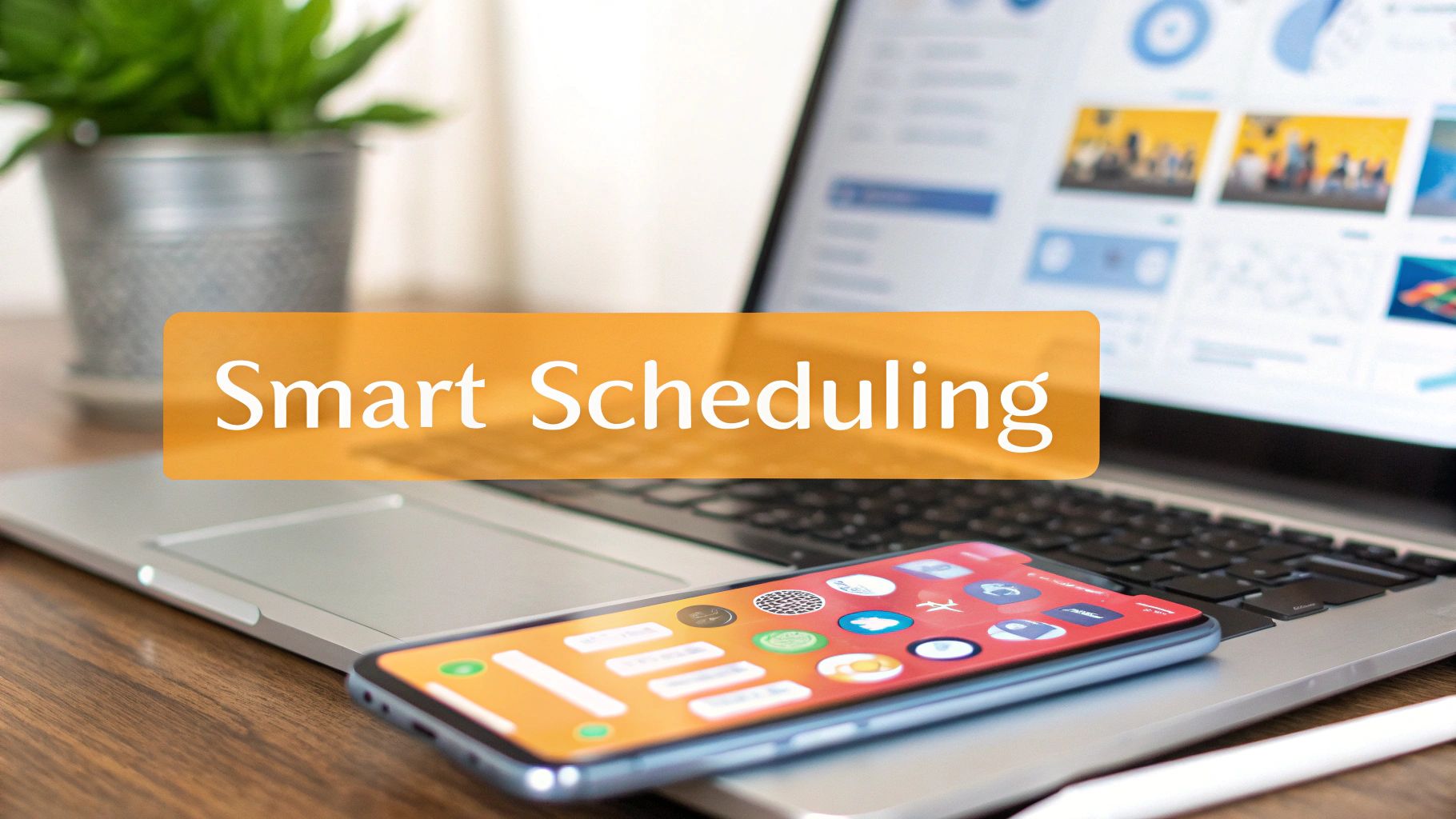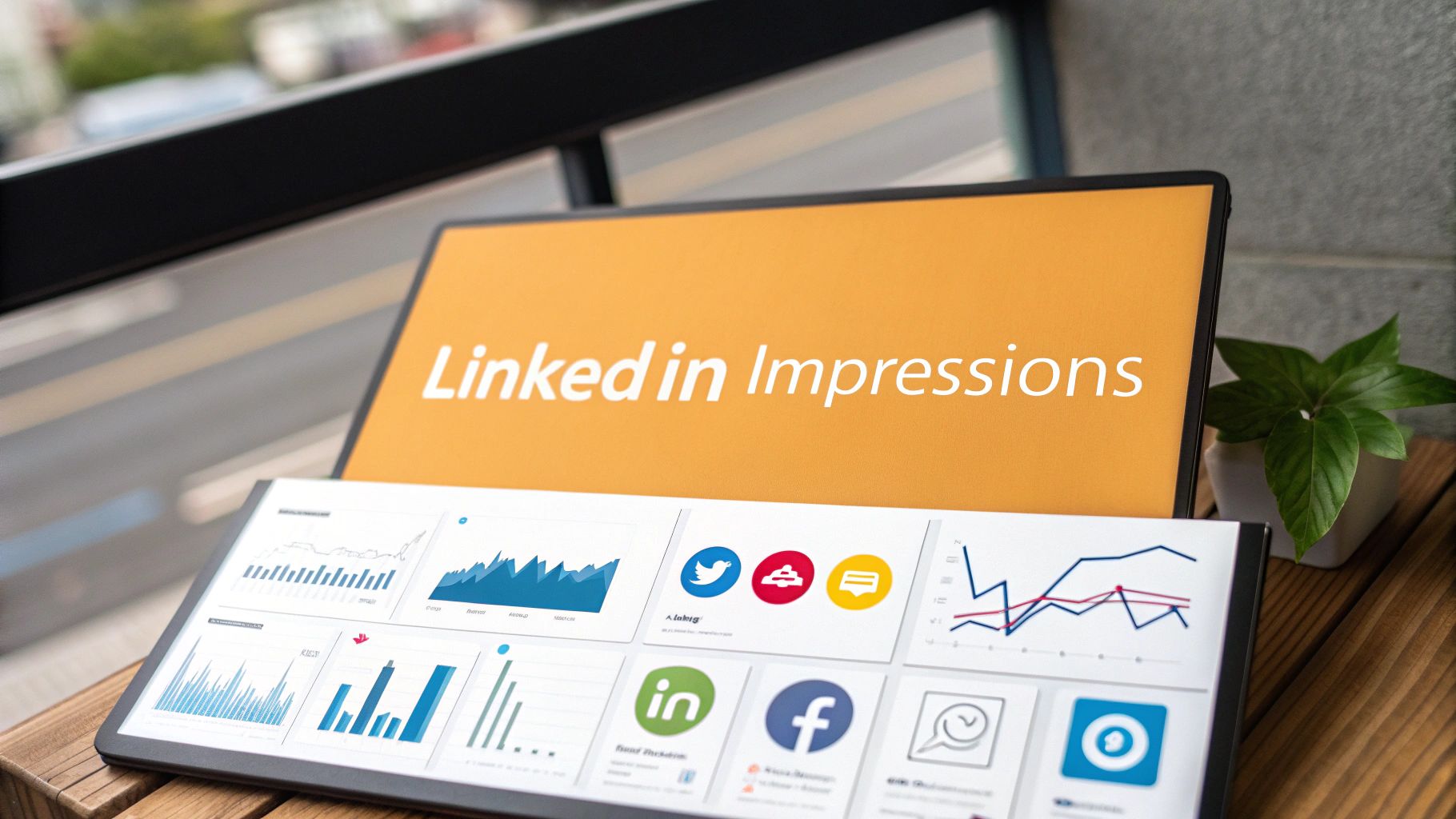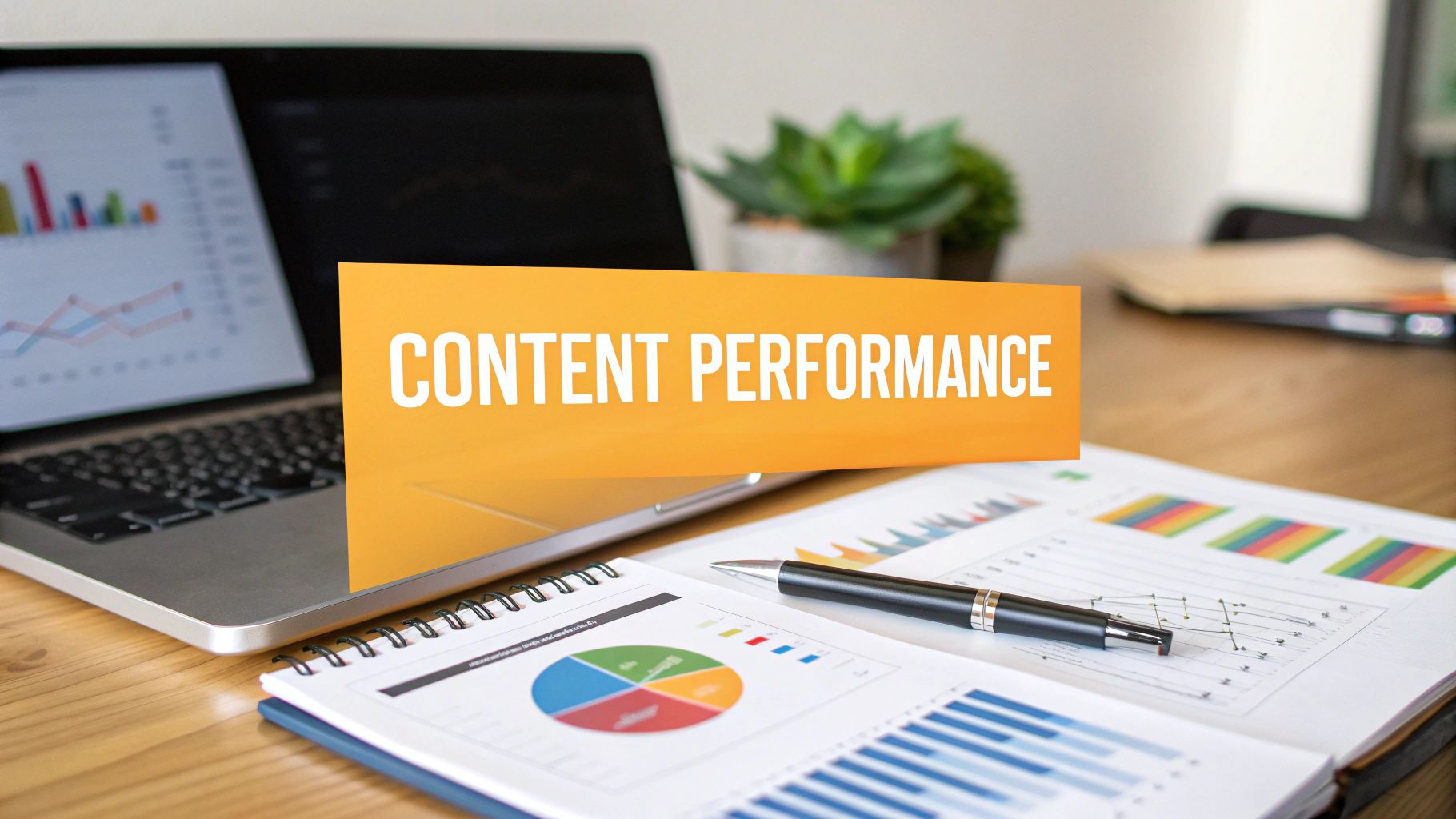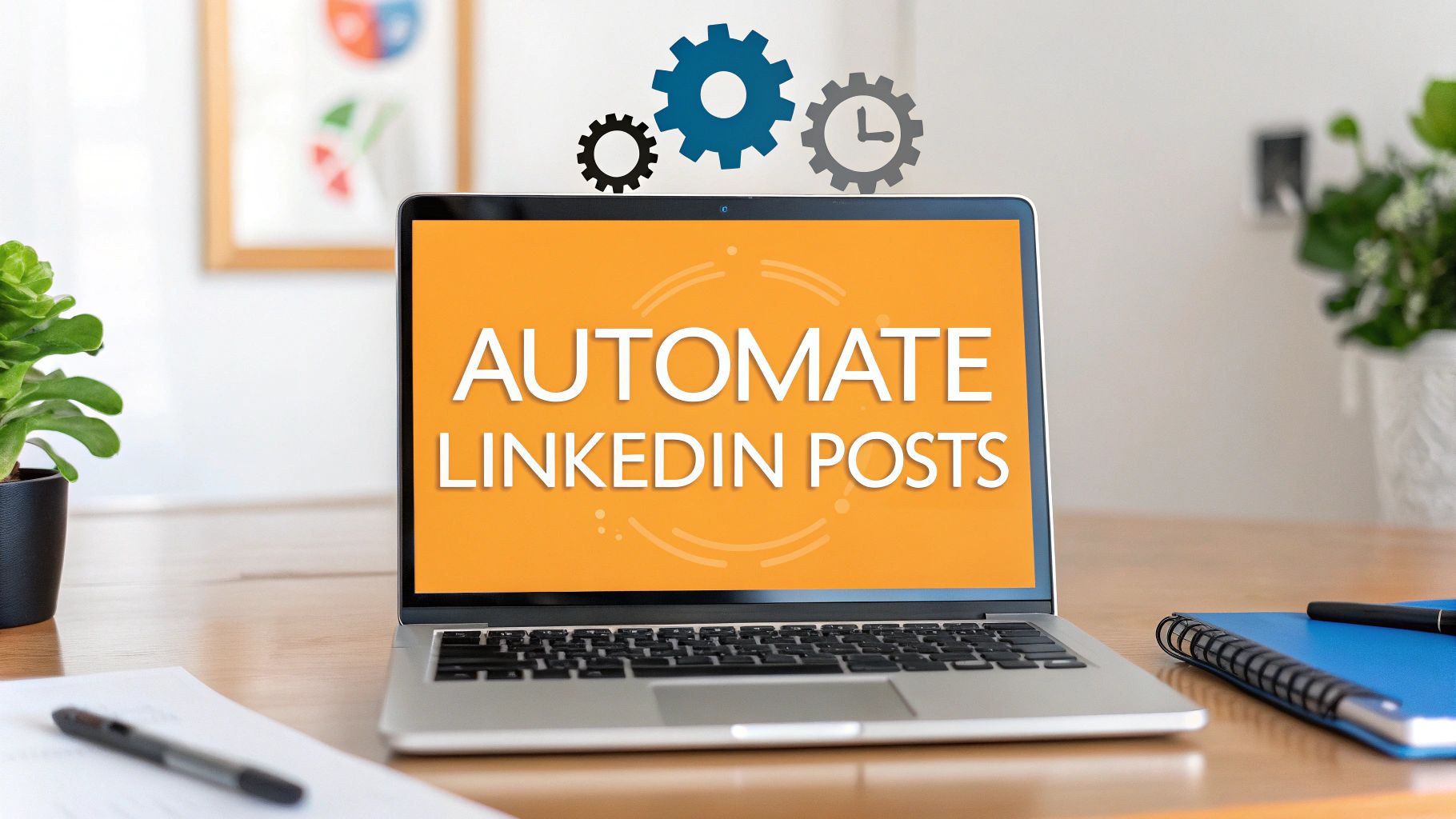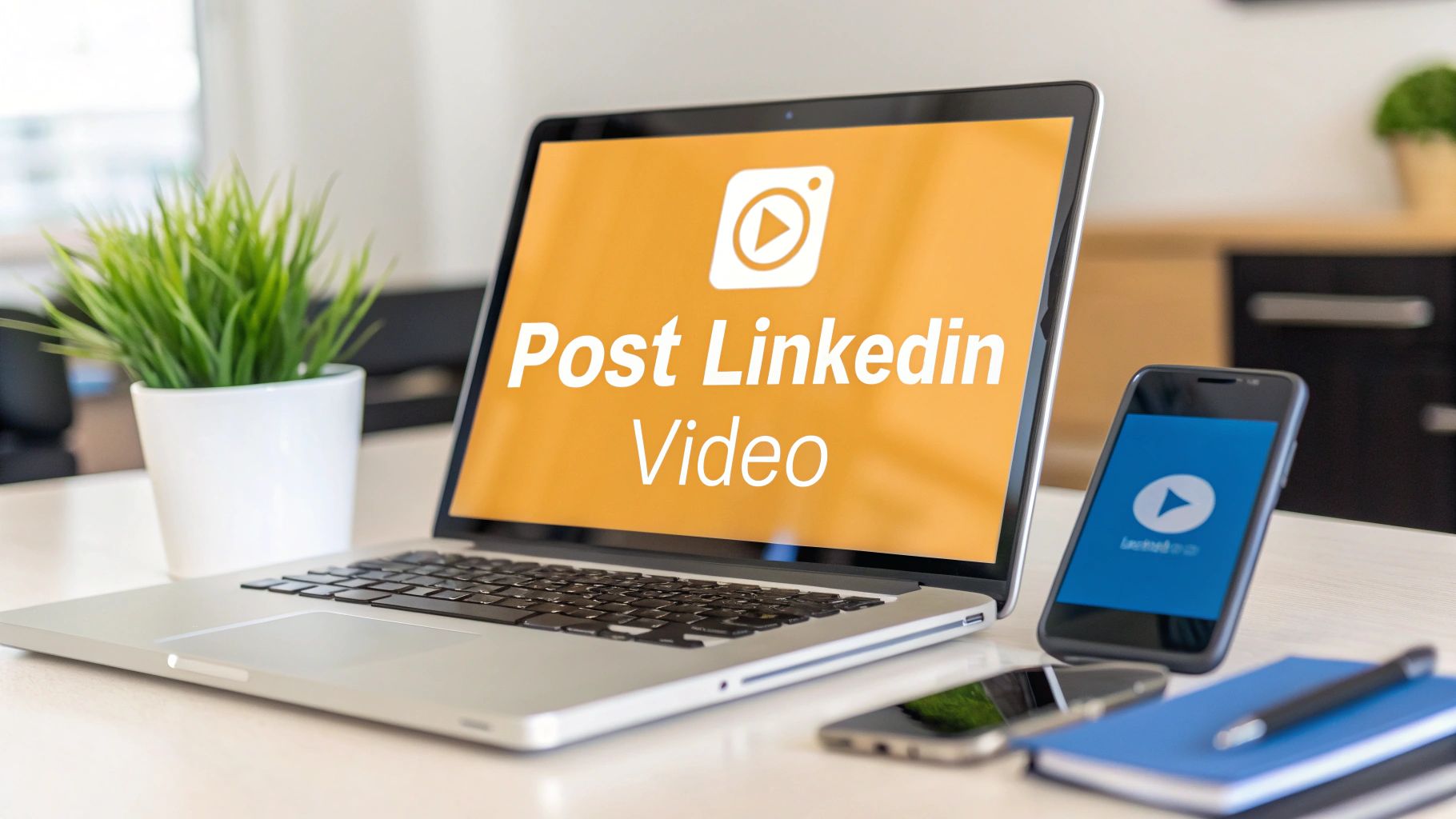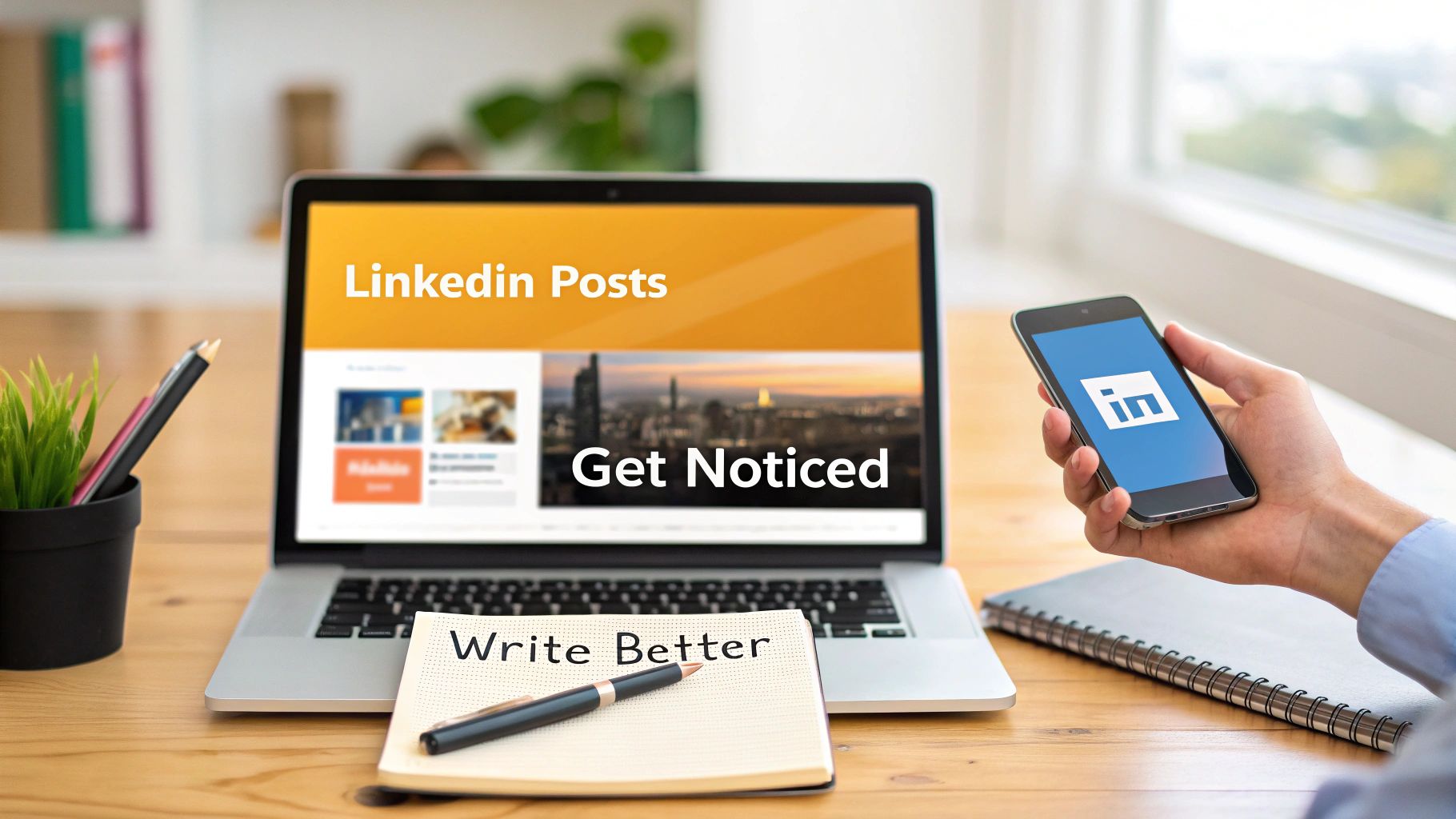Let's be honest, when you post on LinkedIn, you want people to see it. That's where impressions come in. Think of this metric as the simplest, most straightforward measure of your content's visibility.
It's the digital equivalent of someone walking past a shop window. Every single time your post shows up on someone's screen—whether they scroll right past it or stop to read—that's one impression.
So, What Exactly Are LinkedIn Impressions?
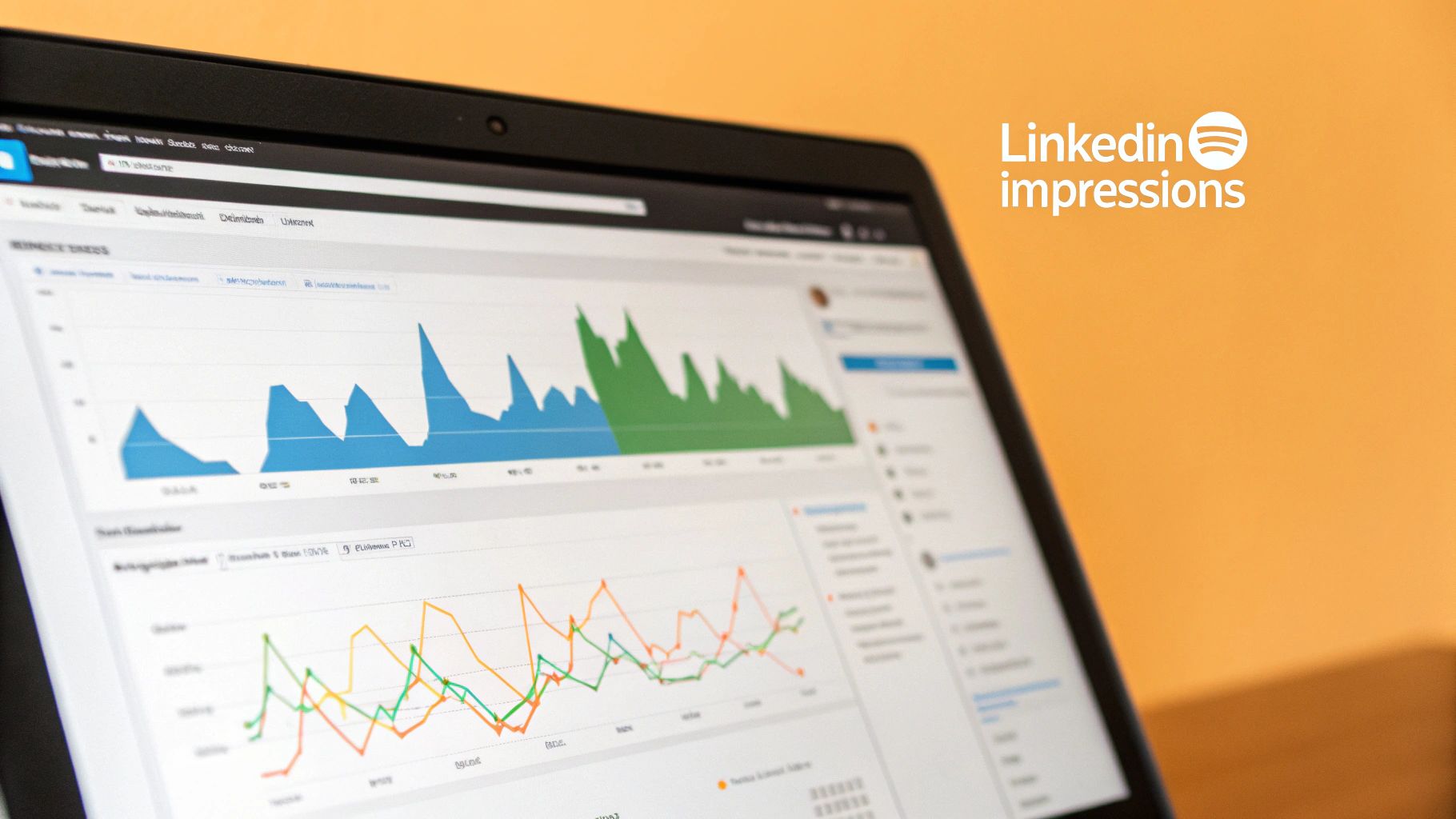
When you check your post analytics and see that 'impressions' number, you're looking at the total times your update has been served to users in their feed. It's the very first step in the engagement ladder. After all, nobody can like, comment on, or share your post if they never see it in the first place.
Imagine you've launched a new product. Impressions are like the total number of eyeballs that saw your ad in a magazine. A high number means your ad was placed in a popular publication that lots of people flipped through. It doesn't mean they all bought your product, but it proves you got it in front of them.
Impressions Aren't the Whole Story
It's super common to get impressions mixed up with other metrics like reach or views. They sound similar, but they tell you very different things about your content's journey. Getting this right is key to actually understanding what your analytics are telling you.
If you're just getting started with the platform, our guide on LinkedIn basics can help build a solid foundation.
To clear things up, let's create a quick comparison table to see how impressions stack up against other common metrics.
LinkedIn Metrics at a Glance
| Metric | What It Measures | Why It Matters for You |
|---|---|---|
| Impressions | The total number of times your content was shown to users. One person seeing it 5 times equals 5 impressions. | Shows the overall visibility and frequency the algorithm is giving your content. |
| Reach | The number of unique people who saw your content. That same person seeing it 5 times only equals 1 reach. | Tells you how many individual people your content has touched, measuring your audience size. |
| Views | Primarily for video; counts when someone watches for a minimum duration (usually 3 seconds). | Indicates that someone didn't just see your video but actually started watching it. |
This table makes it easy to see that while all these metrics are related, they each offer a unique piece of the puzzle. Impressions are about volume, reach is about audience size, and views are about initial engagement with specific media.
Impressions are the bedrock of your content's performance on LinkedIn. They measure opportunity. Without a solid number of impressions, your chances of getting those coveted likes, comments, and shares are slim to none.
Essentially, impressions tell you how hard the LinkedIn algorithm is working to show your content to people. While other metrics will tell you if people liked what they saw, impressions tell you if they even had the chance to see it at all. It's all about quantity, which sets the stage for quality engagement later on.
So, Why Should You Care About Impressions?
Let's be real, impressions can feel like a "vanity metric." Just a number showing how many times your post popped up on a screen. But trust me, they’re the bedrock of your entire LinkedIn game.
Think of it like this: impressions are the digital version of foot traffic past your store. If nobody's walking by your window, how will they ever step inside to see what you're all about? It's the same deal on LinkedIn.
When your content consistently shows up in people's feeds, you're building brand awareness. It's that simple. You stay top-of-mind, which is the first, crucial step to getting people to know, like, and trust you. After all, they can't get to know you if they never see you in the first place.
Laying the Groundwork for Visibility
Impressions are your earliest clue about how a post is performing. Long before the likes and comments start trickling in, that impression count gives you a quick thumbs-up or thumbs-down on its initial reach. It’s your first sign that the LinkedIn algorithm has noticed you and is pushing your content out.
Every other metric you care about hinges on this one. You can't get a click on a link no one sees. You won't get a comment on a post no one reads. Every single meaningful action starts with an impression.
Without impressions, engagement is dead on arrival. Every click, comment, and conversion begins with your content appearing on someone's screen. It's the first and most critical step in your content's journey.
Seeing your name or company pop up again and again next to smart insights creates a powerful effect. People start to connect you with expertise in your field. This is how you build a rock-solid professional brand, one impression at a time.
The Opportunity in a Busy Feed
Getting seen on LinkedIn is both a huge challenge and a massive opportunity, thanks to how active the platform is. The sheer number of people scrolling their feeds every day is what fuels the potential for your posts to take off.
As of 2025, LinkedIn has around 134.5 million people logging in every single day. That's a staggering 16.2% of its total members. And nearly half (48.5%) are active at least once a month. This creates an incredibly lively space for content. You can dive deeper into LinkedIn's user activity to see just how much potential is out there.
At the end of the day, a healthy stream of impressions means your content strategy is alive and kicking. It confirms you’re showing up, being active, and reaching the very people you want to connect with. That consistent presence is what turns a static profile into a powerful, influential brand.
How LinkedIn Actually Counts an Impression
So, what really makes that impression number tick up on your LinkedIn posts? It’s not just someone mindlessly scrolling past your content. LinkedIn has a pretty specific rule for what counts as a real view, which is good because it gives the metric some actual weight.
An impression is officially logged when at least 50% of your post is visible on someone's screen for a minimum of 300 milliseconds. This rule applies whether they're on their computer or phone. It’s a split second, sure, but it’s just long enough to confirm your content was genuinely on the screen, not just a blur in their feed.
And here’s a fun fact: this includes your own views. Yep, every time you go back to admire your own post, you're adding to the impression count. One view from you won't make a huge difference, but it's a common myth that your own activity is totally ignored.
This infographic lays out some of the key pieces that help your posts get seen and rack up those impressions.
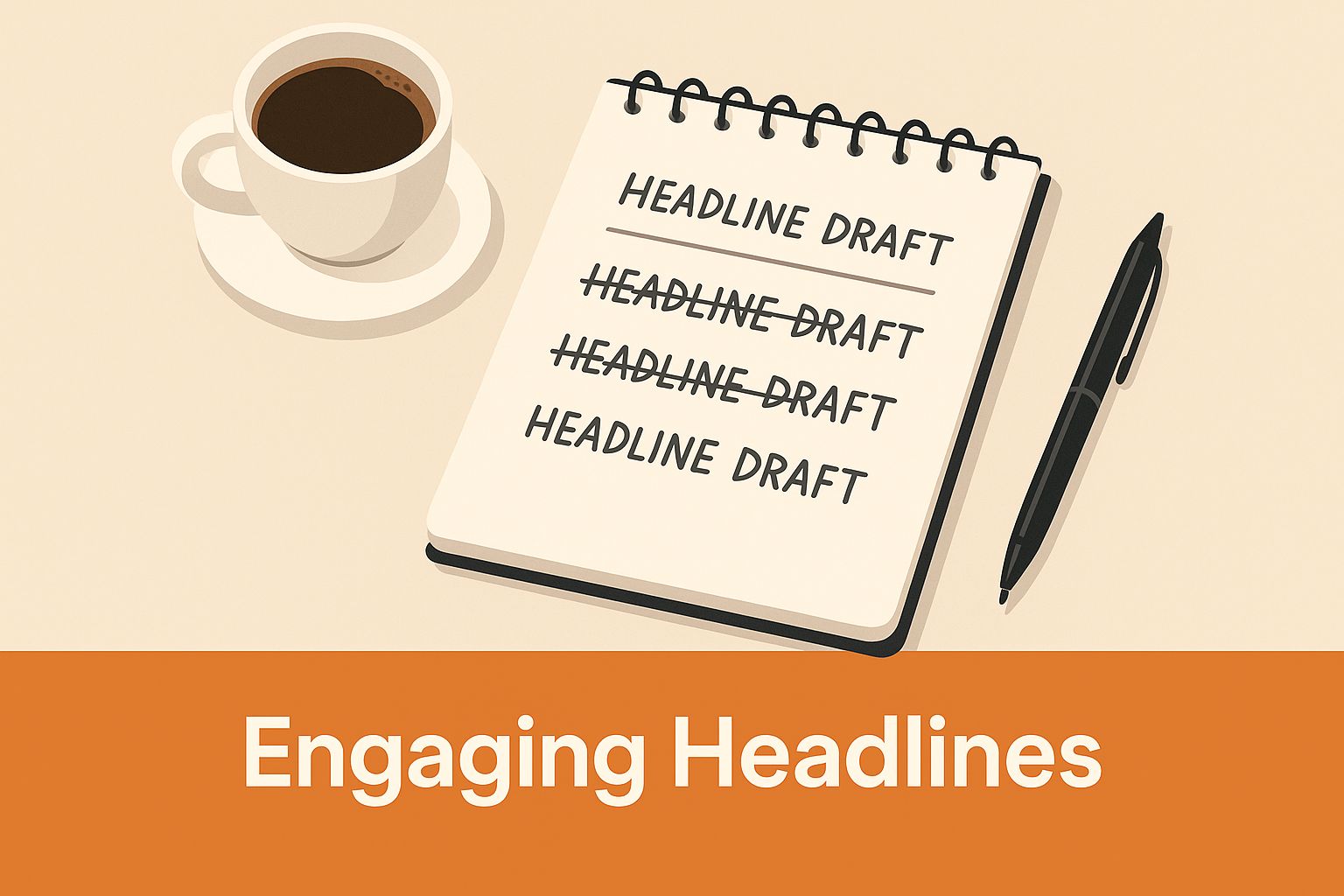
As you can see, something as simple as a strong headline is the first step to grabbing the attention you need for an impression to even happen.
The Three Flavors of Impressions
It’s important to know that not all impressions are the same. Where the view comes from tells you a ton about how your content is performing and how the LinkedIn algorithm feels about it. Getting a handle on the different types is key to making sense of your analytics.
You'll come across three main kinds of impressions on LinkedIn:
- Organic Impressions: Think of these as your home base. They’re views from your direct network—the people who follow you and your first-degree connections. They see your stuff in their feed because they chose to.
- Viral Impressions: This is where things get exciting. Viral impressions happen when people outside your network see your post. How? Because someone in your network liked, commented on, or shared it, pushing it into their own network's feed. A high number here means your content is really hitting the mark.
- Paid Impressions: Just like it sounds, these are the views you pay for. When you run a sponsored ad campaign, you’re paying to put your post directly into the feeds of a specific, targeted audience.
The real magic on LinkedIn happens when your organic activity sparks that viral growth. A single, insightful comment from one of your followers can suddenly blast your post out to thousands of new people. That's how a humble organic impression can catch fire and turn into a wave of viral ones.
Each type has its own job. Organic impressions nurture your community. Viral impressions blast your reach to new heights. And paid impressions guarantee you get in front of the exact people you want to see your content. To really get a grip on your content strategy, you have to understand the quirks of the LinkedIn algorithm and how it decides who sees what, and when.
Proven Strategies to Get More LinkedIn Impressions
Knowing what impressions are is the easy part. Actually getting more of them? That’s where the real fun begins. Pushing your content in front of more people isn't about getting lucky; it's about having a smart, consistent game plan that tells the LinkedIn algorithm your stuff is worth seeing.
Boosting your impressions on LinkedIn really boils down to a mix of killer content, smart timing, and real, human interaction. Let’s walk through the exact steps you can take to get those numbers moving up and make sure your hard work pays off.
Create Content That Actually Helps People
Want to be invisible on LinkedIn? Post generic, "buy my stuff" content. The fastest way to get noticed, on the other hand, is to create posts that solve a real problem, offer a fresh take, or teach your audience something they didn't know. Put yourself in their shoes: what are their biggest headaches? Create content that’s the aspirin.
When you post something that's genuinely helpful, people can't help but engage. That first wave of likes and comments is a massive signal to the algorithm to start showing your post to more people, kicking off a chain reaction that sends your impressions soaring.
The secret to a high-impression strategy isn't about trying to trick the algorithm. It's about generosity. When you share what you know and help others succeed, the platform—and your audience—will reward you with more visibility. Every time.
Don't get stuck in a rut with your content formats, either. Sticking to text-only posts is a missed opportunity. Play around with different types to see what clicks with your audience and keeps your feed from getting stale.
A big part of a successful content strategy is choosing the right format for the job. Some types are just naturally better at grabbing attention and encouraging the algorithm to share them widely.
Here’s a quick look at some formats that are proven to boost impressions.
Content Formats That Boost Impressions
| Content Format | Best For Driving... | Pro Tip for More Impressions |
|---|---|---|
| Carousel Posts (PDFs) | Engagement & Dwell Time | Break down a complex topic into simple, visual slides. Make the first slide a bold, scroll-stopping headline. |
| Native Video | Connection & Engagement | Keep it short (under 90 seconds). Add captions, since most people watch with the sound off. |
| Multi-Image Posts | Visual Storytelling & Data | Posts with multiple images see a 6.6% average engagement rate. Use them to show a before-and-after or break down data visually. |
By mixing these formats into your routine, you keep things interesting for your audience and give the algorithm more reasons to show your content to new people.
Engage Before and After You Post
Your job isn't over when you hit that "Post" button. In fact, what you do in the minutes right before and after can make or break your reach.
Before you share your own content, spend about 15-20 minutes warming up the algorithm. Jump into your feed and engage with what other people are posting. Don't just "like" things—leave thoughtful comments and start conversations. This gets your name out there and signals to LinkedIn that you're an active member of the community.
Once your post is live, stick around! Replying to comments as soon as they appear is one of the strongest signals you can send. It shows that your post is sparking a real discussion, which encourages the platform to push it into more feeds. A simple "thanks" is fine, but a reply with a follow-up question is even better for keeping the momentum going.
Time Your Posts and Use Hashtags Wisely
Timing can make a huge difference. You want to post when your audience is actually online and ready to engage. While the general rule of thumb is Tuesday through Thursday mornings, your specific audience might have different habits. The only way to know for sure is to experiment. Test out different days and times, and check your analytics to find your own personal sweet spot.
Hashtags are your ticket to reaching people beyond your existing network. The key is to use a strategic mix of 3-5 relevant hashtags per post.
- Broad Hashtags: Think big, like #Marketing or #Leadership. These have massive followings and can give you a quick burst of initial impressions.
- Niche Hashtags: Get specific with tags like #B2BContentStrategy or #SaaSMarketing. These connect you with a smaller but much more relevant audience that's more likely to engage.
Pulling all these strategies together creates a powerful system for consistently boosting your impressions on LinkedIn. If you want to see how these tactics look in the wild, check out these Top LinkedIn Ads Examples from campaigns that totally nailed it.
Just remember, consistency is everything. Make these practices part of your weekly routine, and you’ll start to see your visibility grow.
How to Analyze Your Impressions in LinkedIn Analytics
If you want to create smarter content, you have to know your numbers. Diving into your LinkedIn Analytics isn't about drowning in data; it's about finding the story your performance is trying to tell you. Think of this dashboard as your command center for figuring out what's a hit and what's a miss.
You can pull up impression data for individual posts or your page as a whole. The real magic, though, happens when you start spotting trends. Did a certain post suddenly spike in views? Was it a video, a text-only update, or maybe a carousel? Pinpointing these patterns is the first step to making that lightning strike twice.
Finding Your Impression Data
Thankfully, LinkedIn doesn't make you hunt for this info. Whether you're looking at your personal profile or a company page, the numbers you need are just a couple of clicks away.
For any specific post, just click the little analytics icon right below your content. That click pops open a detailed view with all the key stats for that update.
Here’s a peek at what that post analytics dashboard looks like, with the impressions count front and center.
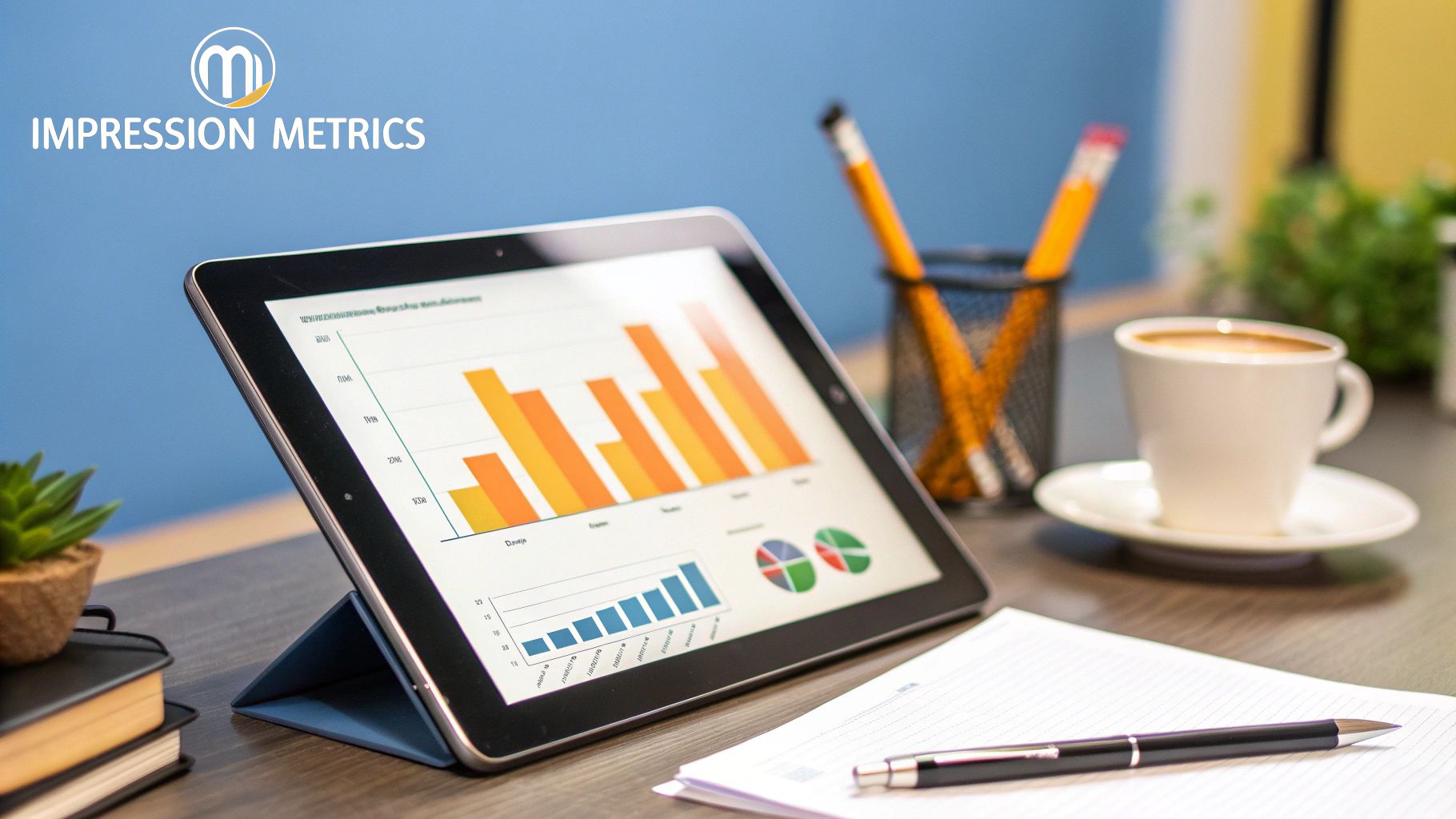
This quick snapshot immediately shows you how many eyeballs have been on your post—it's your go-to metric for visibility.
Interpreting the Numbers
Okay, so you’ve got the data. Now the real work begins. A big impression count is great, but what does it actually mean for your strategy? You’ve got to add some context to see the whole picture.
Never look at impressions in a vacuum. You absolutely have to compare this number with your engagement. For instance, a post with 10,000 impressions but only 10 likes tells a very different story than a post with 2,000 impressions and 200 likes. That second post clearly hit home with the audience it reached.
The goal isn't just to be seen; it's to be remembered. Analyzing your impressions alongside engagement metrics like comments and shares helps you distinguish between fleeting visibility and genuine impact.
Use your analytics to start asking better questions that guide what you create next.
- Which topics consistently get the most views? This is a dead giveaway for what your audience wants to learn from you.
- Do videos get more impressions than text posts? This helps you figure out where to pour your creative energy and budget.
- What time of day do my posts get the biggest initial boost? A little insight here can help you tweak your posting schedule for maximum reach.
By making a habit of checking your analytics, you stop guessing and start making smart, data-backed decisions. This is a core part of learning how to measure content performance like a pro. It turns your analytics from a simple report card into a strategic roadmap for what comes next.
Moving Beyond Impressions to Metrics That Drive Results
Getting a ton of impressions on LinkedIn feels great, doesn't it? It means your content is popping up in people's feeds. But here’s the thing: visibility is just the first step. To actually grow your business or personal brand, you need to look at what happens after someone sees your post.
Think of it like a funnel. Impressions are the wide mouth at the top, catching all the initial attention. That's a crucial start, but the real magic happens when you guide that audience deeper, inspiring them to take actions that show they're truly connecting with what you have to say.
From Views to Value
Instead of just chasing a big impression number, it's time to pair it with metrics that tell a richer story. These are the numbers that show genuine interest and intent, revealing the true impact of your content.
Here are the key metrics that really matter:
- Click-Through Rate (CTR): This tells you how many people who saw your post actually clicked on your link. A strong CTR is a clear sign that your hook and call-to-action are compelling.
- Engagement Rate: This is the cocktail of likes, comments, and shares. A post might have fewer impressions but a sky-high engagement rate, which often means it's making a much bigger impact on a core audience.
- Follower Growth: Are your viral posts turning viewers into followers? If people see your content and immediately hit "follow," you know you're attracting the right crowd.
Turning Impressions into Action
At the end of the day, the best impressions are the ones that lead to something more. This is where a crystal-clear call-to-action (CTA) becomes your secret weapon. You have to spell out exactly what you want your audience to do next.
An impression earns you a moment of attention; a great call-to-action converts that moment into momentum for your business. Don't just be seen—be a catalyst for action.
Your CTA doesn't have to be some aggressive sales pitch. It can be as simple as asking a thought-provoking question to get a conversation started in the comments, pointing people to your latest article, or inviting them to connect.
Each of these small actions transforms a passive scroller into an active participant, nudging them one step closer to becoming a client, a partner, or a dedicated fan.
Got Questions About LinkedIn Impressions? Let's Clear Things Up.
Diving into LinkedIn's analytics can feel like trying to read a foreign language at first. Let's break down some of the most common questions about LinkedIn impressions so you can read your data like a pro.
Impressions vs. Reach: What’s the Real Difference?
This is the one that trips everyone up. Honestly, it’s simpler than it sounds.
Think of it like a billboard on a highway. Impressions are the total number of times your billboard (your post) was seen by passing cars. If one car drives past it five times throughout the week, that’s five impressions.
Reach is the number of unique cars that saw it. That car that drove by five times? It only counts as one in your reach total. So, reach tells you how many unique people saw your stuff.
Impressions are about frequency—how often your content is showing up. Reach is about your unique audience size—how many individual eyeballs landed on your post. They both tell an important part of the story, but it's not the same story.
"Why Are My LinkedIn Impressions So Low?"
Staring at a low impression count is a bummer, but don't worry, it's almost always something you can fix. The usual suspects? You might not be posting consistently, your content isn't hitting the mark, or you're not really engaging with anyone else on the platform.
The fix starts with creating content that genuinely helps your audience. What problems can you solve for them? Once you have that, get into a consistent posting rhythm. Also, be smart with your hashtags—a good mix of 3-5 relevant ones works wonders. Finally, don't just post and ghost! Spend some time leaving real, thoughtful comments on other people's posts. It's one of the best ways to get your own profile seen.
And that little question that’s probably nagging you: do your own views count? Yep, they sure do. Every time you check out your own post, LinkedIn adds one to the impression count.

